Макиавелли Николай. Государь (Il Principe) и Рассуждения на первые три книги Тита Ливия. Пер. c итал. Н. Курочкина. Издание "Русской книжной торговли". - СПб.; тип. Тиблена и Ко. (Неклюдова), 1869. - 502 стр.
-
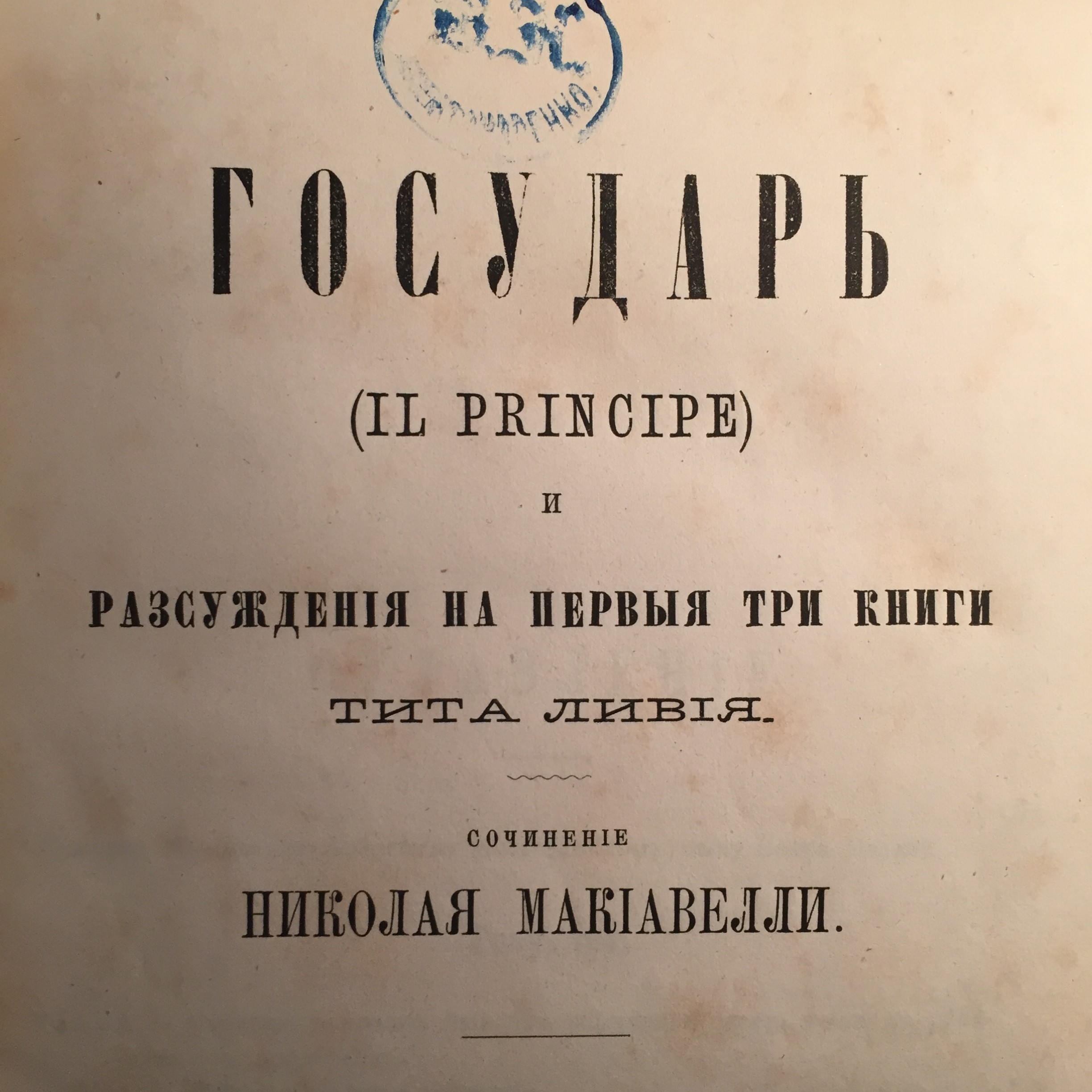
-
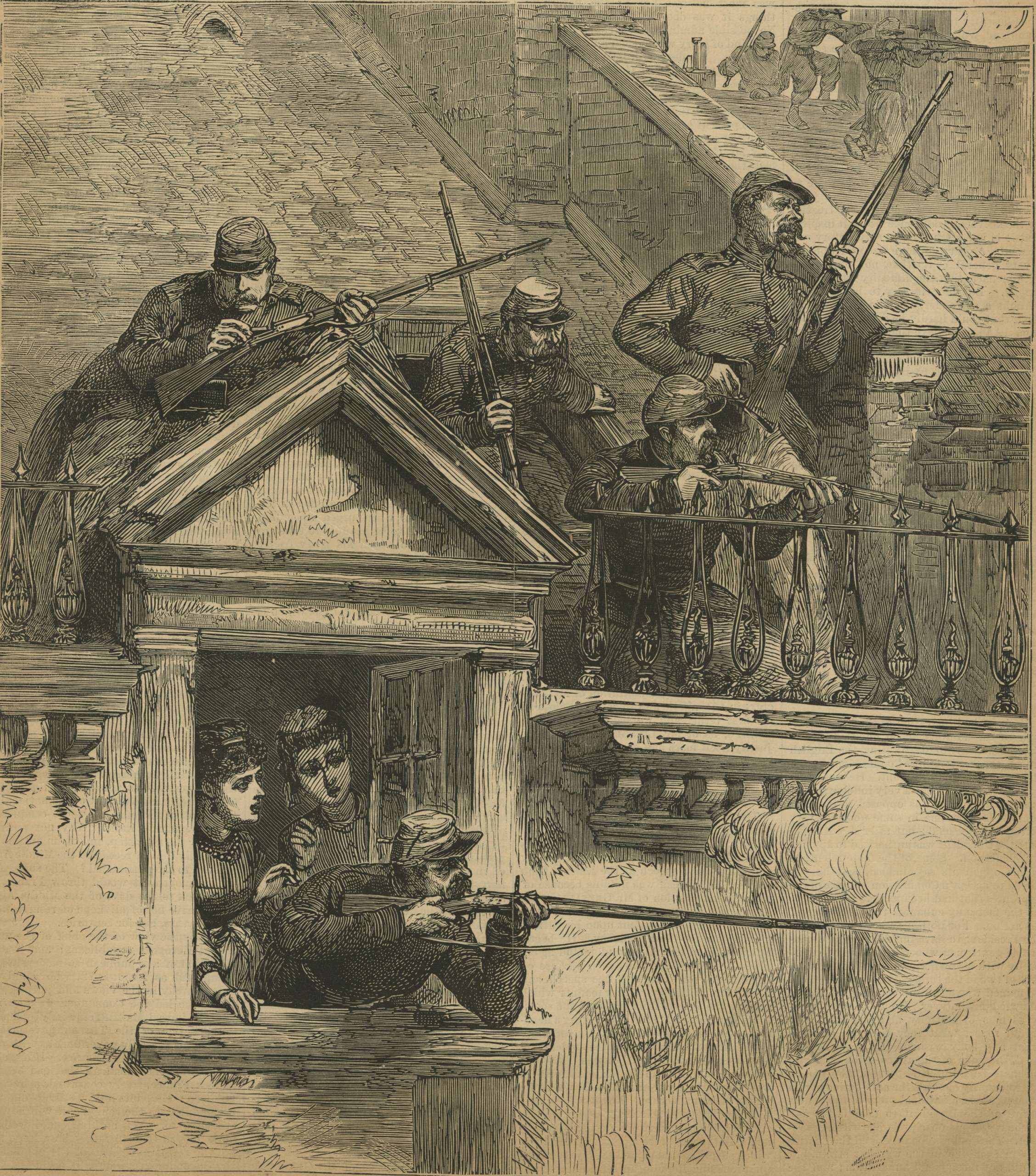
-
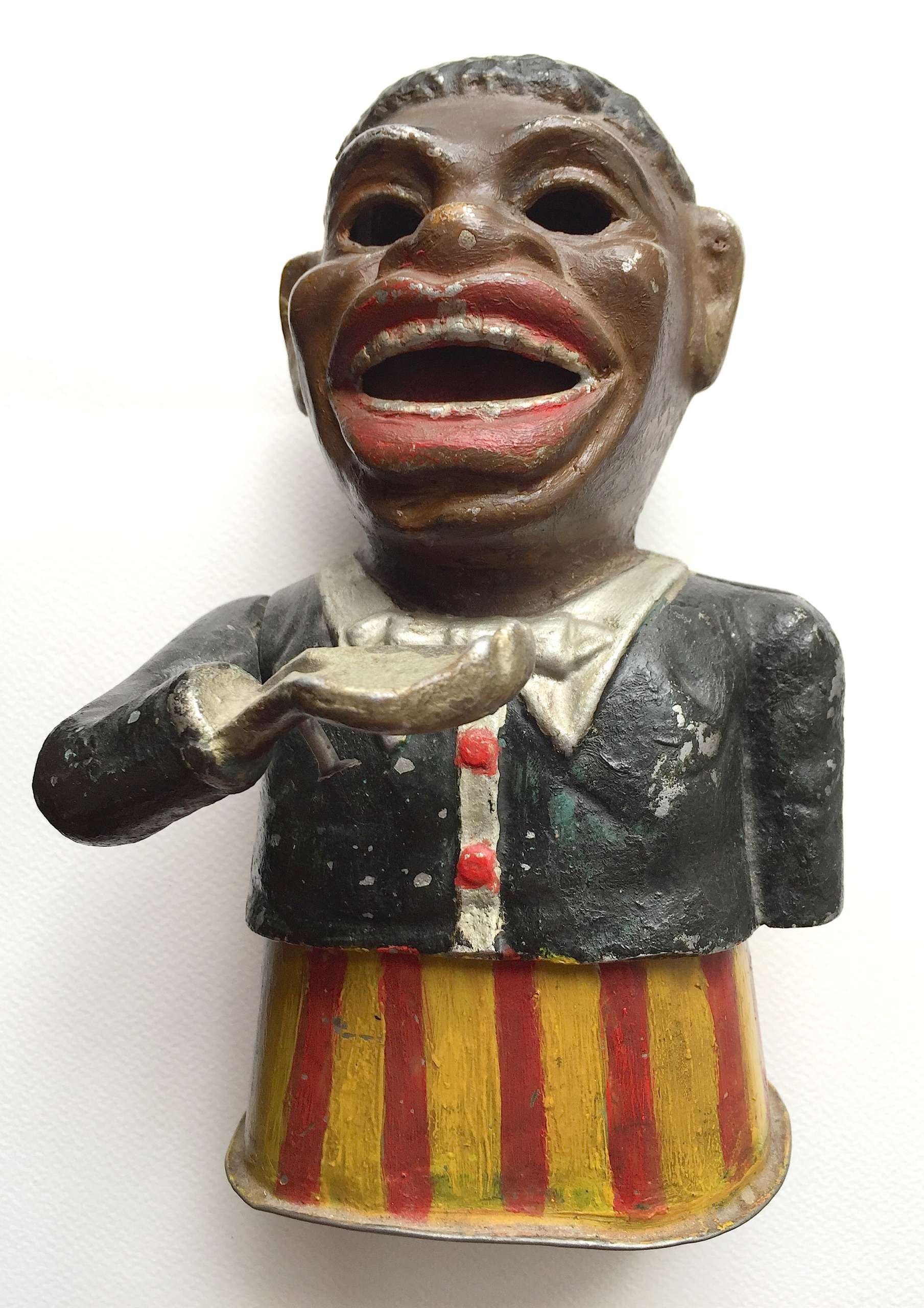 A cast iron painted 19th century style money box in the form of a negro, the arm articulated to insert coins.
A cast iron painted 19th century style money box in the form of a negro, the arm articulated to insert coins. -
 Iron tsuba of round form with design of butterfly (left) and dragonfly (right) in openwork (sukashi), outlined with brass wire. Thin plate also decorated with five concentric circular rows of brass dots (nail heads) in ten-zōgan; brass wire outlines of the center of the plate. School: Ōnin ten-zogan. Late Muromachi period, 16th century. Diameter: 88 mm, thickness at seppa-dai: 3.1 mm. Another tsuba of similar design, Tōshō school, is illustrated in this collection; see TSU-0353.Reference to the design has been found at "Japanese Swords and Tsuba from the Professor A. Z. Freeman and the Phyllis Sharpe Memorial collections". Sotheby's, London, Thursday 10 April 1997; p. 18, item 37: "pierced with two large formalised butterflies...".
Iron tsuba of round form with design of butterfly (left) and dragonfly (right) in openwork (sukashi), outlined with brass wire. Thin plate also decorated with five concentric circular rows of brass dots (nail heads) in ten-zōgan; brass wire outlines of the center of the plate. School: Ōnin ten-zogan. Late Muromachi period, 16th century. Diameter: 88 mm, thickness at seppa-dai: 3.1 mm. Another tsuba of similar design, Tōshō school, is illustrated in this collection; see TSU-0353.Reference to the design has been found at "Japanese Swords and Tsuba from the Professor A. Z. Freeman and the Phyllis Sharpe Memorial collections". Sotheby's, London, Thursday 10 April 1997; p. 18, item 37: "pierced with two large formalised butterflies...".
TSU-0353: Tōshō tsuba, Muromachi period.

A kamakura-bori tsuba. Momoyama period. Freeman & Sharpe Memorial Collections.
-
 Iron tsuba of round form with circular iron wire fastened to the surface with iron and brass staples (mukade-zōgan); brass ring about 2.5 mm wide along the rim with chisel marks. Design repeats on the reverse. Copper sekigane. Early Edo, 17th century. Size: Height: 83.3 mm; width 83.9 mm; thickness at seppa-dai: 4.5 mm. Weight 173.6 g. Design is thought to resemble a centipede. "Centipede-like inlay (mukade zogan) of alternating iron and brass staples produce an appearance that was particularly favored by Takeda Shingen (1521-1573), one of the most powerful warlords of his time. The centipede is sacred to Bishamon (God of War) and especially propitious for a warrior. Shingen type, 16th century.” [The Peabody Museum collection of Japanese sword guards with selected pieces of sword furniture, by John D. Hamilton. Photographs by Mark Sexton. Salem, MA, 1975.] See also: http://varshavskycollection.com/shingen-tsuba/ SOLD
Iron tsuba of round form with circular iron wire fastened to the surface with iron and brass staples (mukade-zōgan); brass ring about 2.5 mm wide along the rim with chisel marks. Design repeats on the reverse. Copper sekigane. Early Edo, 17th century. Size: Height: 83.3 mm; width 83.9 mm; thickness at seppa-dai: 4.5 mm. Weight 173.6 g. Design is thought to resemble a centipede. "Centipede-like inlay (mukade zogan) of alternating iron and brass staples produce an appearance that was particularly favored by Takeda Shingen (1521-1573), one of the most powerful warlords of his time. The centipede is sacred to Bishamon (God of War) and especially propitious for a warrior. Shingen type, 16th century.” [The Peabody Museum collection of Japanese sword guards with selected pieces of sword furniture, by John D. Hamilton. Photographs by Mark Sexton. Salem, MA, 1975.] See also: http://varshavskycollection.com/shingen-tsuba/ SOLD -
 Kitagawa Utamaro. According to Chris Uhlenberg this is an illustration from the book Ehon koi no Onamaki, 3 vols, published in Kansei 11 (1799). Illustrated in b/w in: Hayashi Yoshikazu: Kitagawa Utamaro, in the series: Edo makura-e shi shusei, published in 1990, reissued 1994. Size: Chuban (25.5 x 18.5 cm), two book pages glued together.
Kitagawa Utamaro. According to Chris Uhlenberg this is an illustration from the book Ehon koi no Onamaki, 3 vols, published in Kansei 11 (1799). Illustrated in b/w in: Hayashi Yoshikazu: Kitagawa Utamaro, in the series: Edo makura-e shi shusei, published in 1990, reissued 1994. Size: Chuban (25.5 x 18.5 cm), two book pages glued together. -
 [SOLD]
[SOLD]Iron tsuba of slightly elongated round form carved and inlaid in gold and shibuichi with a long-armed monkey hanging from a pine tree branch reaching for the reflection of a crescent moon in the stream. A pine tree carved with details inlaid in gold on the reverse. The design seems to be inspired by Kaneie work (Compton III, p. 10, №6a; Tsuba no bi, 1947, p. 33, №56).
Dimensions: 76.8 x 74.2 x 3.6 mm. Mid-Edo period. Unsigned.
Compton III, p. 10, №6a

Tsuba no bi, 1947, p. 33, №56.
-
 Iron tsuba of oval form with the motif of horse trappings in openwork (sukashi). Copper sekigane. Iron bones (tekkotsu) on the rim.
Iron tsuba of oval form with the motif of horse trappings in openwork (sukashi). Copper sekigane. Iron bones (tekkotsu) on the rim.Size: 80.4 x 75.8 x 5.2 mm
NBTHK Certificate №454567, allegedly saying that it is Akasaka School, Muromachi period. A look-a-like tsuba in Robert. E. Haynes Catalog #7, 1983 on page 57 under №48 is described as follows: "A masterpiece second period Owari sukashi tsuba. The plate is of beautiful color and quality almost like velvet. The design is very hard to discern, it might be the horse trappings, or even a moon. The style and type of Owari tsuba shows the great tradition of the Momoyama period and why it was the renaissance in time, as well as the arts produced, through the long history of all Japanese art. Ca. 1580. Ht. 7.7 cm, Th. (center) 5.5 mm, (edge) 5.25 to 5.75 mm."I believe we can safely attribute this tsuba to Owari School, c. 1580.
Robert. E. Haynes Catalog #7, 1983, p. 57, №48.
-
 Isoda Koryūsai (礒田 湖龍斎, 1735–1790), flourished: 1769 to 1790. The print lacks signature (signature erased).
Isoda Koryūsai (礒田 湖龍斎, 1735–1790), flourished: 1769 to 1790. The print lacks signature (signature erased).Attributed definitely to Koryūsai: Jacob Pins, #491 [p.202] - Saigyo Hoshi admiring Mount Fuji. Signature erased but convincingly attributed to Koryusai. Tikotin Museum, Haifa. Catalogue raisonné: Allen Hockley: A3-J-5 (p. 261).
Saigyō Hōshi (西行 法師, 1118 – March 23, 1190) was a famous Japanese poet of the late Heian and early Kamakura period. -

Iron tsuba of round form with brown patina decorated with the design of a Buddhist temple bell (tsurigane) in openwork (sukashi), with details outlined in brass wire (sen-zōgan), the outer ring decorated with two rows of brass dots (ten-zōgan), and the bell details carved in sukidashi-bori as on kamakura-bori pieces.
Ōnin school. Unsigned. Late Muromachi period, 16th century. Dimensions: 88.8 x 88.3 x 3.0 mm. As per Merrily Baird, two legends are usually associated with the image of tsurigane, a large, suspended Buddhist bell: one is that of Dojo Temple (Dojo-ji), and the other is of Benkei stealing the tsurigane of Miidera Temple. Interestingly, this type of bell (tsurigane) is not described as a family crest (mon), while suzu and hansho bells are. -

Iron tsuba with hammer marked surface and design of a plum and cherry blossoms to the right of nakaga-ana in openwork (sukashi). Raised rim, typical to katchushi school. The thickness of the plate provides for later Muromachi period making.
Late Muromachi period (1514-1573). Size: 85.8 x 85.0 x 3.6 (center), 4.1 (rim) mm; weight: 136 g. -
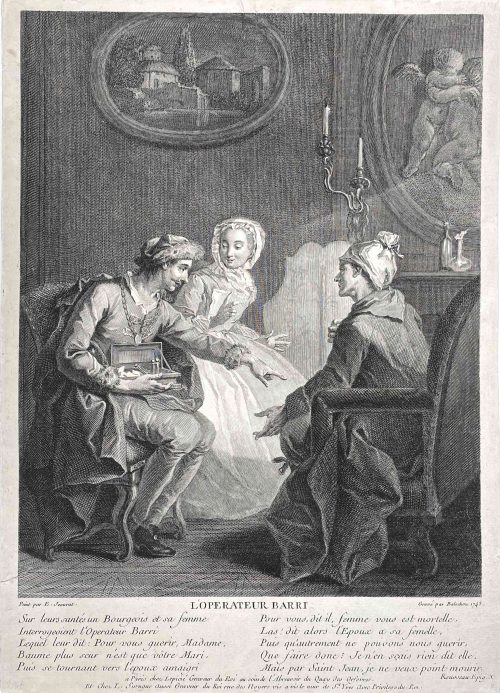
Engraving by J.J. Balechou after E. Jeaurat. A husband and wife ask a quack doctor for advice about health: he suggests substituting himself for the husband in the wife's affections, and she agrees: Épigrammes de Jean-Baptiste Rousseau (French, 1671–1741).
Date: 1743.
Size: 380 x 270 mm
Inscriptions under the image:
Top: Peint par E. Jeaurat | L'Operateur Barri | Grave par Balechou 1743
Middle: Sur leurs santés un Bourgeois et sa femme
Interrogeoient l'Operateur Barri, Lequel leur dit : Pour vous guérir, Madame, Baume plus sûr n'est que votre Mari, Puis se tournant vers l'époux amaigri, Pour vous, dit il, femme vous est mortelle, Las ! dit alors l'Epoux à sa femelle, Puis qu'autrement ne pouvons nous guérir, Que faire donc ? Je n'en sçai rien, dit elle,Mais, par Saint Jean, je ne veux point mourir.
Rousseau Epig. X
Center bottom: a Paris chez Lepicie Graveur du Roi au coin de l'Abreuvoir du Quay des Orfevres. Et Chez L. Surugue Aussi Graveur du Roi rue des Noyers vis a vis le mur de St. Yves Avec Privilege du Roi. -
 Artist: Utagawa Sadahide [歌川 貞秀], a.k.a. Gountei Sadahide [五雲亭 貞秀] (1807 – c. 1878/9). Publisher: Iseya Ichiemon [伊勢屋市右衛門] (Japanese, fl. c 1823 – 1864), seal name Kaku-Tsuji [角辻]. Signed: Gountei Sadahide ga [五雲亭貞秀画] Censor's seal: kiwame, date seal: Tenpō 3 (1832). Size: Uncut fan print (uchiwa-e); 218 x 282 mm. Portrait of a young woman dressed in a green kimono decorated with arabesque (karakusa) and flowers, her black obi adorned with a dragon, in a western-style frame, on a blue background; and a painting of a parrot on a pomegranate tree. A similar design was used by Sadahide in 1860, described in detail by Sebastian Izzard in his Japanese Prints of the Mid-Nineteenth Century: 1830–1865, September 20–October 24, 2006 exhibition: Picture of a Curio Shop in Yokohama: reverse painting on glass of a crimson parrot, coloured copperplate engraving of a mother and child (Yokohama urimono mise no zu: gyokuban abura-e, doban-e saishiki). Colour woodblock print: oban tate-e, 143/8 x 93/4 in. (36.5 x 24.8 cm.); Man-en I/3 (3/1860) Series: Picture of Goods for Sale in Yokohama (Yokohama urimono zue no uchi) Signature: Gountei Sadahide ga, double toshidama seal Publisher: Daikokuya Kinnosuke.
Artist: Utagawa Sadahide [歌川 貞秀], a.k.a. Gountei Sadahide [五雲亭 貞秀] (1807 – c. 1878/9). Publisher: Iseya Ichiemon [伊勢屋市右衛門] (Japanese, fl. c 1823 – 1864), seal name Kaku-Tsuji [角辻]. Signed: Gountei Sadahide ga [五雲亭貞秀画] Censor's seal: kiwame, date seal: Tenpō 3 (1832). Size: Uncut fan print (uchiwa-e); 218 x 282 mm. Portrait of a young woman dressed in a green kimono decorated with arabesque (karakusa) and flowers, her black obi adorned with a dragon, in a western-style frame, on a blue background; and a painting of a parrot on a pomegranate tree. A similar design was used by Sadahide in 1860, described in detail by Sebastian Izzard in his Japanese Prints of the Mid-Nineteenth Century: 1830–1865, September 20–October 24, 2006 exhibition: Picture of a Curio Shop in Yokohama: reverse painting on glass of a crimson parrot, coloured copperplate engraving of a mother and child (Yokohama urimono mise no zu: gyokuban abura-e, doban-e saishiki). Colour woodblock print: oban tate-e, 143/8 x 93/4 in. (36.5 x 24.8 cm.); Man-en I/3 (3/1860) Series: Picture of Goods for Sale in Yokohama (Yokohama urimono zue no uchi) Signature: Gountei Sadahide ga, double toshidama seal Publisher: Daikokuya Kinnosuke.
-
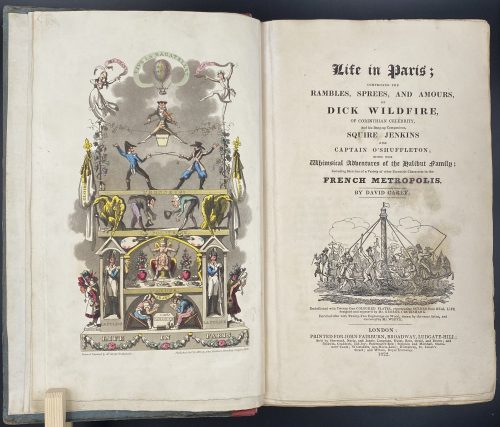
Title: Life in Paris ; | COMPRISING THE | RAMBLES, SPREES, AND AMOURS, | OF | DICK WILDFIRE, | OF CORINTHIAN CELEBRITY, | And his Bang-up Companions, SQUARE JENKINS | AND | CAPTAIN O’SHUFFLETON ; | WITH THE | Whimsical Adventures of the Halibut family ; | Including Sketches of a Variety of other Eccentric Characters in the | FRENCH METROPOLIS. | BY DAVID CAREY |[Vignette]| Embellished with Twenty-One COLOURED PLATES, representing SCENES from REAL LIFE, | designed and engraved by Mr. GEORGE CRUIKSHANK. | Enriched also with Twenty-Two Engravings on Wood, drawn by the same Artist, and | executed by Mr. WHITE. | LONDON : | PRINTED FOR JOHN FAIRBURN, BROADWAY, LUDGATE HILL; | Sold by Sherwood, Neely, and Jones ; Langman, Hurst, Rees, Orme, and Brown ; and | Baldwin, Craddoc, and Joy ; Paternoster-Row ; Simpkin and Marshall, Statio- | ners’ Court ; Whittakers Ave-Maria-Lane ; Humphrey, St. James’s | Street ; and Wilson, Royal Exchange. | 1822. ||
Edition: 1st edition in book form, 1st issue; large-paper copy bound from the parts in original blue paper boards, "most scarce" (Cohn).
Pagination: ffl, [i, ii] – h.t. ‘LIFE IN PARIS’ / ‘MARCHANT, Printer, Ingram-Court, London’, [2] – blank / Frontispiece (Ville la Bagatelle!!) hand-coloured, [iii, iv] – t.p. with vignette / blank, [v] vi-xxiv, [1] 2-489 [490 blank], [2] – 'TO THE BINDER' and 'Marchant, Printer, Ingram-Court, Fenchurch Street' "considered indispensable to a complete copy" (Cohn) / blank, bfl watermarked 1800; 21 hand-coloured aquatints and 22 wood-engraved text vignettes; cancelled leaves 143/4 and 335/6; pinholes from printing visible in most gatherings.
Collation: 4to; [a]-c4, B-Z4 Aa-Zz4 3A-3Q4 3R1 + [Ω]1
Binding: Original boards sometime re-backed with red paper, binder's end leaf watermarked 1800; red hard-grained morocco clamshell box.
Catalogue raisonné: Albert M. Cohn, 1924: № 109 p. 37/8; Abbey, J. R. (Life in England), 112; Tooley (Some English Books with Coloured Plates) 129; Hardie (English coloured books) 199.
Description of Shapero Rare Books, London: Of the copies that have come to auction since 1975 only one has been a large-paper copy in original boards. "The pictures are extremely spirited and true and are all the more wonderful in view of the fact that the artist’s continental experiences were limited to one day spent in Boulogne." (Hardie). In 1821, the journalist Pierce Egan published Life in London, an immediate success illustrated by the Cruikshank brothers, George and Robert. In order to capitalise on this success, another journalist, David Carey, decided to publish his own Life in Paris in monthly instalments (just like Life in London) and with a very similar frontispiece to the one that appears in Egan’s work; Life in Paris, however, was illustrated only by George Cruikshank. One of the earliest and most notable examples of the work of George Cruikshank, with fine, clean plates. -
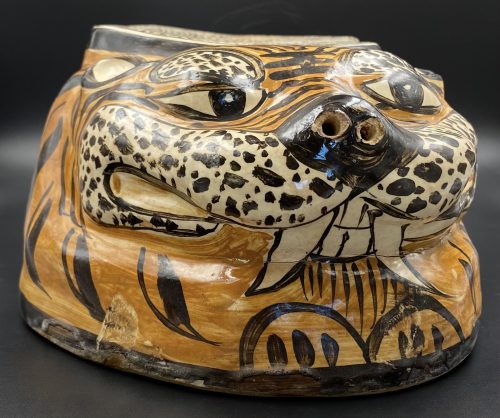 The pillow is moulded as a recumbent tiger, the details painted in dark brown and pale russet on a white slip and under a clear glaze, and the slightly dished top is painted with a winged beast. China, the Jin dynasty [金朝] (1115 – 1234). Dimensions: 12 x 34.5 x 19.5 cm
The pillow is moulded as a recumbent tiger, the details painted in dark brown and pale russet on a white slip and under a clear glaze, and the slightly dished top is painted with a winged beast. China, the Jin dynasty [金朝] (1115 – 1234). Dimensions: 12 x 34.5 x 19.5 cm -
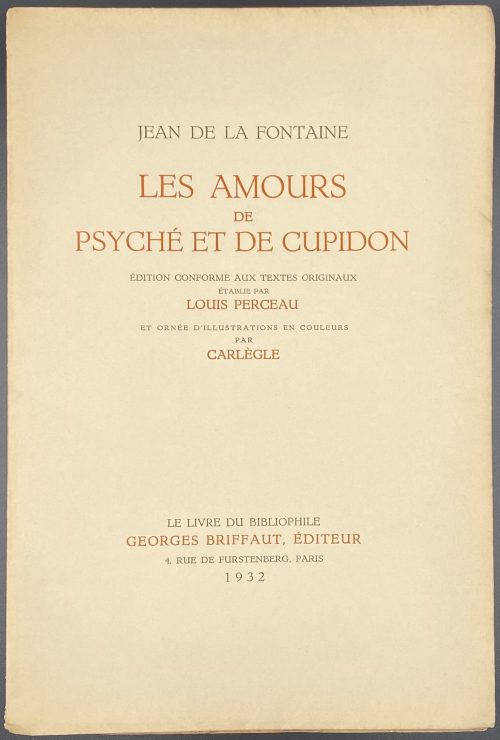 Softcover, 242 x 165 mm, French flapped wrappers with black and red lettering to front and spine, top edge trimmed, pages uncut, printed on wove paper watermarked BFK Rives in italic script; illustrations in colour. Title: JEAN DE LA FONTAINE | LES AMOURS | DE | PSYCHÉ ET DE CUPIDON | ÉDITION CONFORME AUX TEXTES ORIGINAUX | ÉTABLIE PAR | LOUIS PERCEAU | ET ORNÉE D’ILLUSTRATIONS EN COULEURS | PAR | CARLÈGLE | LE LIVRE DU BIBLIOPHILE | GEORGES BRIFFAUT, ÉDITEUR | 4, RUE DE FURSTENBERG, PARIS | 1932 || Limited edition: 1230 copies of which this ic copy № 247. Collated 8vo: π4 1-24 3-48 58 *58 6-168 χ2, total 134 leaves, incl. frontispiece. Pagination: [8] 1-253 [254] [6]. Colophon: Le volume des Amours de Psyché et de Cupidon de La Fontaine a été achevé d'imprimer le quinze juin mil neuf cent trente-deux sur les presses du maitre imprimeur Coulouma, a Argenteul, H. Barthélemy étant directeur. Coloris de E. Charpentier, Paris.
Softcover, 242 x 165 mm, French flapped wrappers with black and red lettering to front and spine, top edge trimmed, pages uncut, printed on wove paper watermarked BFK Rives in italic script; illustrations in colour. Title: JEAN DE LA FONTAINE | LES AMOURS | DE | PSYCHÉ ET DE CUPIDON | ÉDITION CONFORME AUX TEXTES ORIGINAUX | ÉTABLIE PAR | LOUIS PERCEAU | ET ORNÉE D’ILLUSTRATIONS EN COULEURS | PAR | CARLÈGLE | LE LIVRE DU BIBLIOPHILE | GEORGES BRIFFAUT, ÉDITEUR | 4, RUE DE FURSTENBERG, PARIS | 1932 || Limited edition: 1230 copies of which this ic copy № 247. Collated 8vo: π4 1-24 3-48 58 *58 6-168 χ2, total 134 leaves, incl. frontispiece. Pagination: [8] 1-253 [254] [6]. Colophon: Le volume des Amours de Psyché et de Cupidon de La Fontaine a été achevé d'imprimer le quinze juin mil neuf cent trente-deux sur les presses du maitre imprimeur Coulouma, a Argenteul, H. Barthélemy étant directeur. Coloris de E. Charpentier, Paris. -
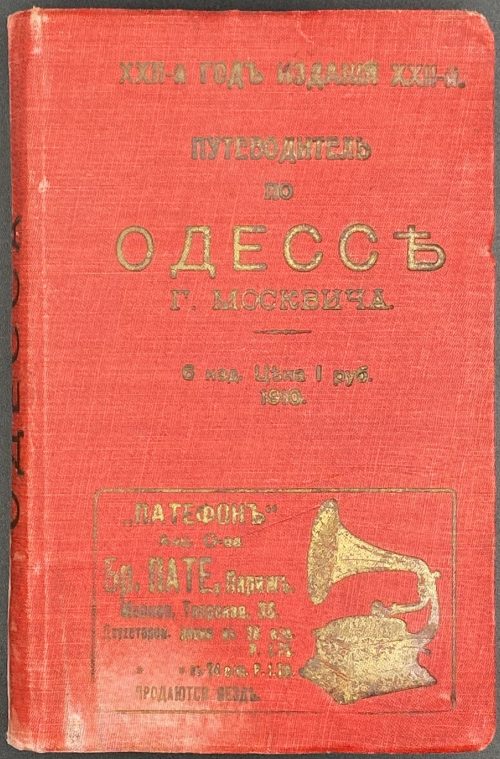 Title: Издательство Путеводителей "Русскiй Бедекеръ" сущ. съ 1888 г. | Григорiй Москвичъ. | ИЛЛЮСТРИРОВАННЫЙ | Практический Путеводитель | по Одессѣ | с приложенiемъ: | очерка одесской выставки, плана Одессы, исполненнаго | в краскахъ, плановъ — порта, Куяльницкаго лимана, | расписанiя рейсовъ пароходовъ и тарифовъ, алфавита | и проч. | ИЗДАНИIЕ ШЕСТОЕ. | Цѣна 1 руб. (в переплетѣ) | ПРОДАЕТСЯ | во всѣх лучшихъ книжныхъ магазинахъ столицъ | и провинцiи. | ОДЕССА. | Типографiя и стереотипия И. Копельмана, Пушк. 34. | 1910. || Binding: Red cloth with gilt lettering to the front board: XXII-й ГОДЪ ИЗДАНIЯ XXII-й | ПУТЕВОДИТЕЛЬ | ПО | ОДЕССѢ | Г. МОСКВИЧА. | 6 изд. Цѣна 1 руб. | 1910. [Pictorial advert.], to the back board: Text. advert. in gilt; to spine: ОДЕССА. Pink end-papers with advertisement. Pagination: [i-ii - t.p. /advert.] [iii]-iv - preface to 6th edition; [v]-viii - content; [ix]-xvi - index; 11 leaves advert., unpag; [i]-xii - Odessa exhibition; [1] 2-240; [1] 2-8 - schedules; photo plates, 2 folding maps; in-16mo (numerical). Size: 16.5 x 10.5 cm.
Title: Издательство Путеводителей "Русскiй Бедекеръ" сущ. съ 1888 г. | Григорiй Москвичъ. | ИЛЛЮСТРИРОВАННЫЙ | Практический Путеводитель | по Одессѣ | с приложенiемъ: | очерка одесской выставки, плана Одессы, исполненнаго | в краскахъ, плановъ — порта, Куяльницкаго лимана, | расписанiя рейсовъ пароходовъ и тарифовъ, алфавита | и проч. | ИЗДАНИIЕ ШЕСТОЕ. | Цѣна 1 руб. (в переплетѣ) | ПРОДАЕТСЯ | во всѣх лучшихъ книжныхъ магазинахъ столицъ | и провинцiи. | ОДЕССА. | Типографiя и стереотипия И. Копельмана, Пушк. 34. | 1910. || Binding: Red cloth with gilt lettering to the front board: XXII-й ГОДЪ ИЗДАНIЯ XXII-й | ПУТЕВОДИТЕЛЬ | ПО | ОДЕССѢ | Г. МОСКВИЧА. | 6 изд. Цѣна 1 руб. | 1910. [Pictorial advert.], to the back board: Text. advert. in gilt; to spine: ОДЕССА. Pink end-papers with advertisement. Pagination: [i-ii - t.p. /advert.] [iii]-iv - preface to 6th edition; [v]-viii - content; [ix]-xvi - index; 11 leaves advert., unpag; [i]-xii - Odessa exhibition; [1] 2-240; [1] 2-8 - schedules; photo plates, 2 folding maps; in-16mo (numerical). Size: 16.5 x 10.5 cm. -
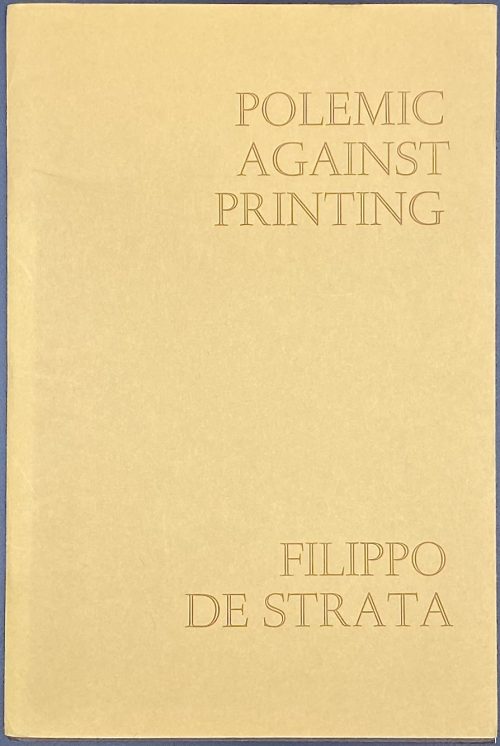 POLEMIC AGAINST PRINTING | by | FILIPPO DE STRATA | Translated by SHELAGH GRIER | Edited and | Introduced by MARTIN LOWRY | University of Warwick | The Hayloft Press | 1986 || Publisher’s mustard wrappers w/ lettering, 18.5 x 12.5 cm, 20 unnumbered pages of parallel Latin text and English translation with English introduction; limited edition of 350 copies, 100 for private circulation and 250 numbered copies for sale of which this is №3, with ink inscription to the last page: To Beryl | on her birthday, 1986 | with love from | David ||
POLEMIC AGAINST PRINTING | by | FILIPPO DE STRATA | Translated by SHELAGH GRIER | Edited and | Introduced by MARTIN LOWRY | University of Warwick | The Hayloft Press | 1986 || Publisher’s mustard wrappers w/ lettering, 18.5 x 12.5 cm, 20 unnumbered pages of parallel Latin text and English translation with English introduction; limited edition of 350 copies, 100 for private circulation and 250 numbered copies for sale of which this is №3, with ink inscription to the last page: To Beryl | on her birthday, 1986 | with love from | David || -
![Le Comte de Arthur Grandeffe. Paris sous Napoléon III. Mémoires d'un homme du monde de 1857 à 1870 / Par Le Comte de Arthur Grandeffe. — Paris: Imp. et Lib. Centrales des Chemins de Fer, A. Chaix et Cie., 1870. — pp.: ff [2 ht, blank] [2 title, blank] [i] i-vi, 1-413 [1] bf.](https://varshavskycollection.com/wp-content/uploads/2021/02/LIB-2449.2020-a-1-500x743.jpeg) Front wrapper: PARIS SOUS NAPOLÉON III | Mémoires d'un homme du monde | DE 1857 À 1870 | PAR LE COMTE DE ARTHUR GRANDEFFE | {publisher’s device} | PARIS: IMPRIMERIE ET LIBRAIRIE CENTRALES DES CHEMINS DE FER | A. CHAIX ET Cie | RUE BERGÈRE 20, PRÈS DU BOULEVARD MONTMARTRE | 1879 || Similar lettering to t.p. Softcover 18.5 x 12 cm, publisher’s original blue wrappers, first and last leaves glued to wrappers, unevenly trimmed, some uncut, pagination [4] [i] ii-vi, [1] 2-413 [414], authors advert to back wrapper; mispaginated pp. 136-141; collation: 18mo, π6, 1-2218 236. Sticker with gilt lettering to front wrapper “LIBRAIRIE CENTRALE | BERTRAND & QUEYROT | MENTON”; sticker to spine "577".
Front wrapper: PARIS SOUS NAPOLÉON III | Mémoires d'un homme du monde | DE 1857 À 1870 | PAR LE COMTE DE ARTHUR GRANDEFFE | {publisher’s device} | PARIS: IMPRIMERIE ET LIBRAIRIE CENTRALES DES CHEMINS DE FER | A. CHAIX ET Cie | RUE BERGÈRE 20, PRÈS DU BOULEVARD MONTMARTRE | 1879 || Similar lettering to t.p. Softcover 18.5 x 12 cm, publisher’s original blue wrappers, first and last leaves glued to wrappers, unevenly trimmed, some uncut, pagination [4] [i] ii-vi, [1] 2-413 [414], authors advert to back wrapper; mispaginated pp. 136-141; collation: 18mo, π6, 1-2218 236. Sticker with gilt lettering to front wrapper “LIBRAIRIE CENTRALE | BERTRAND & QUEYROT | MENTON”; sticker to spine "577". -
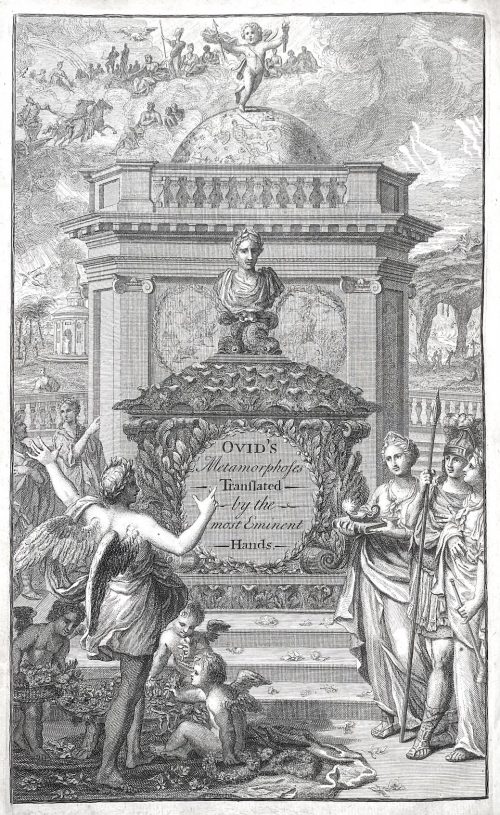 Title: OVID'S | METAMORPHOSES | IN | FIFTEEN BOOKS. | Translated by the most Eminent Hands. | Adorn’d with Sculptures | London: | Printed for Jacob Tonson at Shakespeare’s–Head | over-against Katharine-Street in the Strand. | M DCC XVII. || Physical description: Folio, laid paper, engraved title as frontispiece, letterpress title-page, portrait of the dedicatee, the Princess of Wales, engraved by George Vertue (British, 1684 – 1756) after Sir Godfrey Kneller (German, 1646 – 1723), [4] – dedication with headpiece vignette engraved by Elisha Kirkall (British, 1682 – 1742) after Peter Berchet (French, 1659 – 1720 London), [i]-xx – preface, [4] – contents, 1-548; collation: π3 a-f2, B-Zzzzzz2, +15 full-paged engravings, one heading each book; bound in full contemporary tan English calf blind-tooled with a darker panel, raised bands, crimson label with gilt lettering, sprinkled compartments with blind tooling, rebacked, later endpapers, 15 1/4 x 9 1/2 in (39.5 x 26 x 5 cm). Contributors: Author: Ovid (Roman, 43 B.C. – A.D. 17) Translator: Sir Samuel Garth (British, 1661 – 1719) Translator: John Dryden (British, 1631 – 1700) Translator: Joseph Addison (British, 1672 – 1719) Translator: John Gay (British, 1685 – 1732) Dedicatee / Sitter: Caroline Wilhelmina of Brandenburg-Ansbach, Princess of Wales, Queen of England (German-British, 1683 – 1737) Engraver: Elisha Kirkall (British, 1682 – 1742) Artist: Peter Berchet (French-British, 1659 – 1720) Artist: Sir Godfrey Kneller (German, 1646 – 1723) Engraver: George Vertue (British, 1684 – 1756) Engraver: Louis Du Guernier, the younger (French, 1677 – 1716) Engraver: Michael Vandergucht (Flemish, 1660 – 1725) Engraver: Elisha Kirkall (British, 1682 – 1742) Engraver: R. Smith (British, fl. early 18th century) Engraver: Matthys Pool (Dutch, 1670 – c. 1732) Publisher: Jacob Tonson, the Elder (British, 1655 – 1736)
Title: OVID'S | METAMORPHOSES | IN | FIFTEEN BOOKS. | Translated by the most Eminent Hands. | Adorn’d with Sculptures | London: | Printed for Jacob Tonson at Shakespeare’s–Head | over-against Katharine-Street in the Strand. | M DCC XVII. || Physical description: Folio, laid paper, engraved title as frontispiece, letterpress title-page, portrait of the dedicatee, the Princess of Wales, engraved by George Vertue (British, 1684 – 1756) after Sir Godfrey Kneller (German, 1646 – 1723), [4] – dedication with headpiece vignette engraved by Elisha Kirkall (British, 1682 – 1742) after Peter Berchet (French, 1659 – 1720 London), [i]-xx – preface, [4] – contents, 1-548; collation: π3 a-f2, B-Zzzzzz2, +15 full-paged engravings, one heading each book; bound in full contemporary tan English calf blind-tooled with a darker panel, raised bands, crimson label with gilt lettering, sprinkled compartments with blind tooling, rebacked, later endpapers, 15 1/4 x 9 1/2 in (39.5 x 26 x 5 cm). Contributors: Author: Ovid (Roman, 43 B.C. – A.D. 17) Translator: Sir Samuel Garth (British, 1661 – 1719) Translator: John Dryden (British, 1631 – 1700) Translator: Joseph Addison (British, 1672 – 1719) Translator: John Gay (British, 1685 – 1732) Dedicatee / Sitter: Caroline Wilhelmina of Brandenburg-Ansbach, Princess of Wales, Queen of England (German-British, 1683 – 1737) Engraver: Elisha Kirkall (British, 1682 – 1742) Artist: Peter Berchet (French-British, 1659 – 1720) Artist: Sir Godfrey Kneller (German, 1646 – 1723) Engraver: George Vertue (British, 1684 – 1756) Engraver: Louis Du Guernier, the younger (French, 1677 – 1716) Engraver: Michael Vandergucht (Flemish, 1660 – 1725) Engraver: Elisha Kirkall (British, 1682 – 1742) Engraver: R. Smith (British, fl. early 18th century) Engraver: Matthys Pool (Dutch, 1670 – c. 1732) Publisher: Jacob Tonson, the Elder (British, 1655 – 1736) -
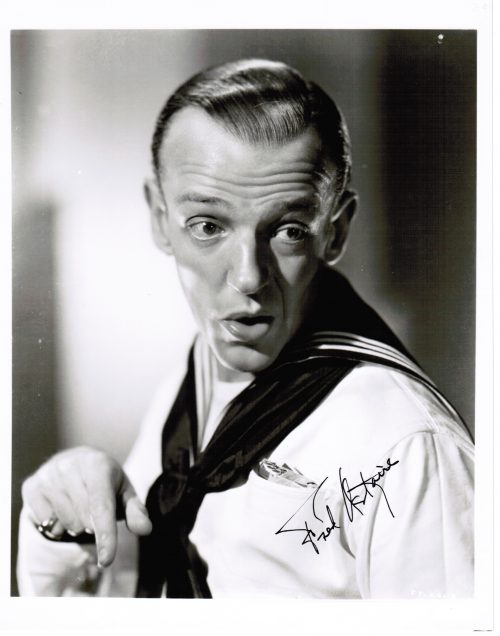 Black and white photographic half-length portrait of Fred Astaire [Frederick Austerlitz] (American, 1899 – 1987) in sailor's uniform, signed "Fred Astaire" in black ink. Probably, from "Following the Fleet", a 1936 American RKO musical comedy. Size: 26.2 x 20.6 cm sheet; 23.3. x 19.3 cm image. Certificate of authenticity from John Reznikoff, University Archives.
Black and white photographic half-length portrait of Fred Astaire [Frederick Austerlitz] (American, 1899 – 1987) in sailor's uniform, signed "Fred Astaire" in black ink. Probably, from "Following the Fleet", a 1936 American RKO musical comedy. Size: 26.2 x 20.6 cm sheet; 23.3. x 19.3 cm image. Certificate of authenticity from John Reznikoff, University Archives. -

Iron tsuba of round form decorated with a deer and maple leaves in positive silhouette openwork (ji-sukashi), with details finely carved in low relief (kebori). Nakagō-ana plugged with copper fittings (sekigane). Traces of lacquer on the surface.
NBTHK: Hozon, №424947.
Design: An autumnal tsuba with an allusion to Kasuga Shrine in Nara.
Attributed by NBTHK to Shoami. Age: Probably the Momoyama period (1574 – 1603) or early Edo period (1603 – 1650), but judging on the item's substantial size (diameter 86.6 mm) and considerable thinness (3.4 mm) may be attributed to earlier times (late Muromachi period, 1514 – 1573). -
![The Betrothed. From the Italian of Alessandro Manzoni. — London: Richard Bentley (successor to Henry Colburn). Cumming, Dublin; Bell & Bradfute, Edinburgh; Galignani, Paris, 1834. — Series: Standard novels, № XLIII [43]. The Betrothed. Complete in one volume.](https://varshavskycollection.com/wp-content/uploads/2021/02/LIB-1332-g-500x820.jpg) Half-title: STANDARD NOVELS. | № XLIII. | {6 lines of citation} | THE BETROTHED | COMPLETE IN ONE VOLUME. | LONDON: RICHARD BENTLEY | (SUCCESSOR TO HENRY COLBURN) : | BELL & BRADFUTE, EDINBURGH; | CUMMING, DUBLIN. | 1834 || Illustrated title page: THE BETROTHED, | FROM THE ITALIAN | OF | ALESSANDRO MANZONI. | {vignette by S. Smith after F. Pickering} | LONDON: | RICHARD BENTLEY | (SUCCESSOR TO HENRY COLBURN.) | CUMMING, DUBLIN, – BELL & BRADFUTE, EDINBURGH, | GALIGNANI, PARIS. |1834. || Title page: THE | BETROTHED. | FROM THE ITALIAN | OF | ALESSANDRO MANZONI. | LONDON: RICHARD BENTLEY, 8 NEW BURLINGTON STREET | (SUCCESSOR TO HENRY COLBURN): | BELL & BRADFUTE, EDINBURGH; | AND CUMMING, DUBLIN. | 1834 || Frontispiece: vignette by S. Smith after F. Pickering. Pagination: [i-v] 6-xii, [1] 2-452 [2 blank] + 2 plates. Collation: [A]6 B-Z8 AA-FF8 GG2 + 2 leaves of plates; Note: A1, A2, A4, GG2 – unsigned; both frontispiece and illustrated title are extraneous to collation. Binding: 2/3 black calf over marbled boards, raised bands w/gilt elements, gilt lettering in compartments and gilt title on a crimson label to spine; contemporary, but not the original publisher's binding; size: 16.5 x 10.5 cm Bookplates: Yellow sticker to front pastedown “J. K. Higgins, Northampton” (unknown); Ex libris to the front flyleaf: “Hilda Moore” (probably Hilda Mary Moore (British, 1886 – 1929) – a British stage and film actress. Series: Bentley's Standard Novels, № 43, first series. Catalogue raisonné: Michael Sadleir (1951): p. 101. Original title: ALESSANDRO MANZONI : I PROMESSI SPOSI Contributors: Manzoni, Alessandro (Italian, 1785 – 1873) Pickering, Ferdinand (British, 1810 – 1889) – artist. Smith, Samuel S. (British, 1810 – 1879) – engraver. A. Spottiswoode (London); Spottiswoode, Andrew (British, 1787 – 1866) – printer. Bentley, Richard (British, 1794 – 1871) – publisher. For the Russian edition see [LIB-1333.2017]: Алессандро Манцони. Обрученные. Повесть из истории Милана XVII века / Перевод И. И. Шитца. (Итальянская литература). — М.-Л.: Academia, 1936.
Half-title: STANDARD NOVELS. | № XLIII. | {6 lines of citation} | THE BETROTHED | COMPLETE IN ONE VOLUME. | LONDON: RICHARD BENTLEY | (SUCCESSOR TO HENRY COLBURN) : | BELL & BRADFUTE, EDINBURGH; | CUMMING, DUBLIN. | 1834 || Illustrated title page: THE BETROTHED, | FROM THE ITALIAN | OF | ALESSANDRO MANZONI. | {vignette by S. Smith after F. Pickering} | LONDON: | RICHARD BENTLEY | (SUCCESSOR TO HENRY COLBURN.) | CUMMING, DUBLIN, – BELL & BRADFUTE, EDINBURGH, | GALIGNANI, PARIS. |1834. || Title page: THE | BETROTHED. | FROM THE ITALIAN | OF | ALESSANDRO MANZONI. | LONDON: RICHARD BENTLEY, 8 NEW BURLINGTON STREET | (SUCCESSOR TO HENRY COLBURN): | BELL & BRADFUTE, EDINBURGH; | AND CUMMING, DUBLIN. | 1834 || Frontispiece: vignette by S. Smith after F. Pickering. Pagination: [i-v] 6-xii, [1] 2-452 [2 blank] + 2 plates. Collation: [A]6 B-Z8 AA-FF8 GG2 + 2 leaves of plates; Note: A1, A2, A4, GG2 – unsigned; both frontispiece and illustrated title are extraneous to collation. Binding: 2/3 black calf over marbled boards, raised bands w/gilt elements, gilt lettering in compartments and gilt title on a crimson label to spine; contemporary, but not the original publisher's binding; size: 16.5 x 10.5 cm Bookplates: Yellow sticker to front pastedown “J. K. Higgins, Northampton” (unknown); Ex libris to the front flyleaf: “Hilda Moore” (probably Hilda Mary Moore (British, 1886 – 1929) – a British stage and film actress. Series: Bentley's Standard Novels, № 43, first series. Catalogue raisonné: Michael Sadleir (1951): p. 101. Original title: ALESSANDRO MANZONI : I PROMESSI SPOSI Contributors: Manzoni, Alessandro (Italian, 1785 – 1873) Pickering, Ferdinand (British, 1810 – 1889) – artist. Smith, Samuel S. (British, 1810 – 1879) – engraver. A. Spottiswoode (London); Spottiswoode, Andrew (British, 1787 – 1866) – printer. Bentley, Richard (British, 1794 – 1871) – publisher. For the Russian edition see [LIB-1333.2017]: Алессандро Манцони. Обрученные. Повесть из истории Милана XVII века / Перевод И. И. Шитца. (Итальянская литература). — М.-Л.: Academia, 1936. -
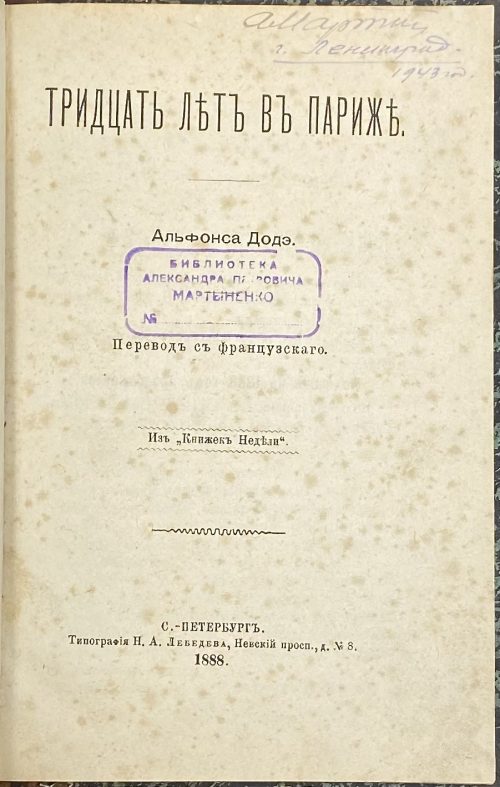 Russian translation of: Alphonse Daudet. Trente ans de Paris à travers ma vie et mes livres; (Collection artistique Guillaume et Cie). — Paris: C. Marpon et E. Flammarion, 1888. Series: Книжки Недели, №2-4, 1888. Title: ТРИДЦАТЬ ЛѢТ ВЪ ПАРИЖѢ. | Альфонса Додэ. | Переводъ съ французскаго. | {in waving rules} Изъ "Книжекъ недѣли". | {waving rule} | С.-ПЕТЕРБУРГЪ. | Типографiя Н. А. Лебедева. Невскiй просп., д. № 8. | 1888. || Pagination:[2] [1] 2-108 [2] – back wrapper; total number of pages 112. Collation: 8vo; π7 1-28 7-88 98 78 (six 8vo gatherings) ω1; total number of leaves 56. Binding: 24 x 16.5 cm quarter brown morocco over marbled boards, blind lettering to spine; personal library stamp to a number of pages: “БИБЛИОТЕКА | АЛЕКСАНДРА ПЕТРОВИЧА | МАРТЫНЕНКО | №»; handwritten inscription to front flyleaf: «А. Мартыненко, г. Ленинград, 1943 г.» Contributors: Alphonse Daudet (French, 1840 – 1897) – author of the text. Лебедев, Николай Афанасьевич (Russian, 1813 – 1896) – printer. Гайдебуров, Павел Александрович (Russian, 1841 – 1893/4) – publisher.
Russian translation of: Alphonse Daudet. Trente ans de Paris à travers ma vie et mes livres; (Collection artistique Guillaume et Cie). — Paris: C. Marpon et E. Flammarion, 1888. Series: Книжки Недели, №2-4, 1888. Title: ТРИДЦАТЬ ЛѢТ ВЪ ПАРИЖѢ. | Альфонса Додэ. | Переводъ съ французскаго. | {in waving rules} Изъ "Книжекъ недѣли". | {waving rule} | С.-ПЕТЕРБУРГЪ. | Типографiя Н. А. Лебедева. Невскiй просп., д. № 8. | 1888. || Pagination:[2] [1] 2-108 [2] – back wrapper; total number of pages 112. Collation: 8vo; π7 1-28 7-88 98 78 (six 8vo gatherings) ω1; total number of leaves 56. Binding: 24 x 16.5 cm quarter brown morocco over marbled boards, blind lettering to spine; personal library stamp to a number of pages: “БИБЛИОТЕКА | АЛЕКСАНДРА ПЕТРОВИЧА | МАРТЫНЕНКО | №»; handwritten inscription to front flyleaf: «А. Мартыненко, г. Ленинград, 1943 г.» Contributors: Alphonse Daudet (French, 1840 – 1897) – author of the text. Лебедев, Николай Афанасьевич (Russian, 1813 – 1896) – printer. Гайдебуров, Павел Александрович (Russian, 1841 – 1893/4) – publisher. -
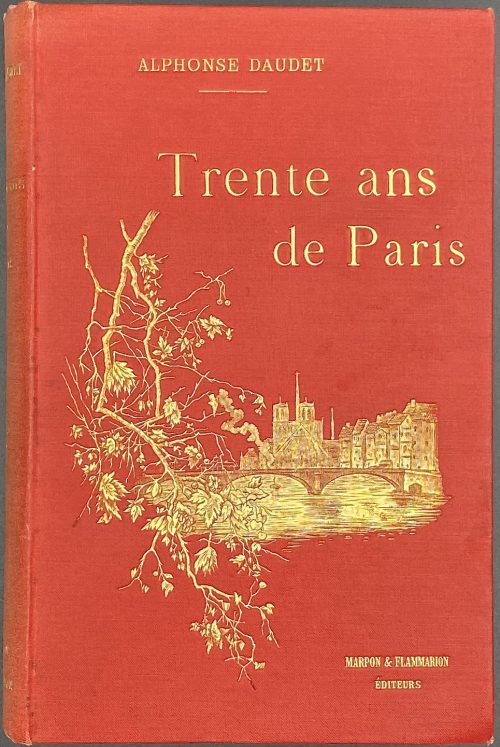 Pictorial title (coloured): Collection Artistique Guillaume et Cie |—| ALPHONSE DAUDET | Trente ans | de Paris | PARIS | C. MARPON ET E. FLAMMARION | 26, RUE RACINE, 26 | 1888 || Title page: Collection Artistique Guillaume et Cie |—| ALPHONSE DAUDET | Trente ans de Paris | À TRAVERS MA VIE ET MES LIVRES | Illustré | PAR BIELER, MONTÉGUT, MYRBACH, PICARD ET ROSSI | Gravure de Guillaume Frères et Cie | PARIS | C. MARPON ET E. FLAMMARION | 26, RUE RACINE, 26 | 1888 | Tous droits réservés. || Pagination: [12] [1] 2-344 [6], total 362 pp., in-text illustration, head- and tailpieces, photomechanical reproductions. Collation: 12mo; π6, 1-2812 +1; total 181 leaves. Binding: 19 x 12.5 cm; red cloth, gilt lettering to spine, gilt lettering and vignette to front board and gilt device to back board; bookplate to front pastedown: Ex Libris Dr. Vodoz = Egg; Gift inscription to flyleaf in German, dated 30/12/87. Contributors: Alphonse Daudet (French, 1840 – 1897) – author. Ernest Biéler (Swiss, 1863 – 1948) – artist. Louis Montégut (French, 1855 – 1906) – artist. Felician Myrbach (Austrian, 1853 – 1940) – artist. Georges Picard (French, 1857 – 1943) – artist. Luigi Rossi (Swiss, 1853 – 1923) – artist. Ernest Flammarion (French, 1846 – 1936) – publisher. Charles Marpon (French, 1838 – 1890) – publisher. Alexis Lahure (French, 1849 – 1928) – printer. Guillaume Frères et Cie – engravers.
Pictorial title (coloured): Collection Artistique Guillaume et Cie |—| ALPHONSE DAUDET | Trente ans | de Paris | PARIS | C. MARPON ET E. FLAMMARION | 26, RUE RACINE, 26 | 1888 || Title page: Collection Artistique Guillaume et Cie |—| ALPHONSE DAUDET | Trente ans de Paris | À TRAVERS MA VIE ET MES LIVRES | Illustré | PAR BIELER, MONTÉGUT, MYRBACH, PICARD ET ROSSI | Gravure de Guillaume Frères et Cie | PARIS | C. MARPON ET E. FLAMMARION | 26, RUE RACINE, 26 | 1888 | Tous droits réservés. || Pagination: [12] [1] 2-344 [6], total 362 pp., in-text illustration, head- and tailpieces, photomechanical reproductions. Collation: 12mo; π6, 1-2812 +1; total 181 leaves. Binding: 19 x 12.5 cm; red cloth, gilt lettering to spine, gilt lettering and vignette to front board and gilt device to back board; bookplate to front pastedown: Ex Libris Dr. Vodoz = Egg; Gift inscription to flyleaf in German, dated 30/12/87. Contributors: Alphonse Daudet (French, 1840 – 1897) – author. Ernest Biéler (Swiss, 1863 – 1948) – artist. Louis Montégut (French, 1855 – 1906) – artist. Felician Myrbach (Austrian, 1853 – 1940) – artist. Georges Picard (French, 1857 – 1943) – artist. Luigi Rossi (Swiss, 1853 – 1923) – artist. Ernest Flammarion (French, 1846 – 1936) – publisher. Charles Marpon (French, 1838 – 1890) – publisher. Alexis Lahure (French, 1849 – 1928) – printer. Guillaume Frères et Cie – engravers. -
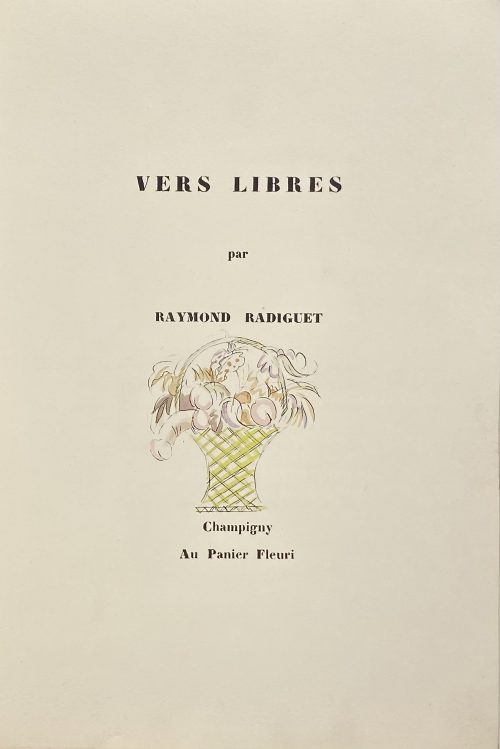 Unbound, unpaginated album (28.5 x 19.5 cm) with 22 leaves (11 folded sheets 28 x 38 cm each), printed on thick wove paper watermarked Arches with text and 27 vignettes, in a 29 x 20 cm slightly beige slipcase. Publisher’s original flapped cream wrappers, lettering to front over the vignette: VERS LIBRES | par | RAYMOND RADIGUET | Champigny | Au Panier Fleuri || Half-title: VERS LIBRES over a ribbon covering a stick, garland, and flute. Title: VERS LIBRES | par | RAYMOND RADIGUET || {vignette} | Champigny | Au Panier Fleuri || Section title: VERS LIBRES over a vignette of a girl in a hat and with an umbrella on a beach. Illustrations: Cover vignette, frontispiece, tail- and a headpiece for the Note, and vignettes (total 27 illustrations) attributed Rojan (Feodor Rojankovsky). Poems: Chat perché; Champigny, Usée, Les fiancés de treize ans, Saison, Le petit journal, Ébauches, II Cinématographe. Edition: 1st; Limitation on the last page: the total print run of 125 copies, this copy is № 18. Illustrations printed in black and stencil-coloured (au pochoir). Catalogue raisonné: Dutel 2592; Nordmann (2): 450. Dutel counts vignettes as 27, Christie's (Nordmann) as 28. Dutel writes it is printed on vergé de Hollande (laid paper), our copy is as per Nordmann, on wove Arches. No one mentions the slipcase. The number of leaves: 20 per Dutel, 22 per Nordmann. Why Cinématographe numbered II is unclear. Contributors: Raymond Radiguet (French, 1903 – 1923) – author. Feodor Rojankovsky [Rojan; Рожанковский, Фёдор Степанович] (Russian-American, 1891 – 1970) – artist. Comparison of 1935 and 1937 editions reveals that, as usual, the earlier the better.
Unbound, unpaginated album (28.5 x 19.5 cm) with 22 leaves (11 folded sheets 28 x 38 cm each), printed on thick wove paper watermarked Arches with text and 27 vignettes, in a 29 x 20 cm slightly beige slipcase. Publisher’s original flapped cream wrappers, lettering to front over the vignette: VERS LIBRES | par | RAYMOND RADIGUET | Champigny | Au Panier Fleuri || Half-title: VERS LIBRES over a ribbon covering a stick, garland, and flute. Title: VERS LIBRES | par | RAYMOND RADIGUET || {vignette} | Champigny | Au Panier Fleuri || Section title: VERS LIBRES over a vignette of a girl in a hat and with an umbrella on a beach. Illustrations: Cover vignette, frontispiece, tail- and a headpiece for the Note, and vignettes (total 27 illustrations) attributed Rojan (Feodor Rojankovsky). Poems: Chat perché; Champigny, Usée, Les fiancés de treize ans, Saison, Le petit journal, Ébauches, II Cinématographe. Edition: 1st; Limitation on the last page: the total print run of 125 copies, this copy is № 18. Illustrations printed in black and stencil-coloured (au pochoir). Catalogue raisonné: Dutel 2592; Nordmann (2): 450. Dutel counts vignettes as 27, Christie's (Nordmann) as 28. Dutel writes it is printed on vergé de Hollande (laid paper), our copy is as per Nordmann, on wove Arches. No one mentions the slipcase. The number of leaves: 20 per Dutel, 22 per Nordmann. Why Cinématographe numbered II is unclear. Contributors: Raymond Radiguet (French, 1903 – 1923) – author. Feodor Rojankovsky [Rojan; Рожанковский, Фёдор Степанович] (Russian-American, 1891 – 1970) – artist. Comparison of 1935 and 1937 editions reveals that, as usual, the earlier the better.1935 1937 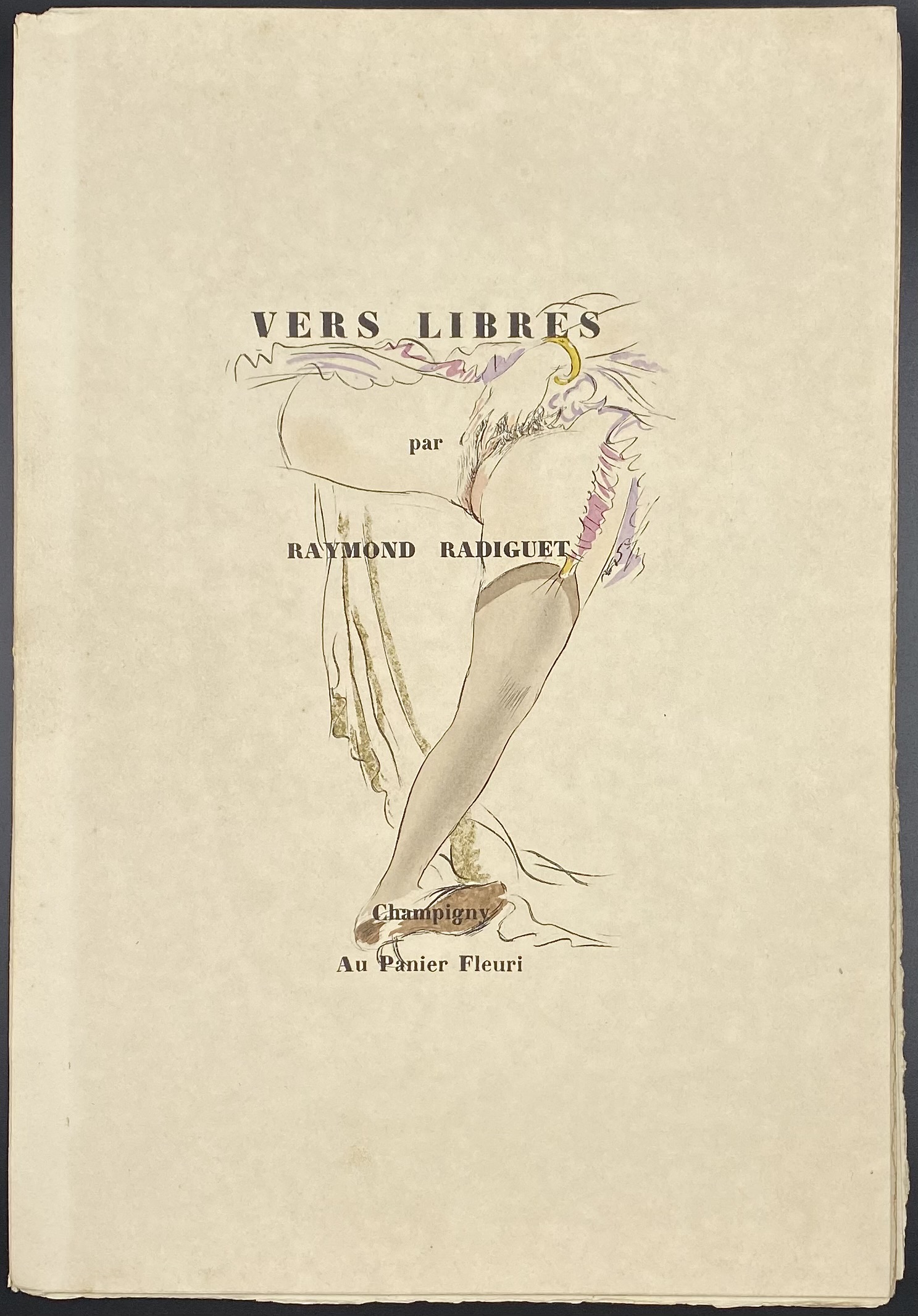
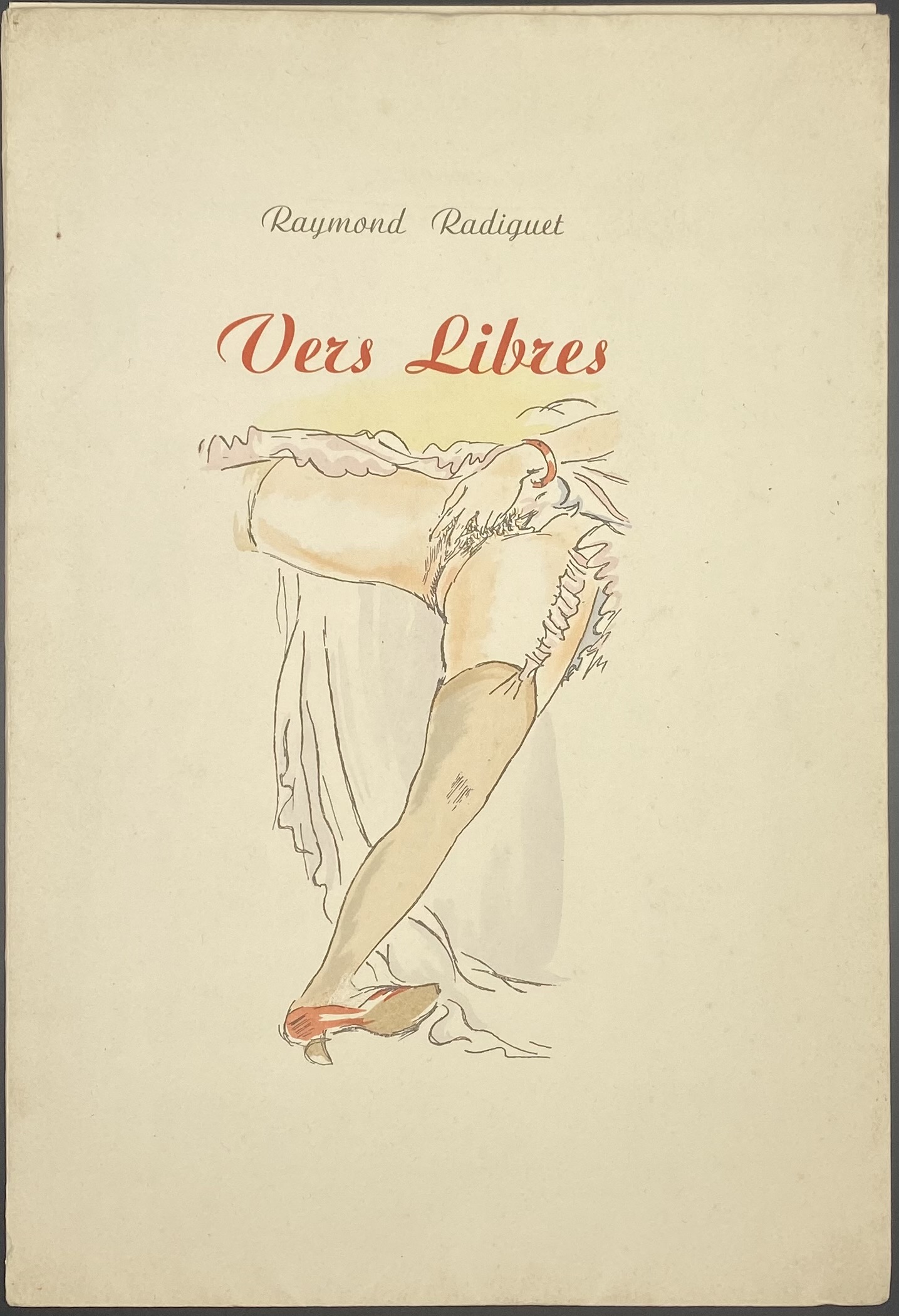
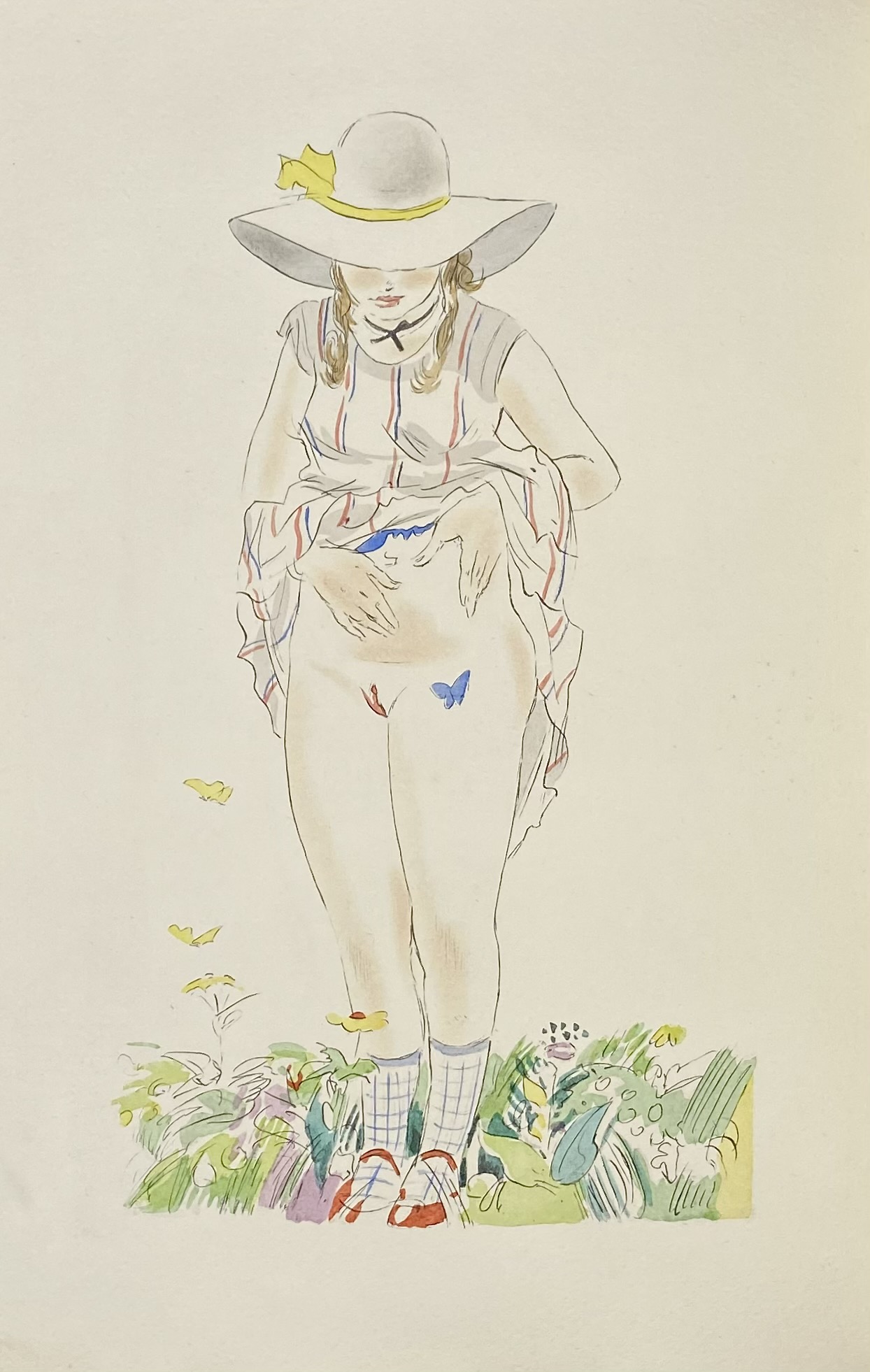
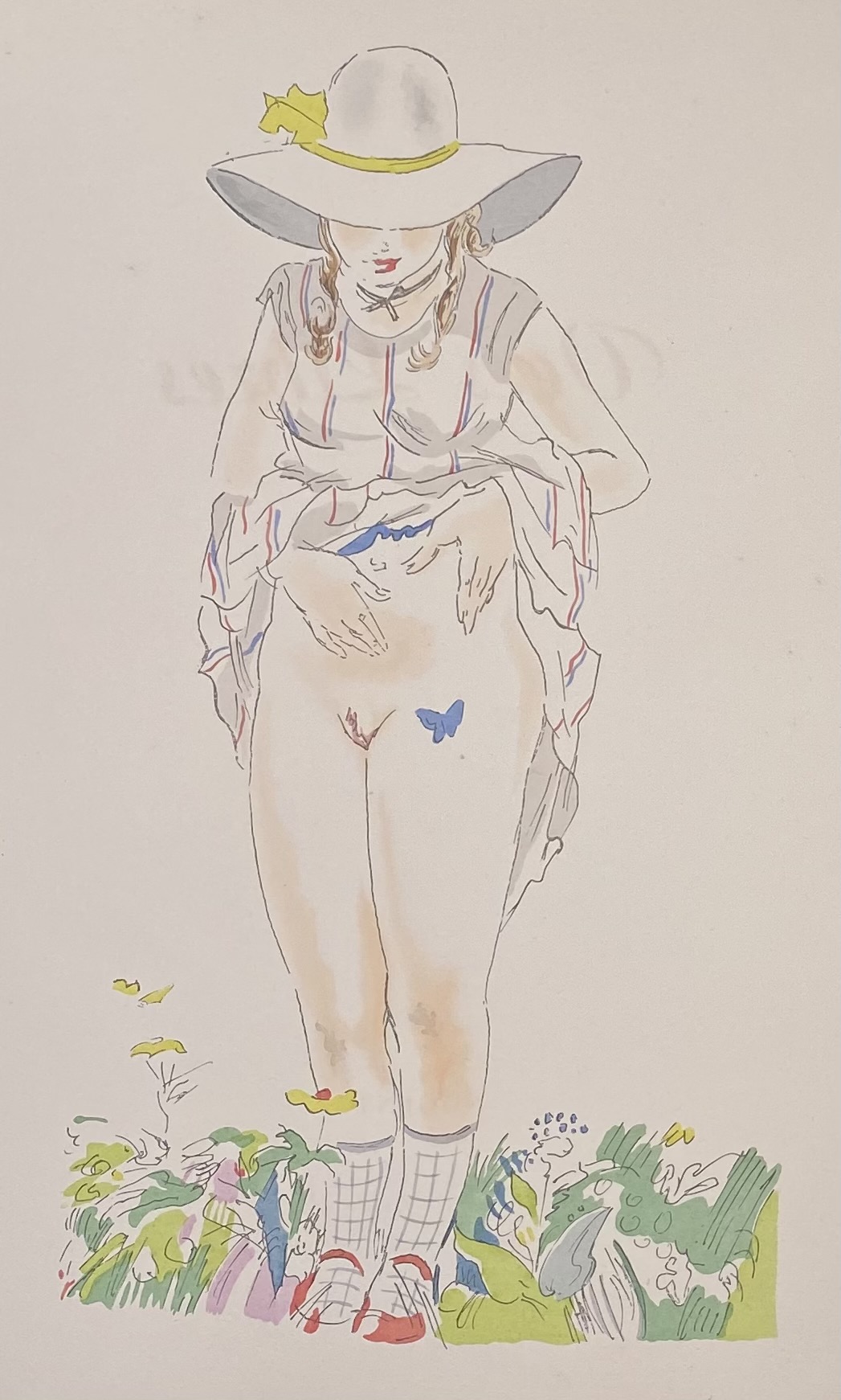
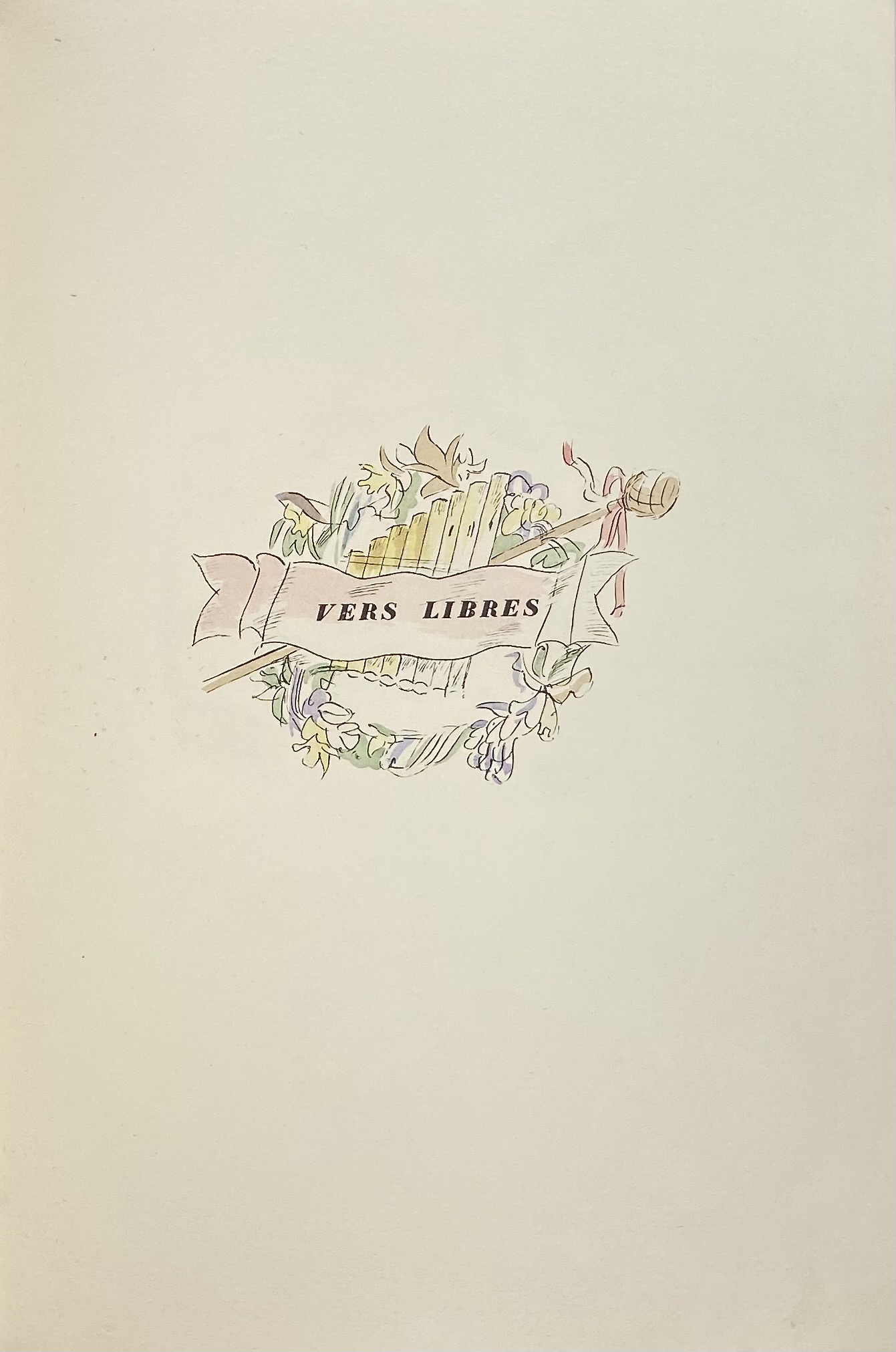
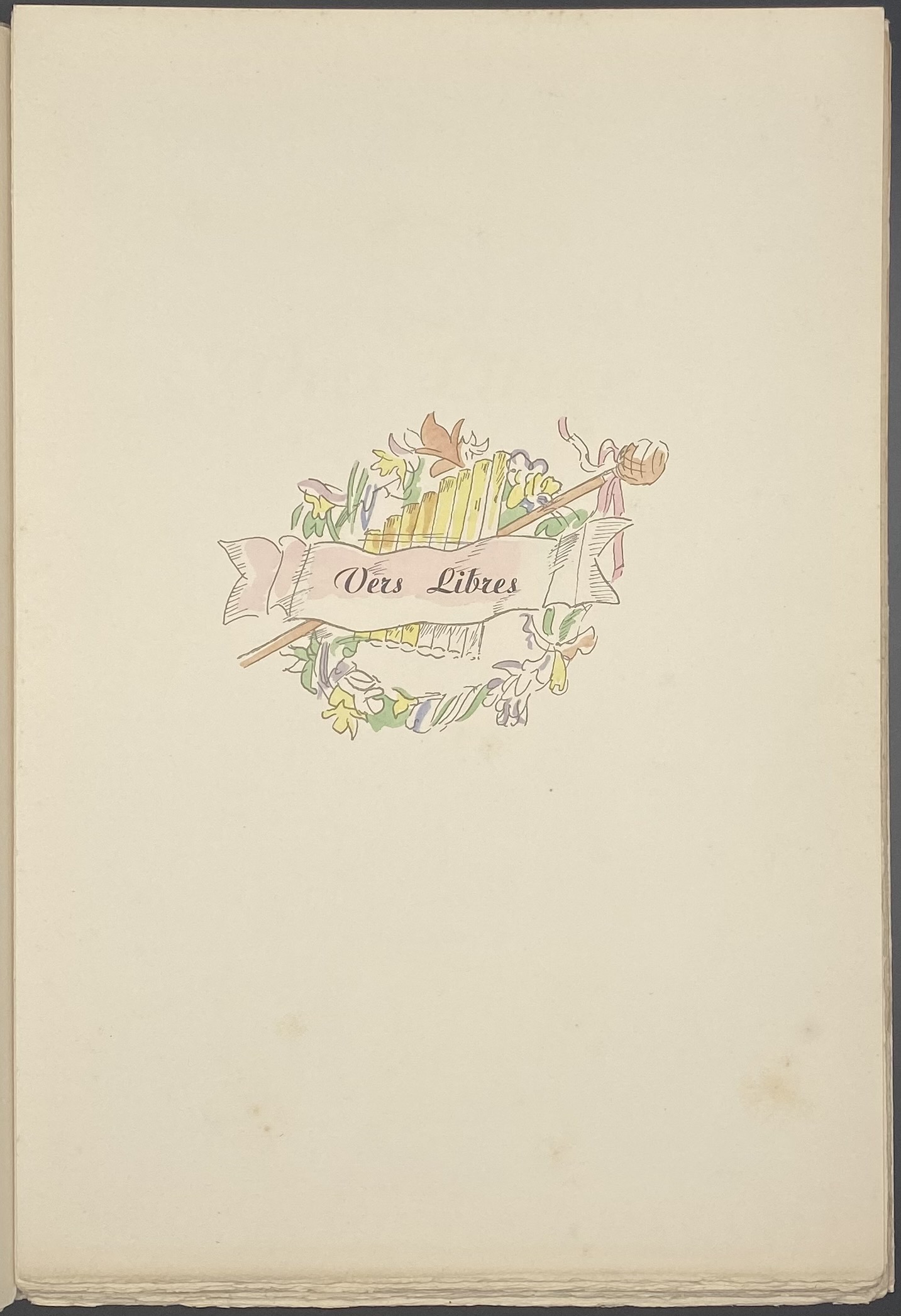
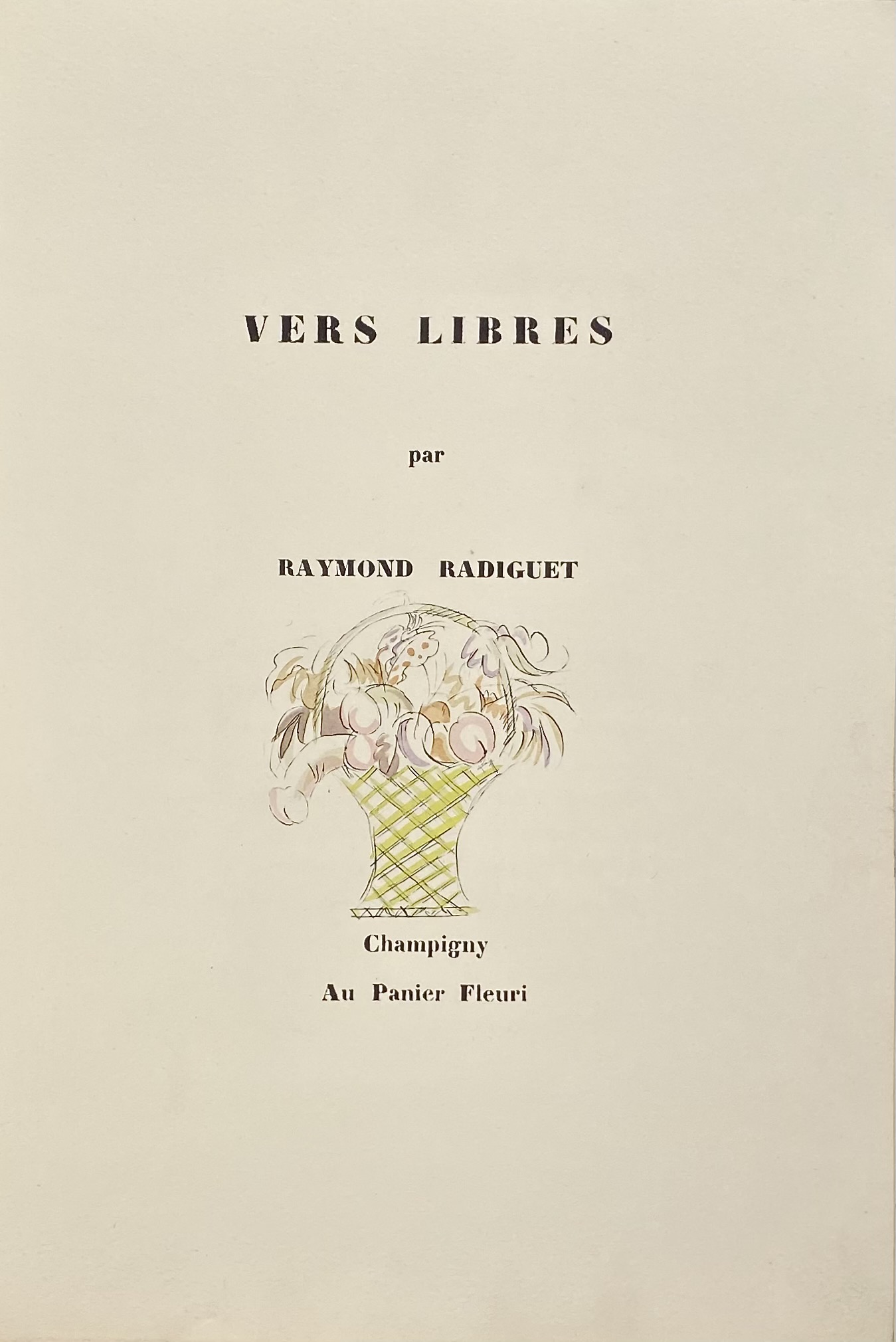
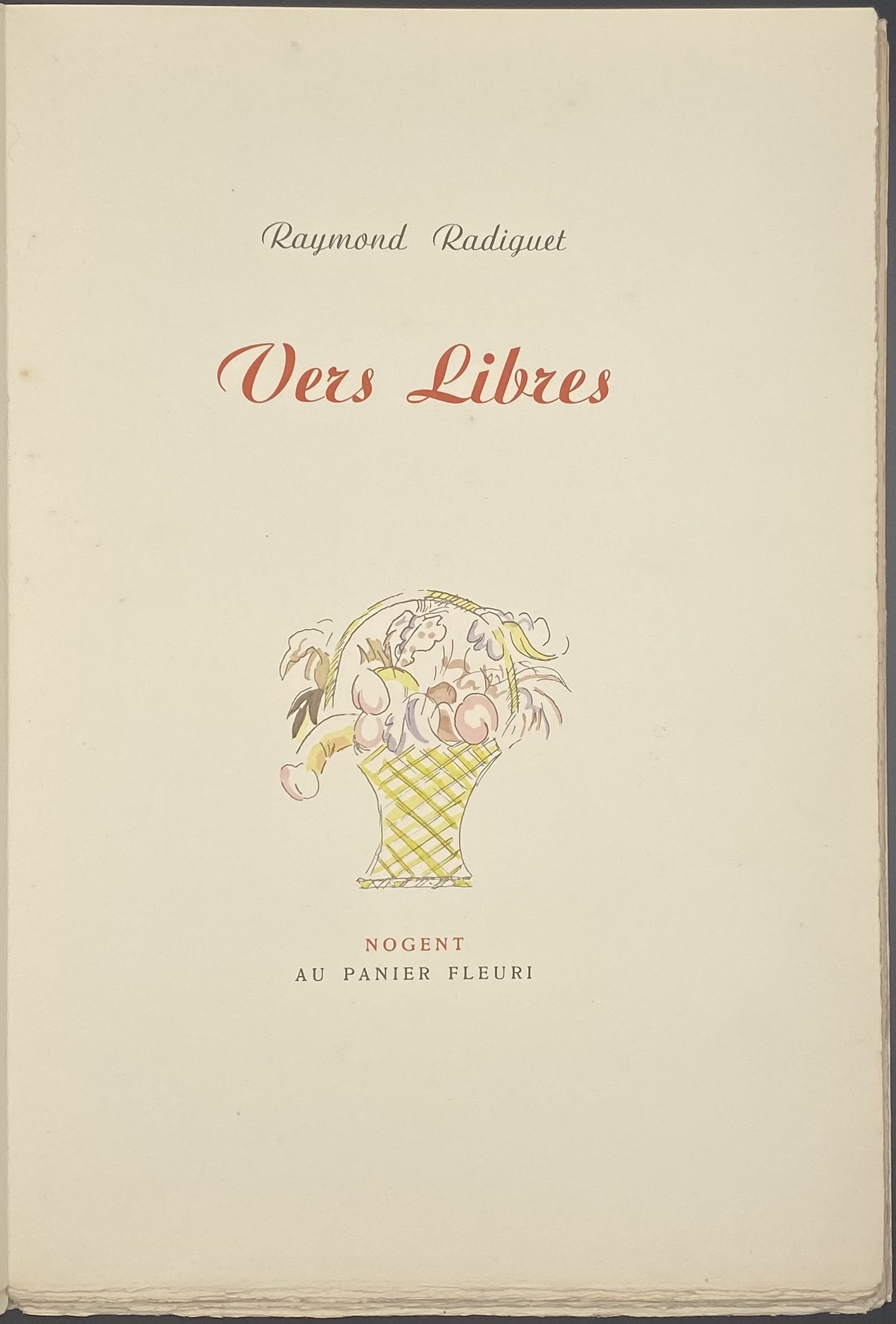
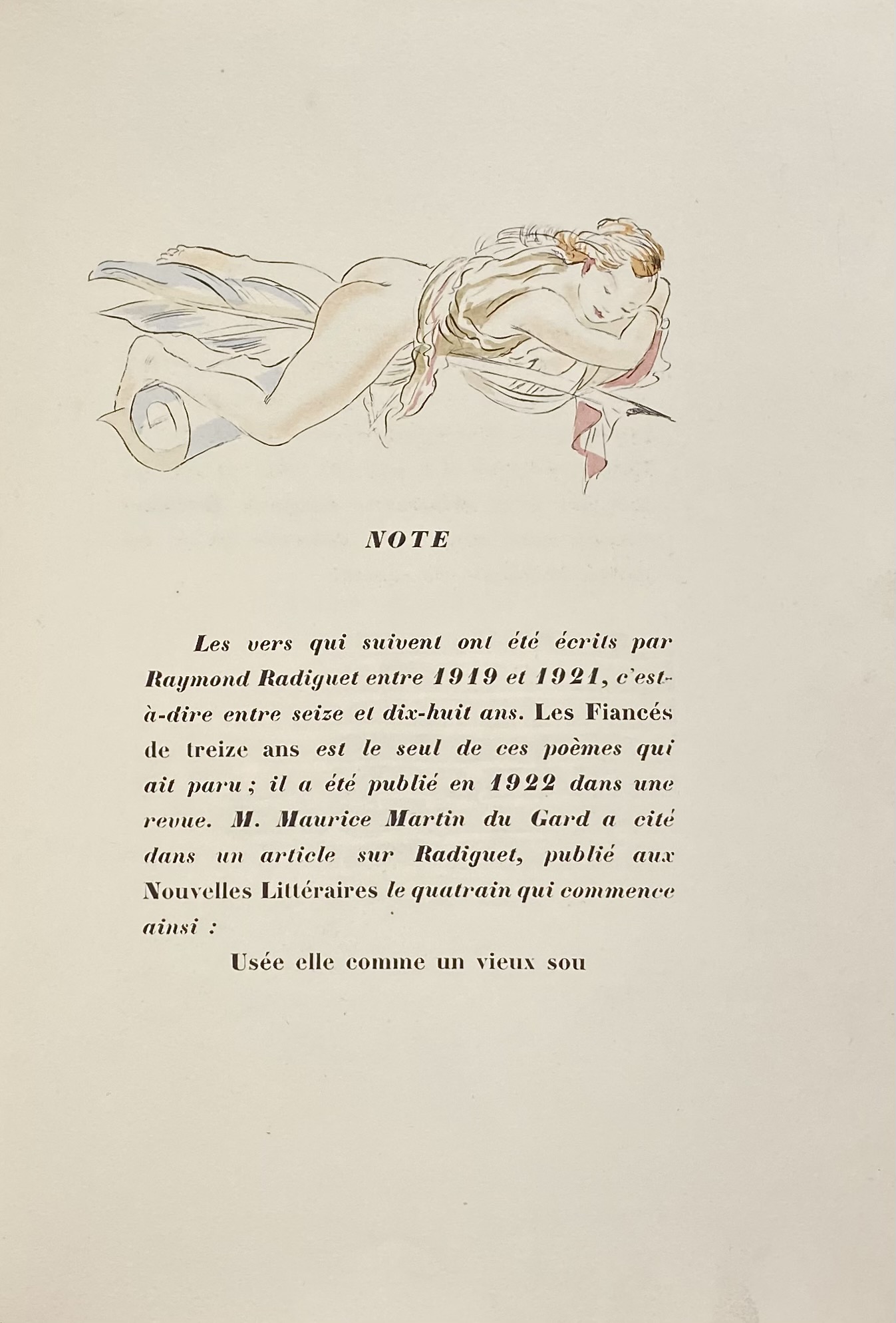
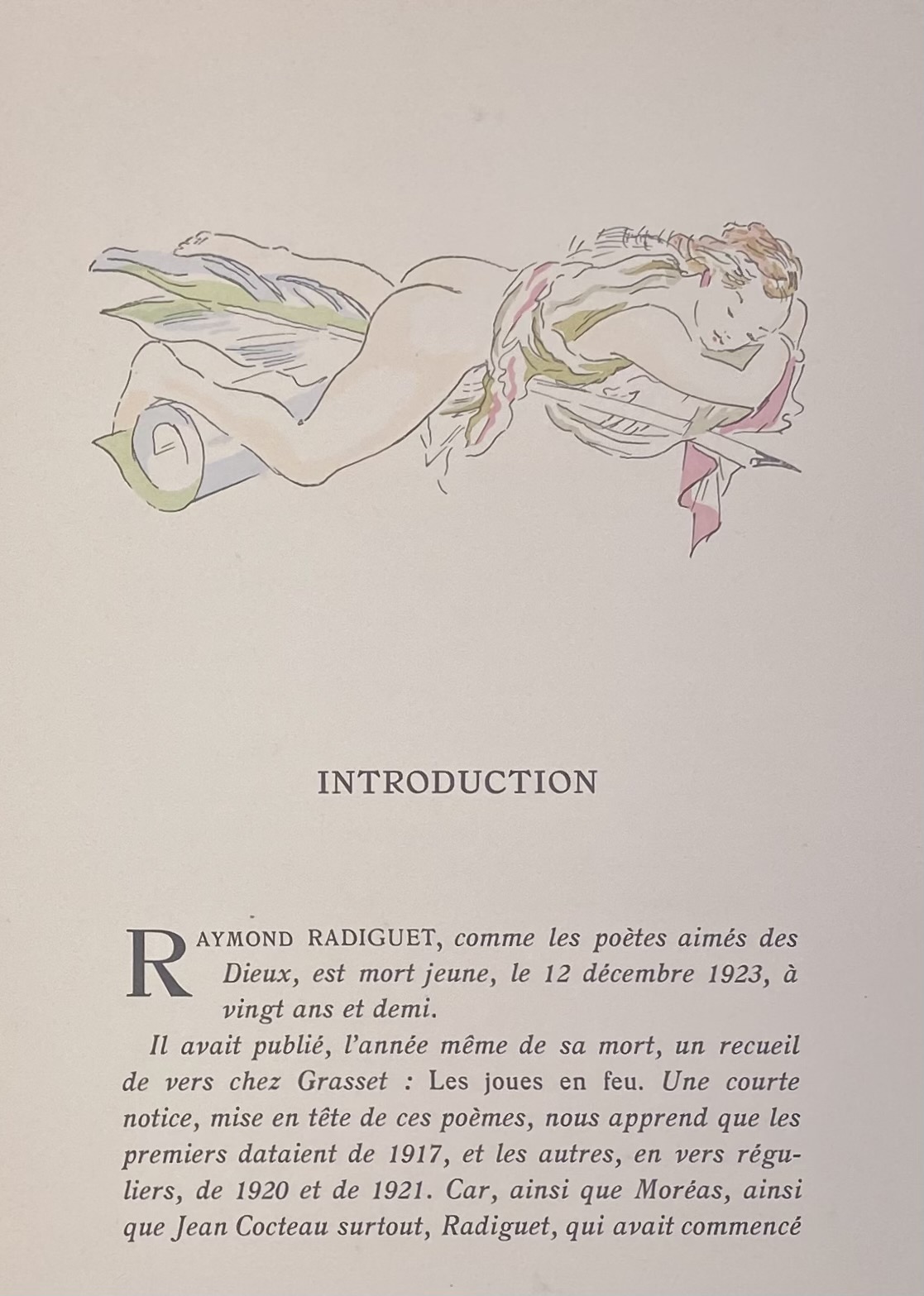
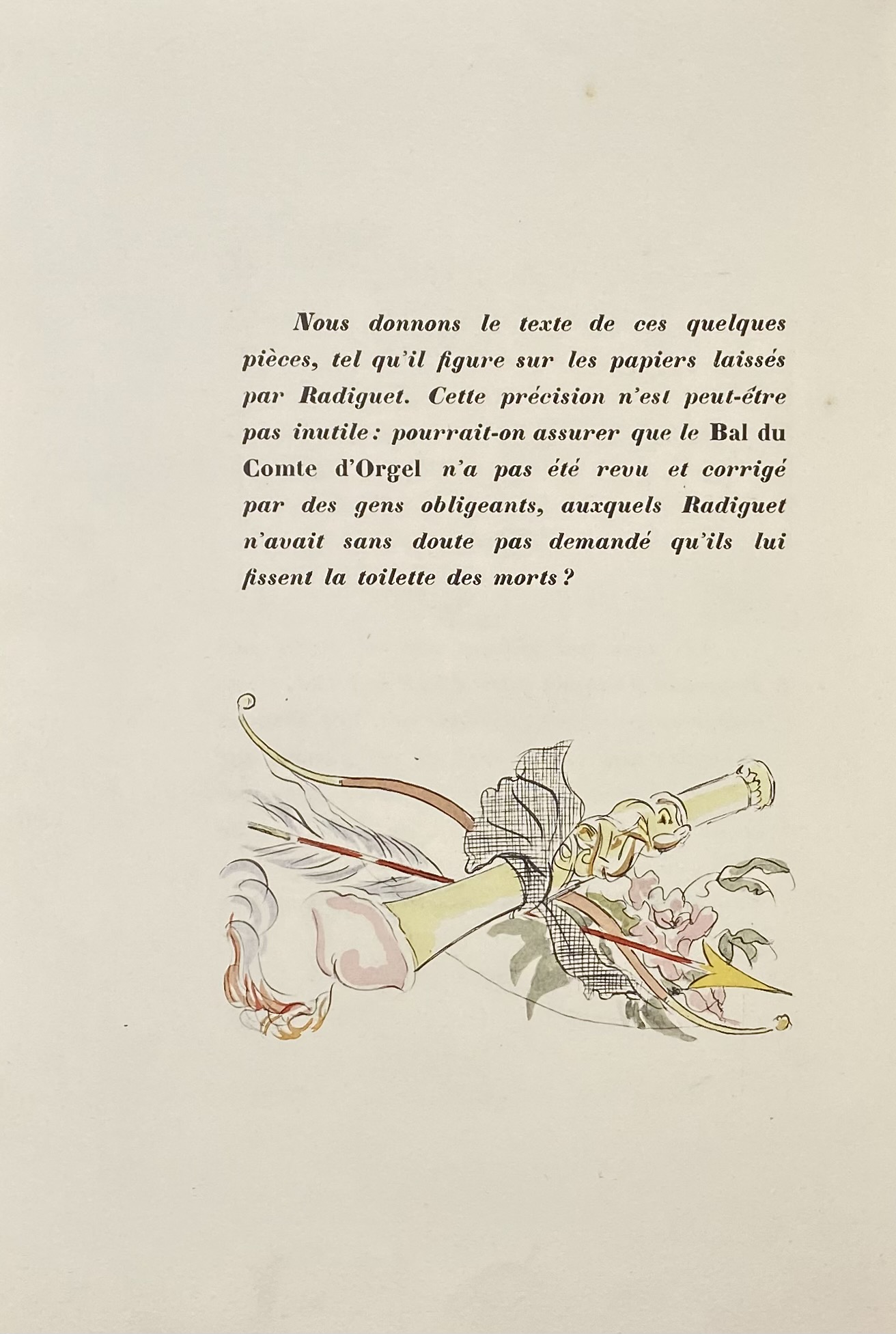
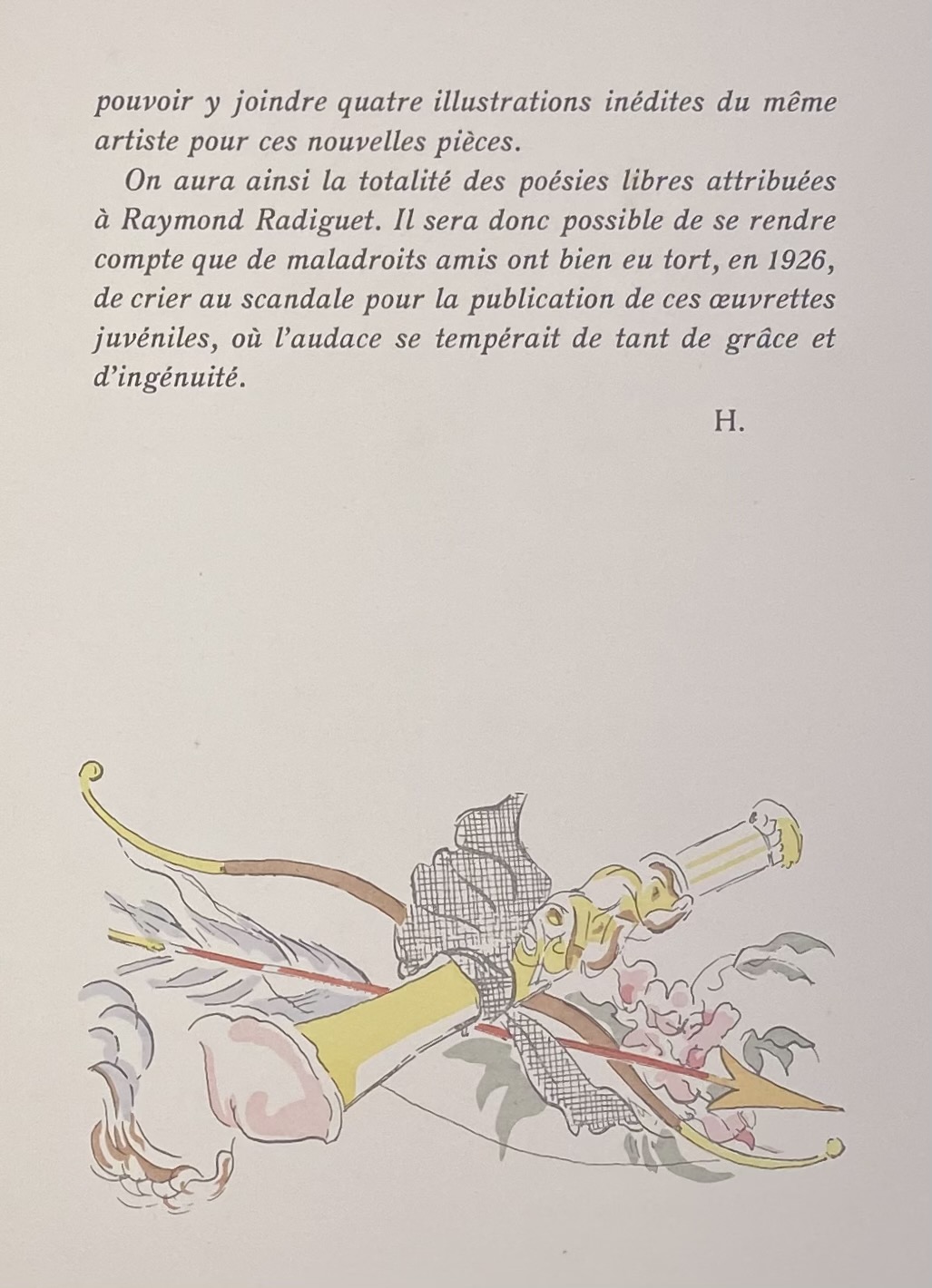
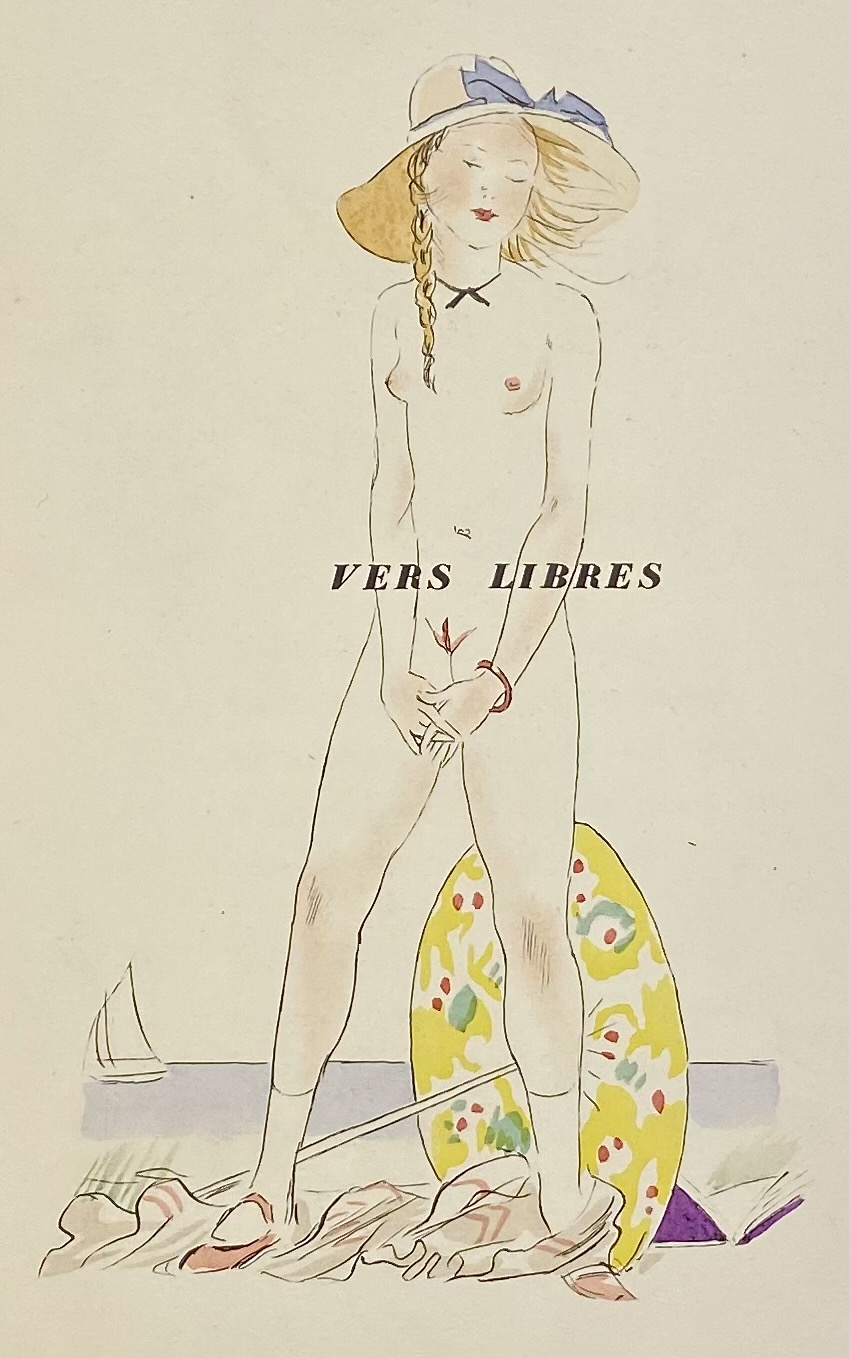
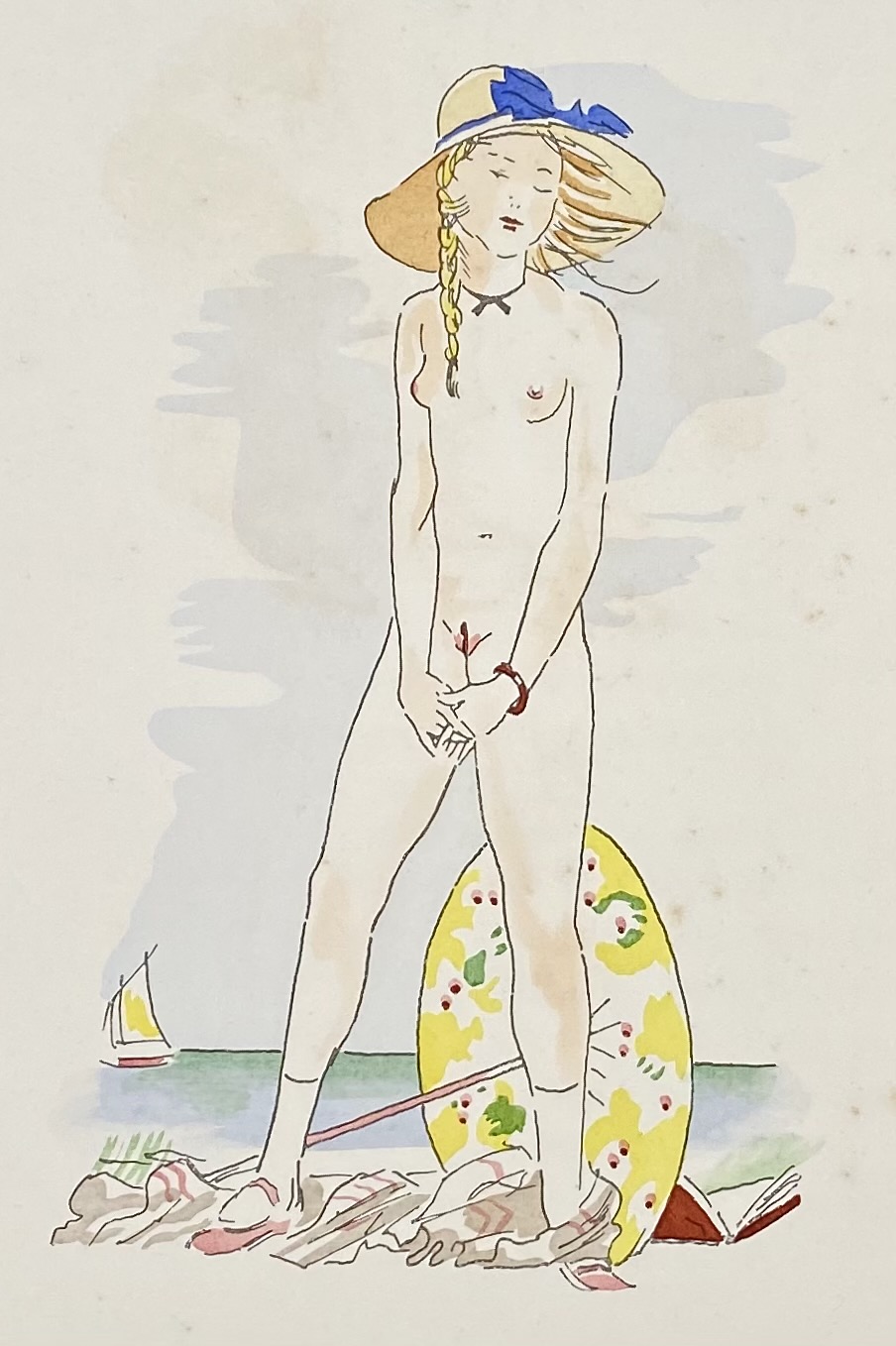
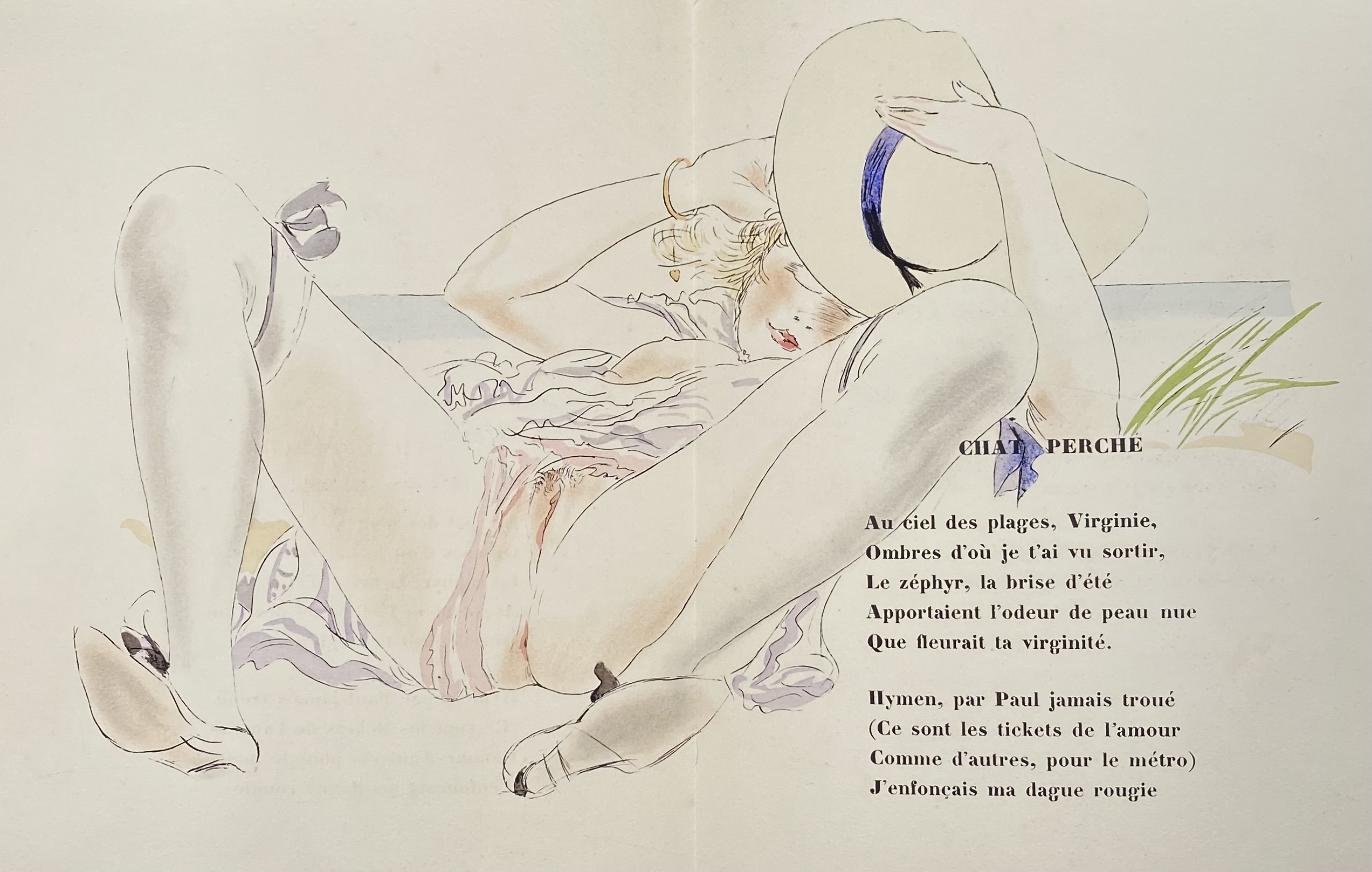
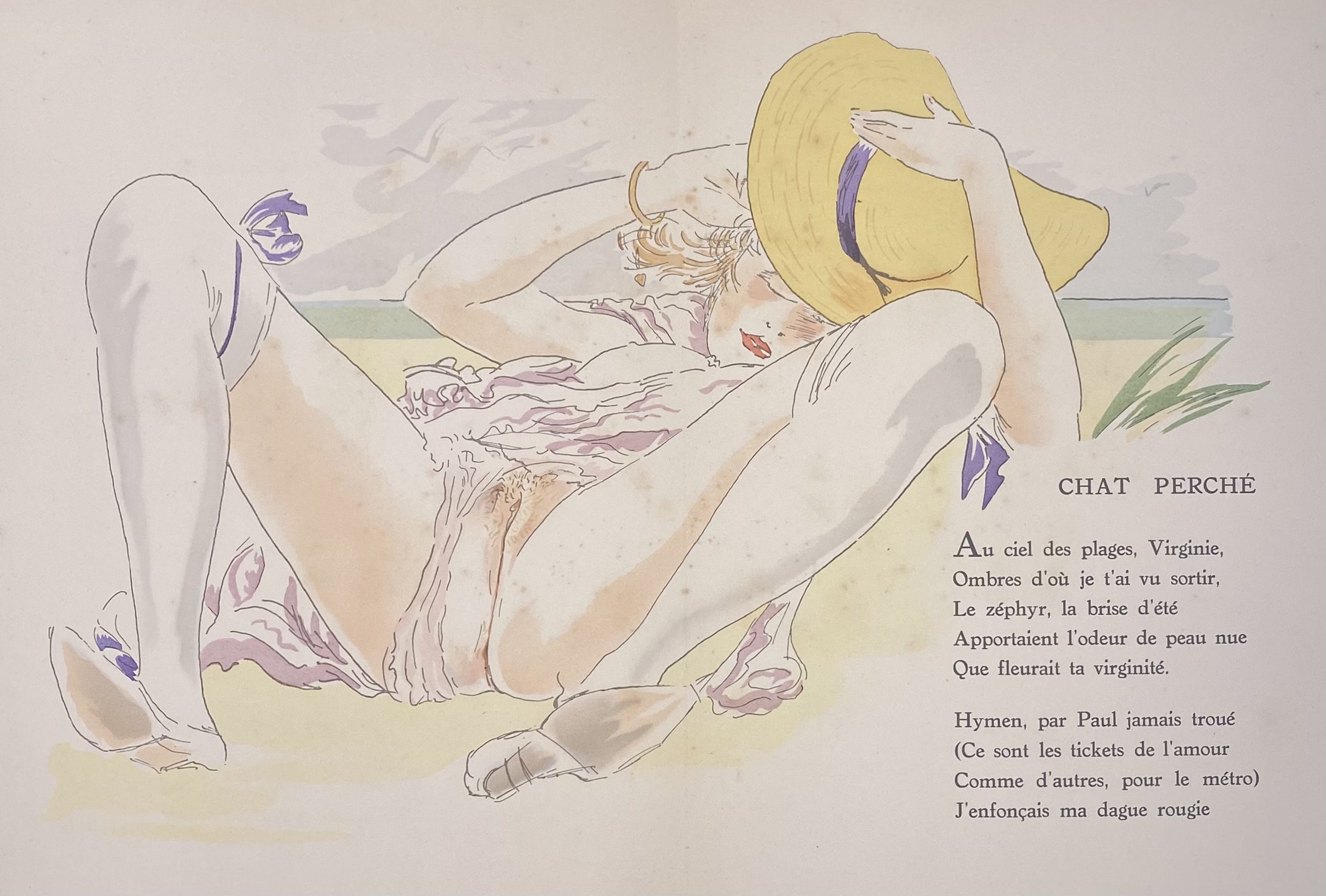
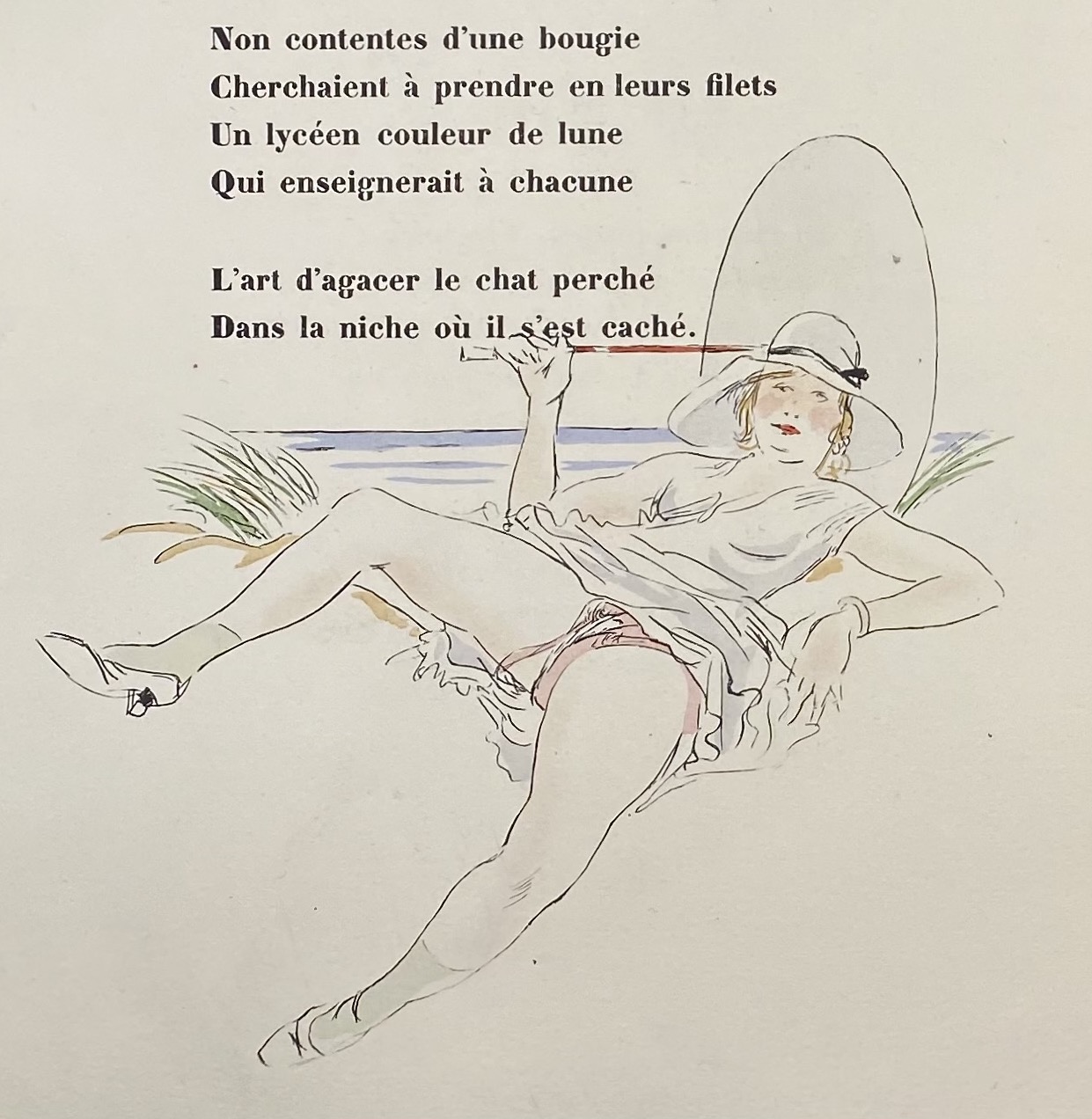
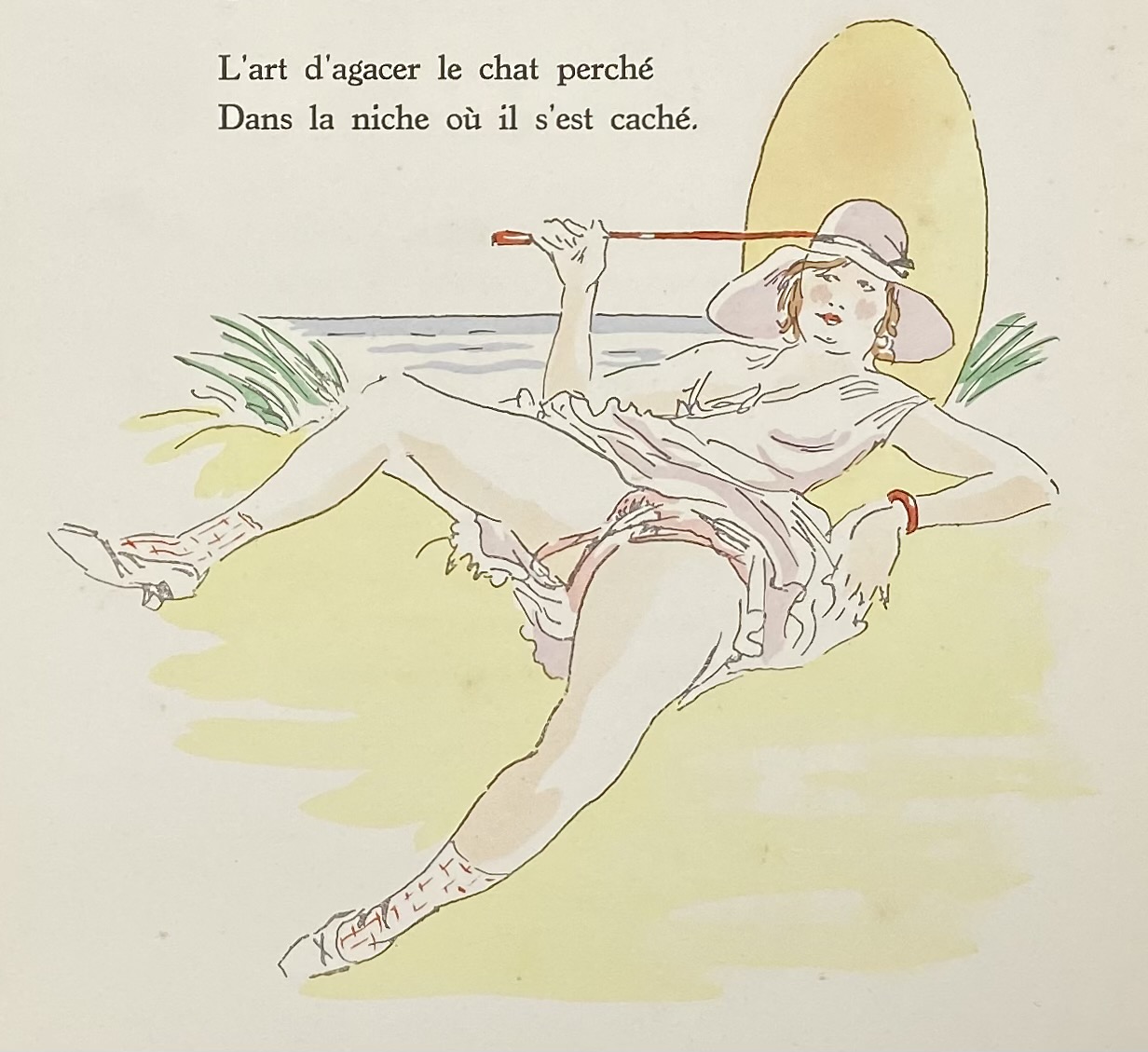
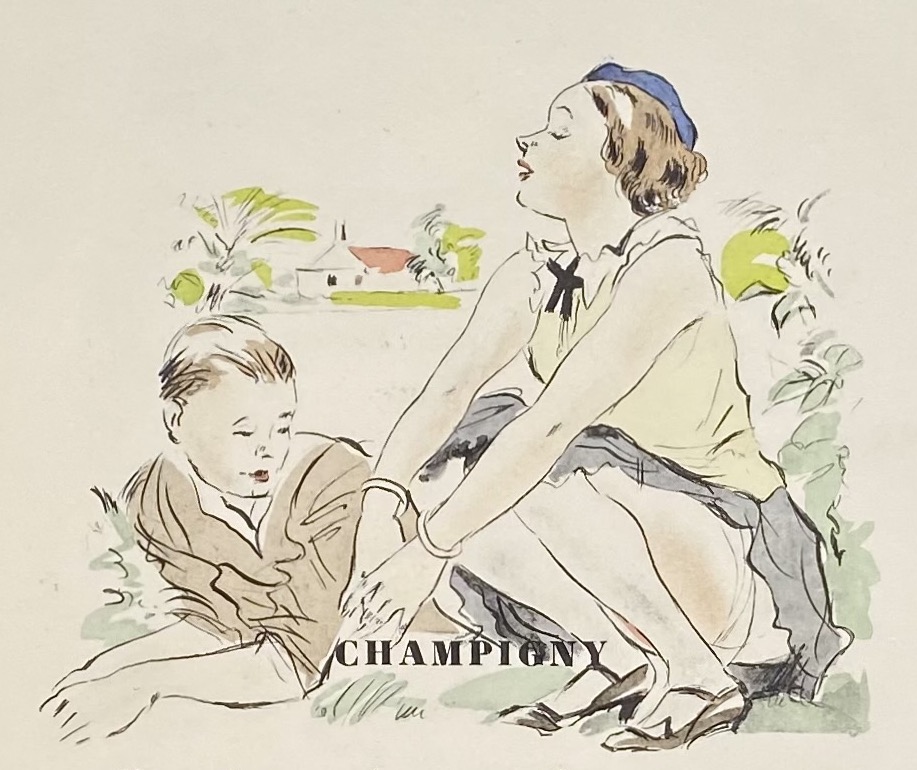
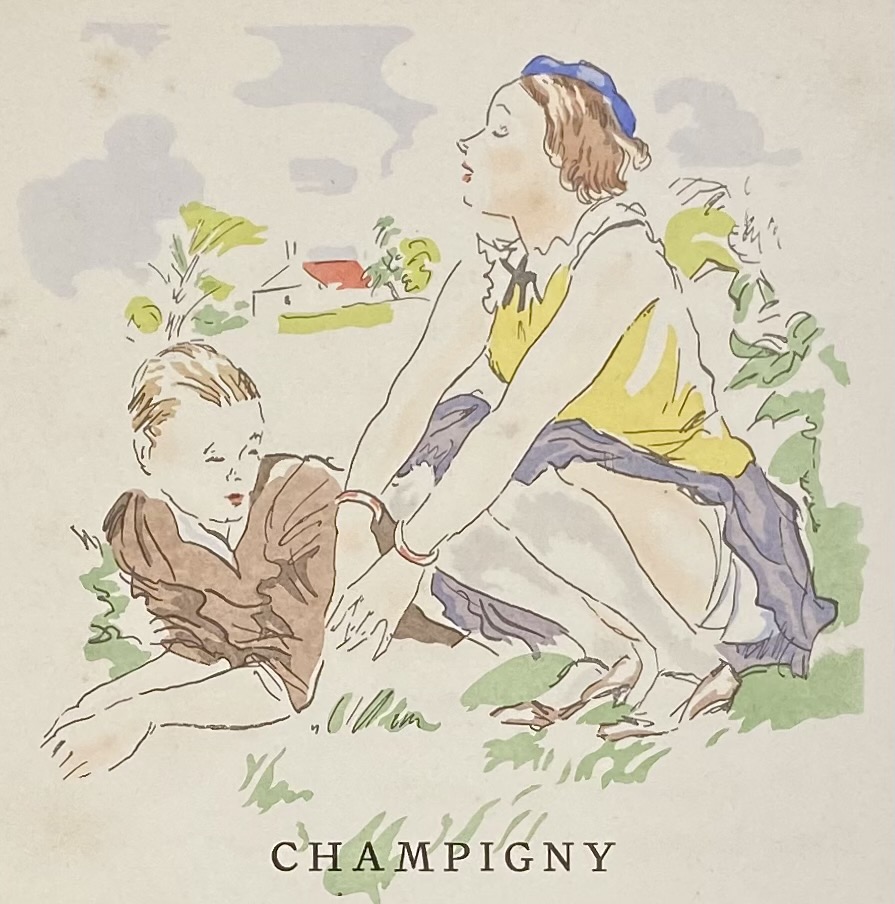
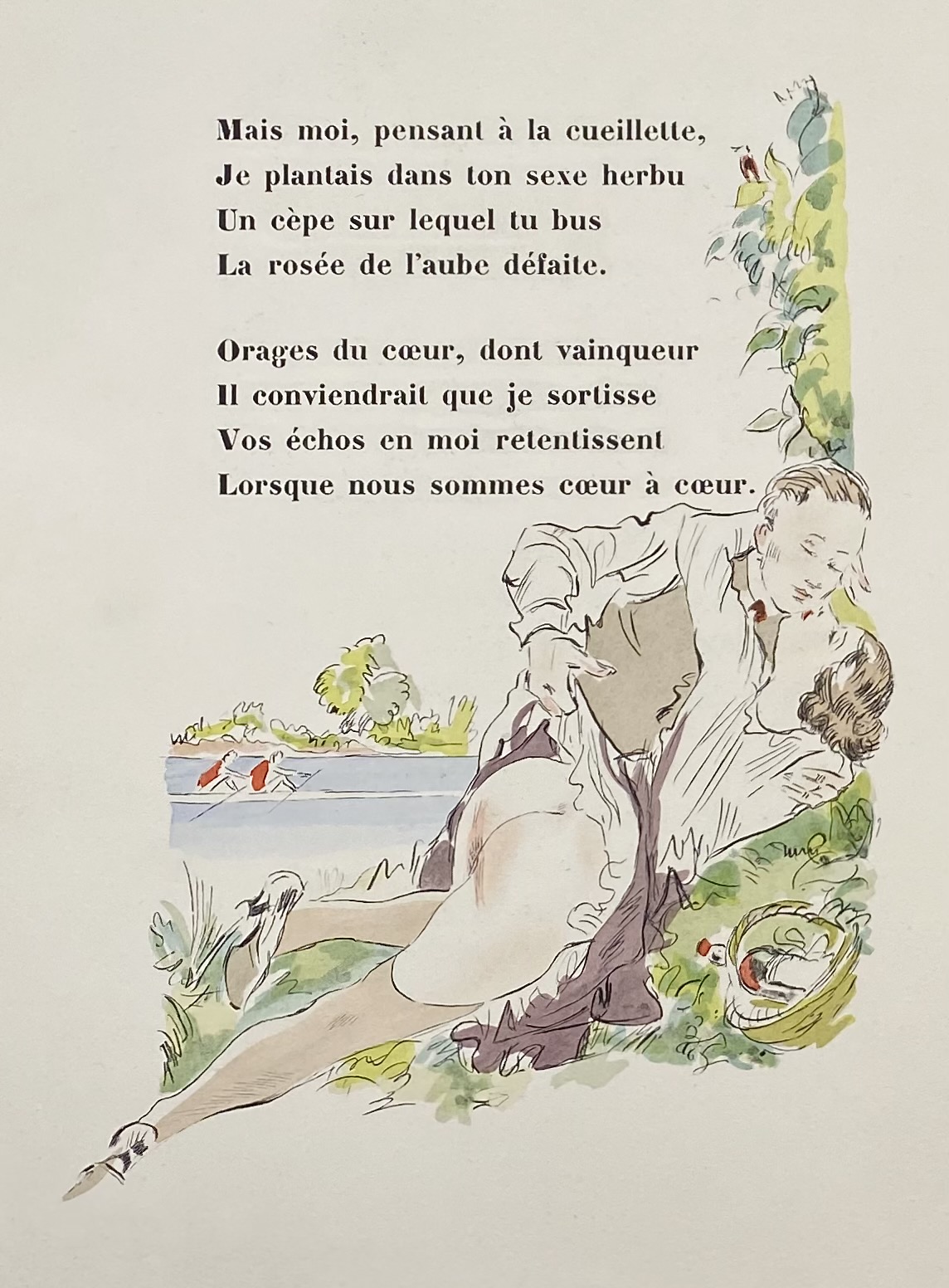
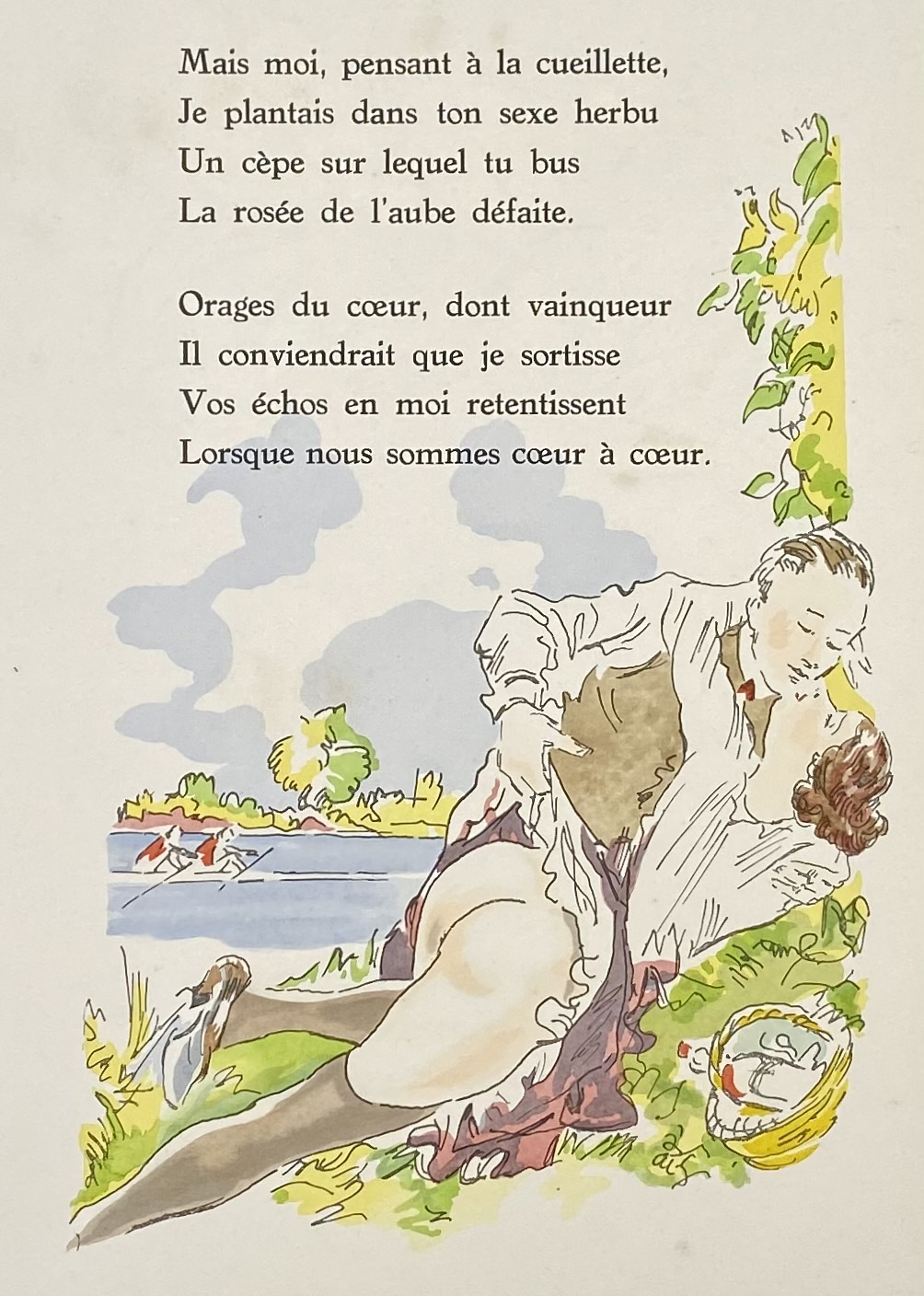
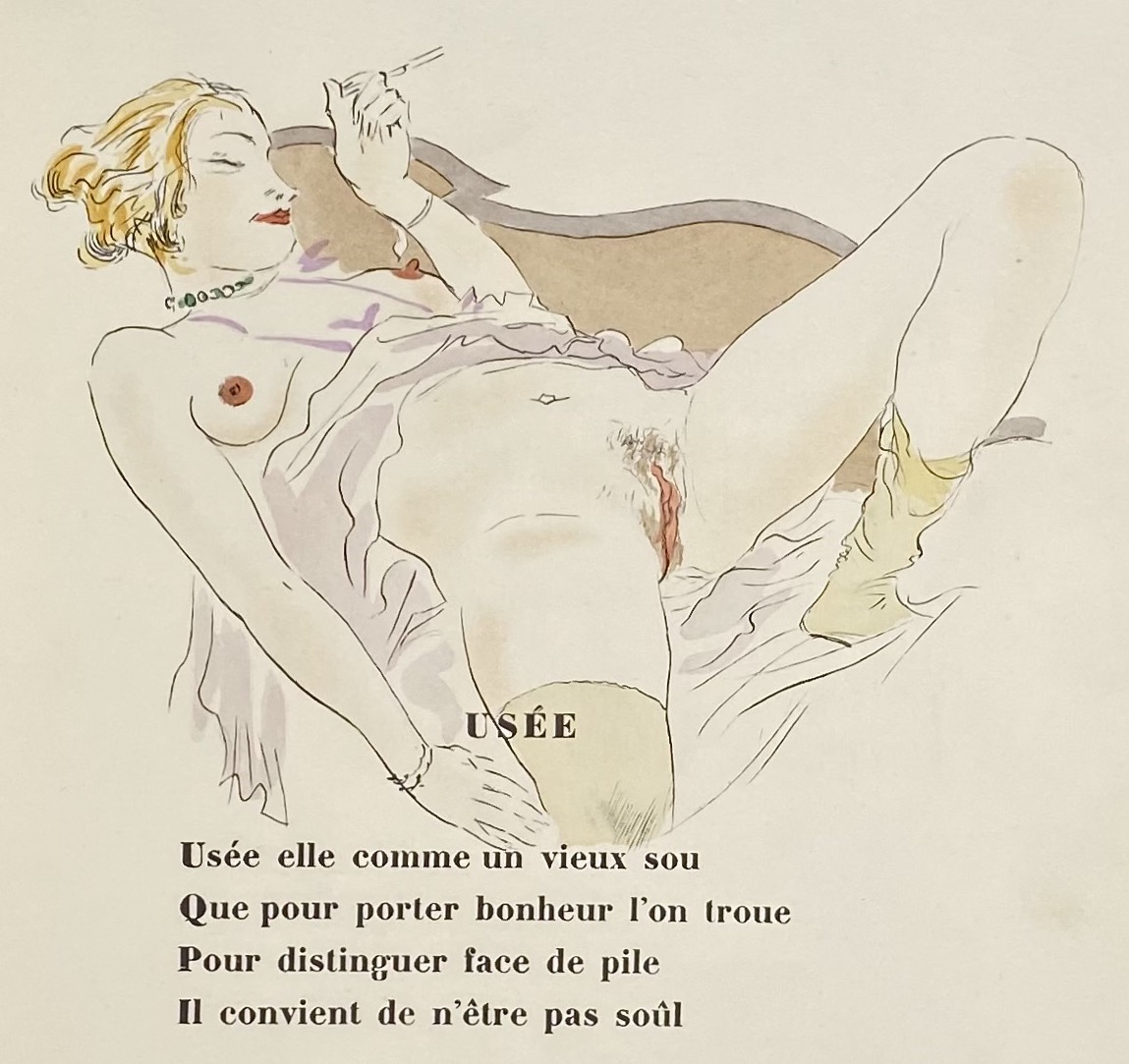
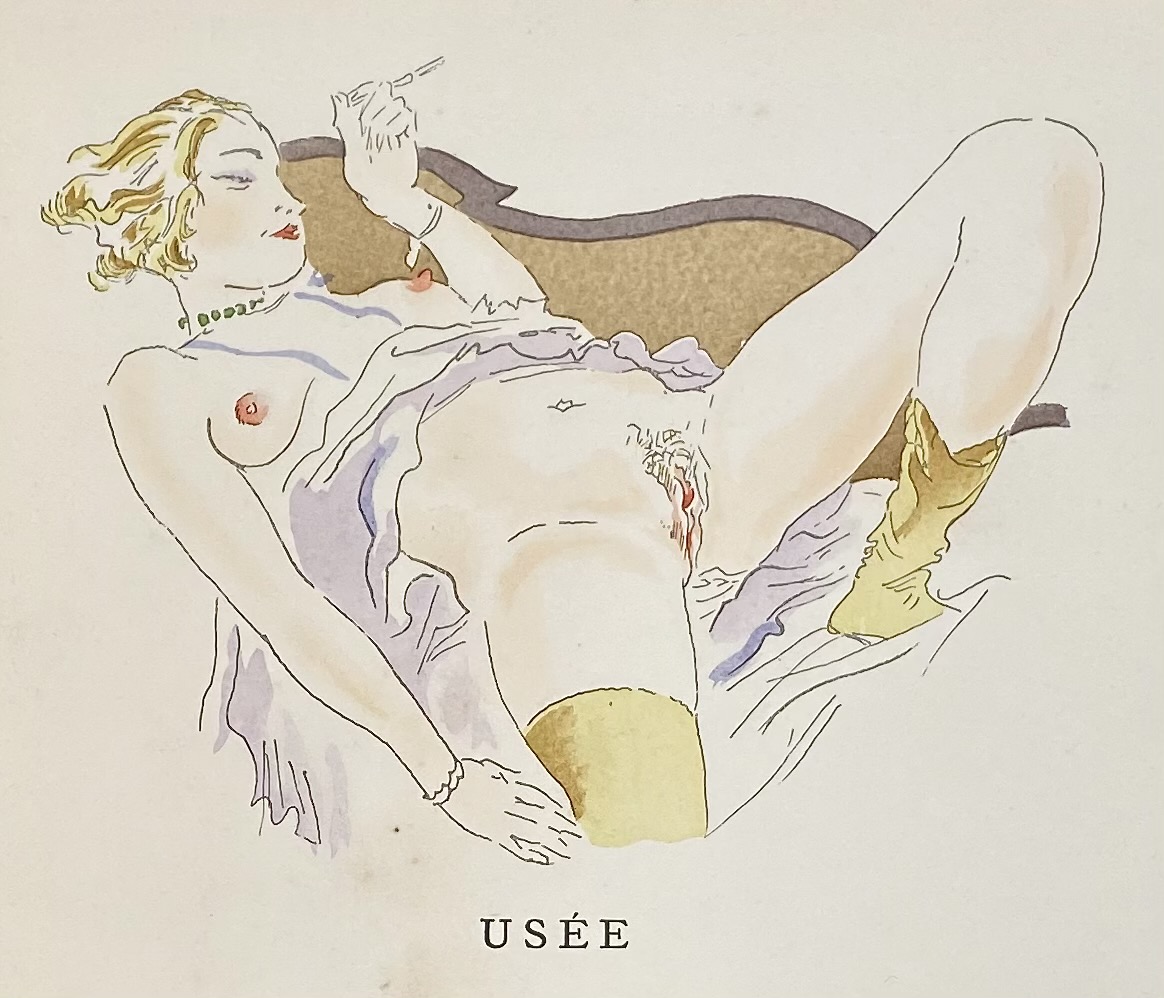
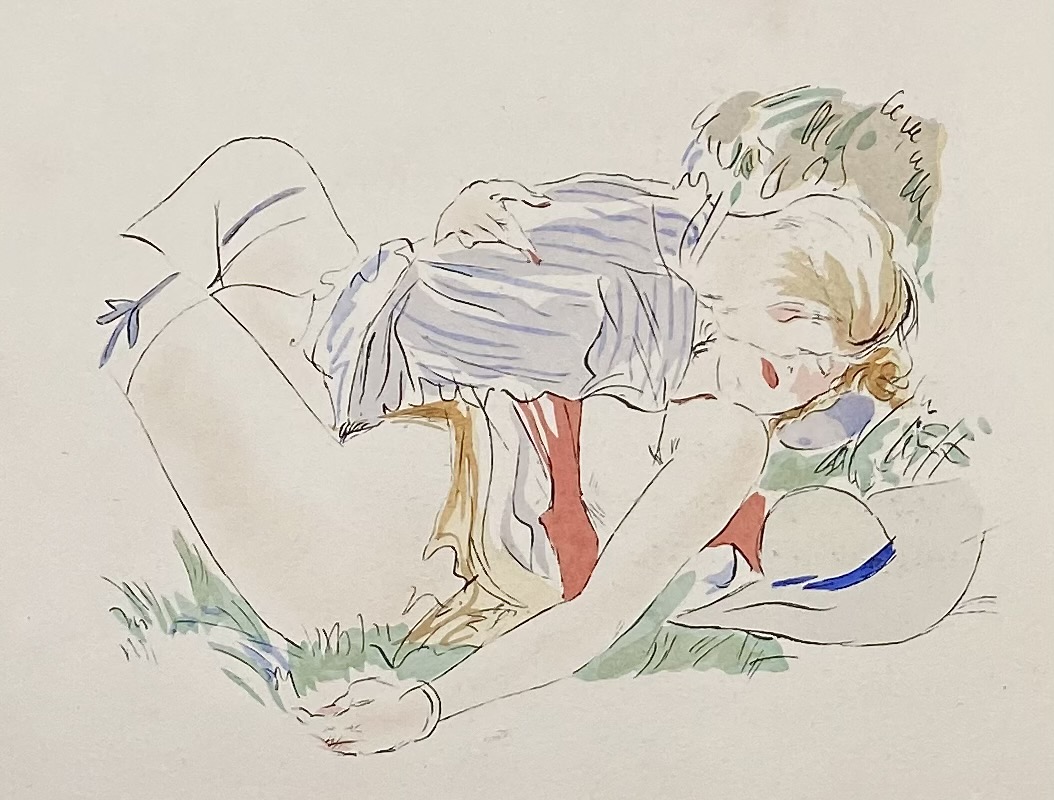
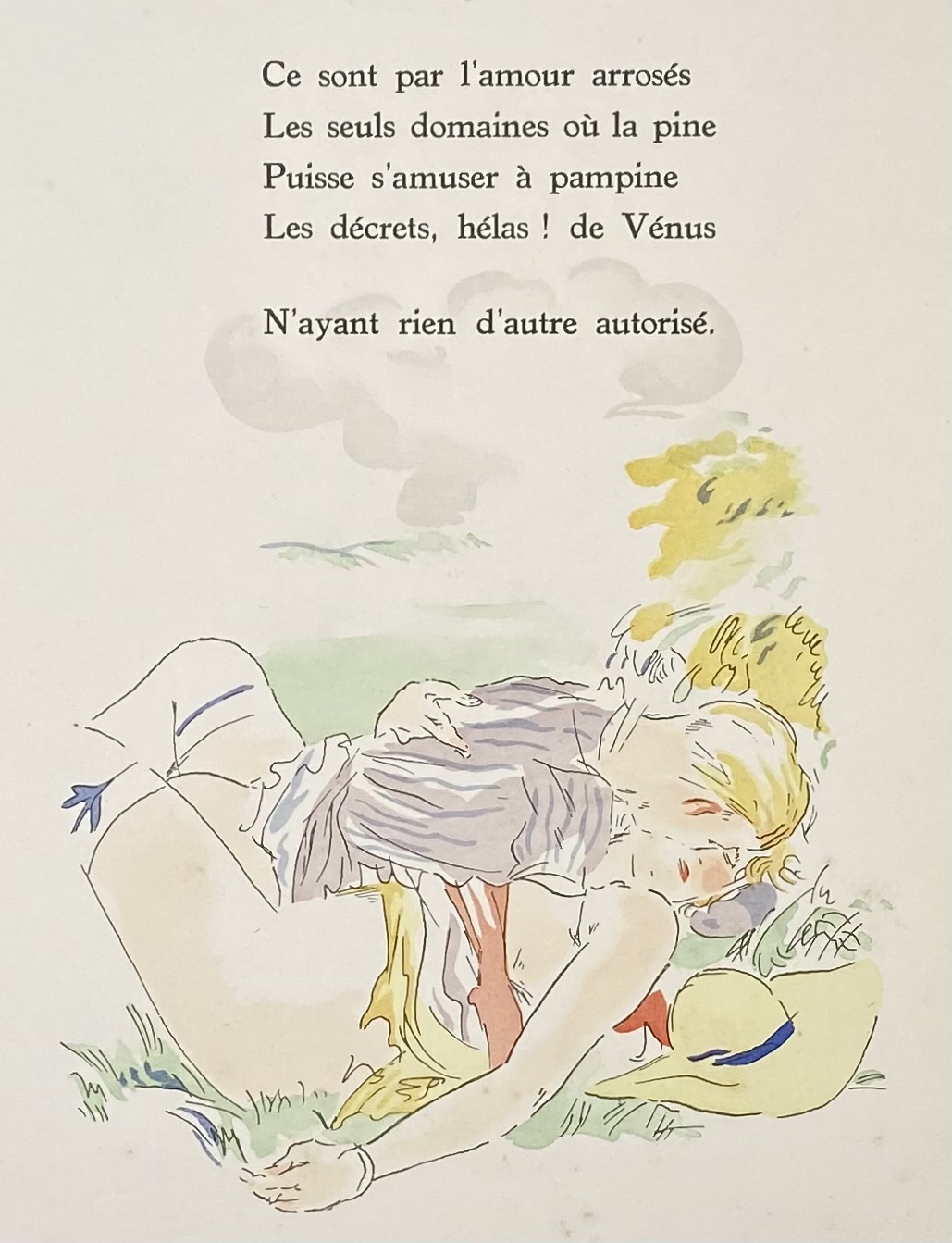
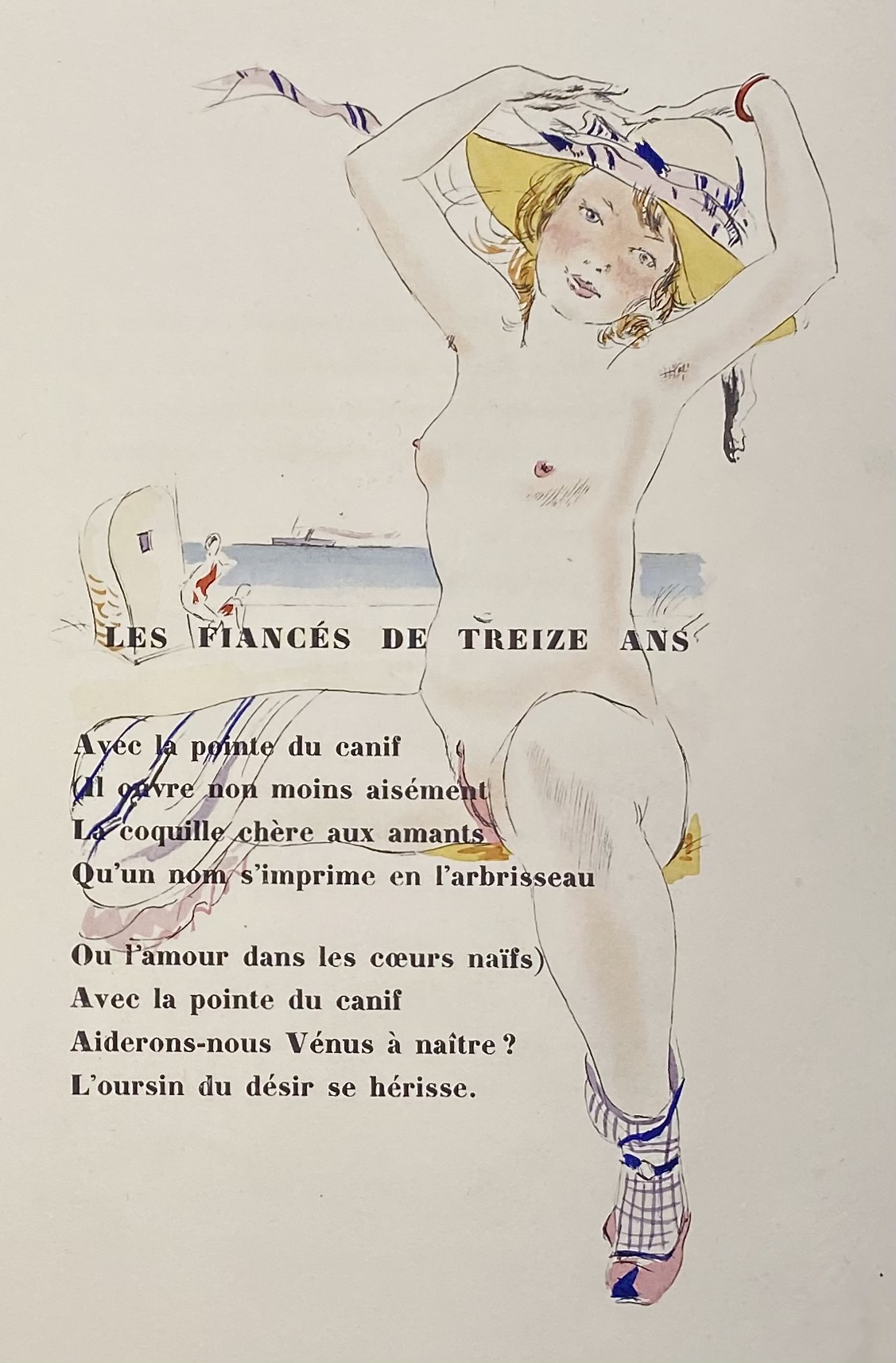
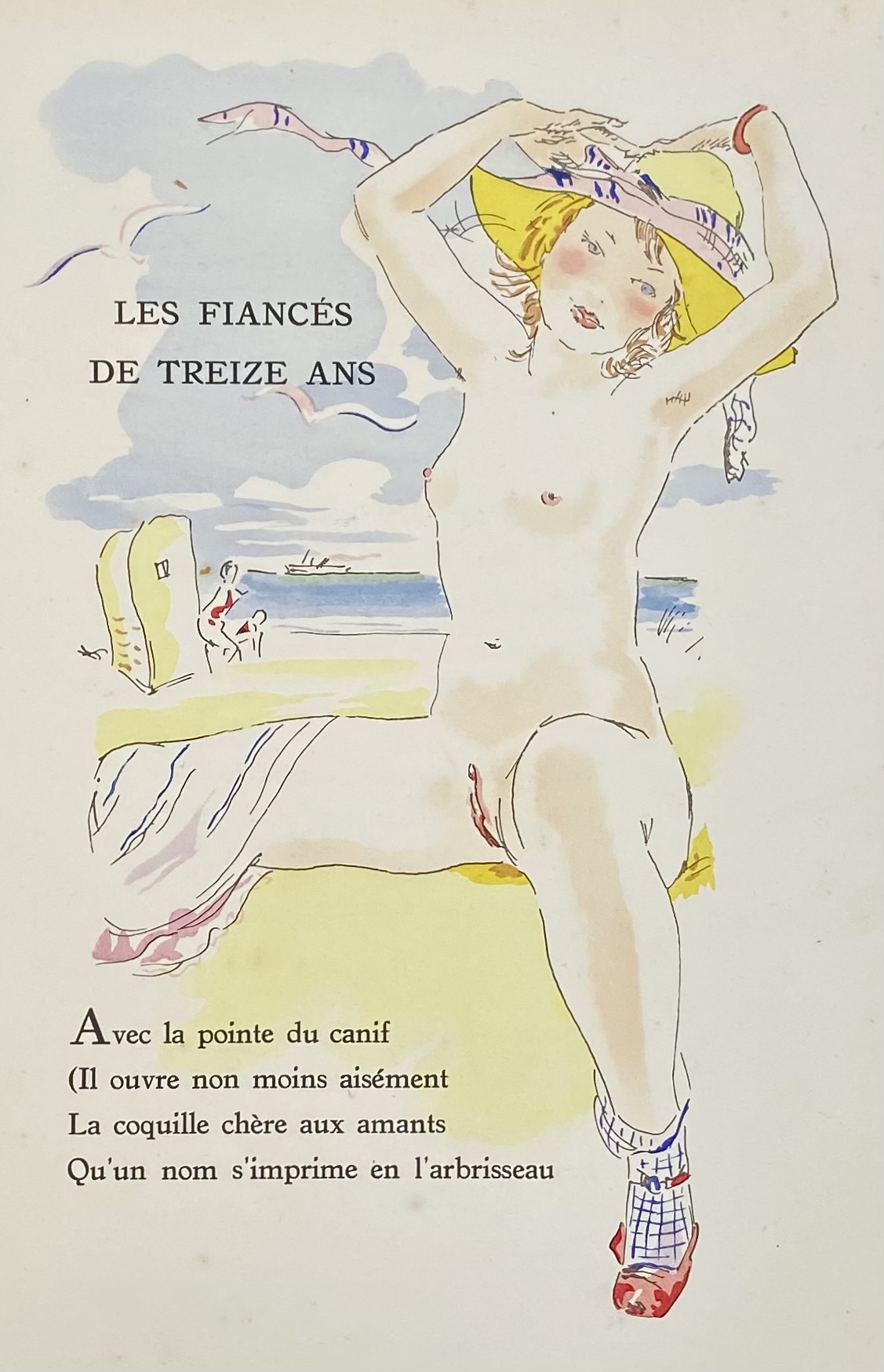
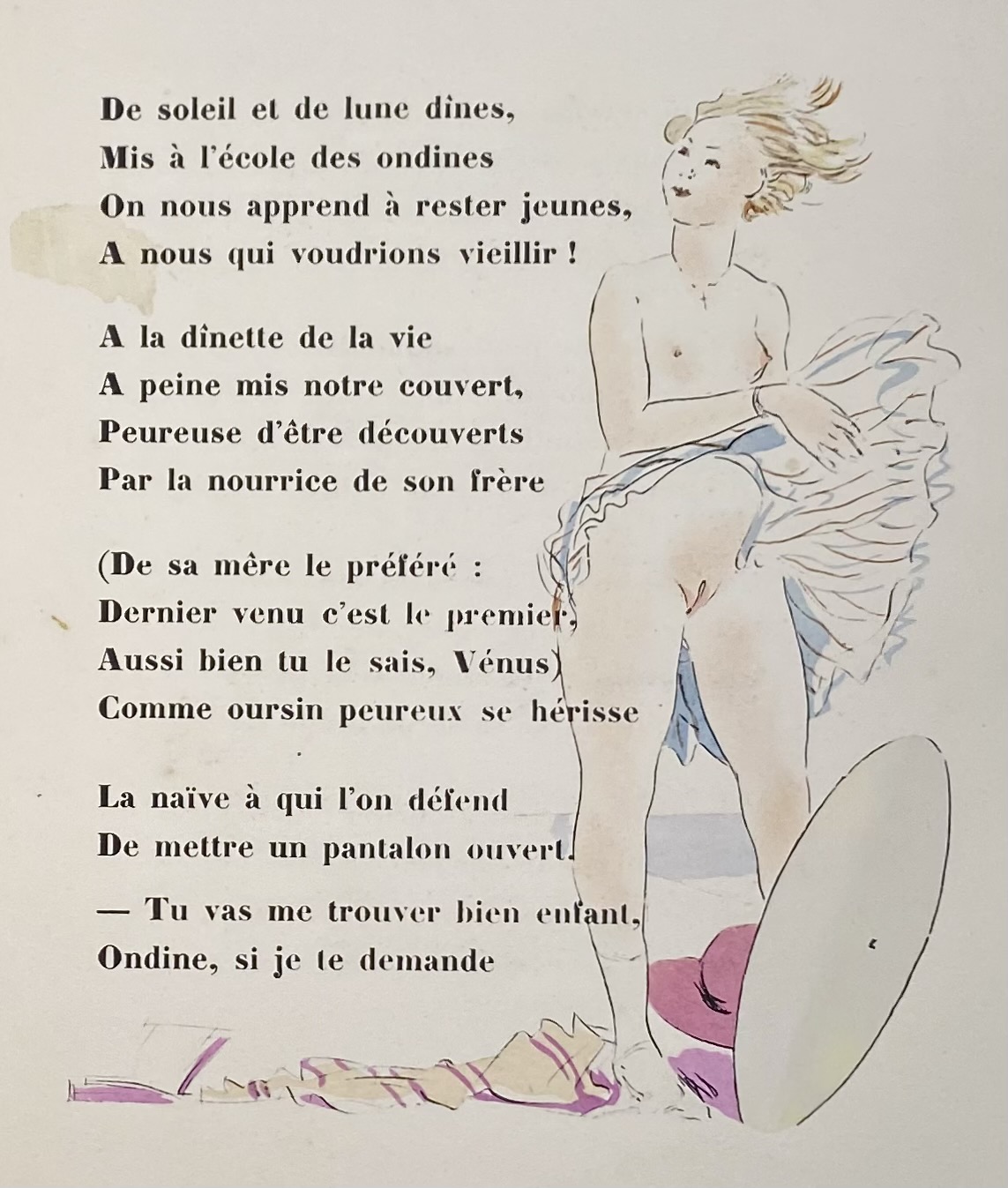
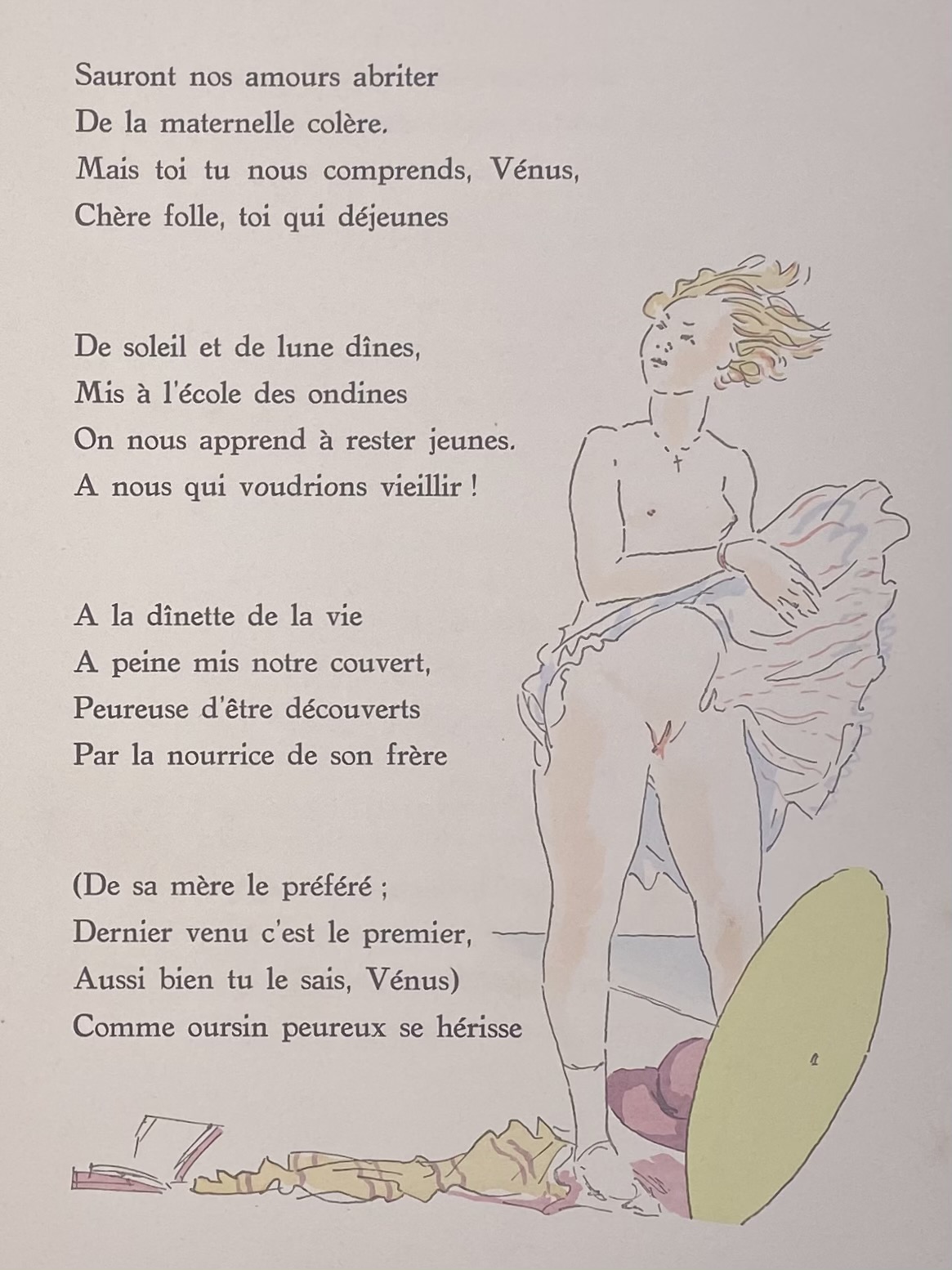
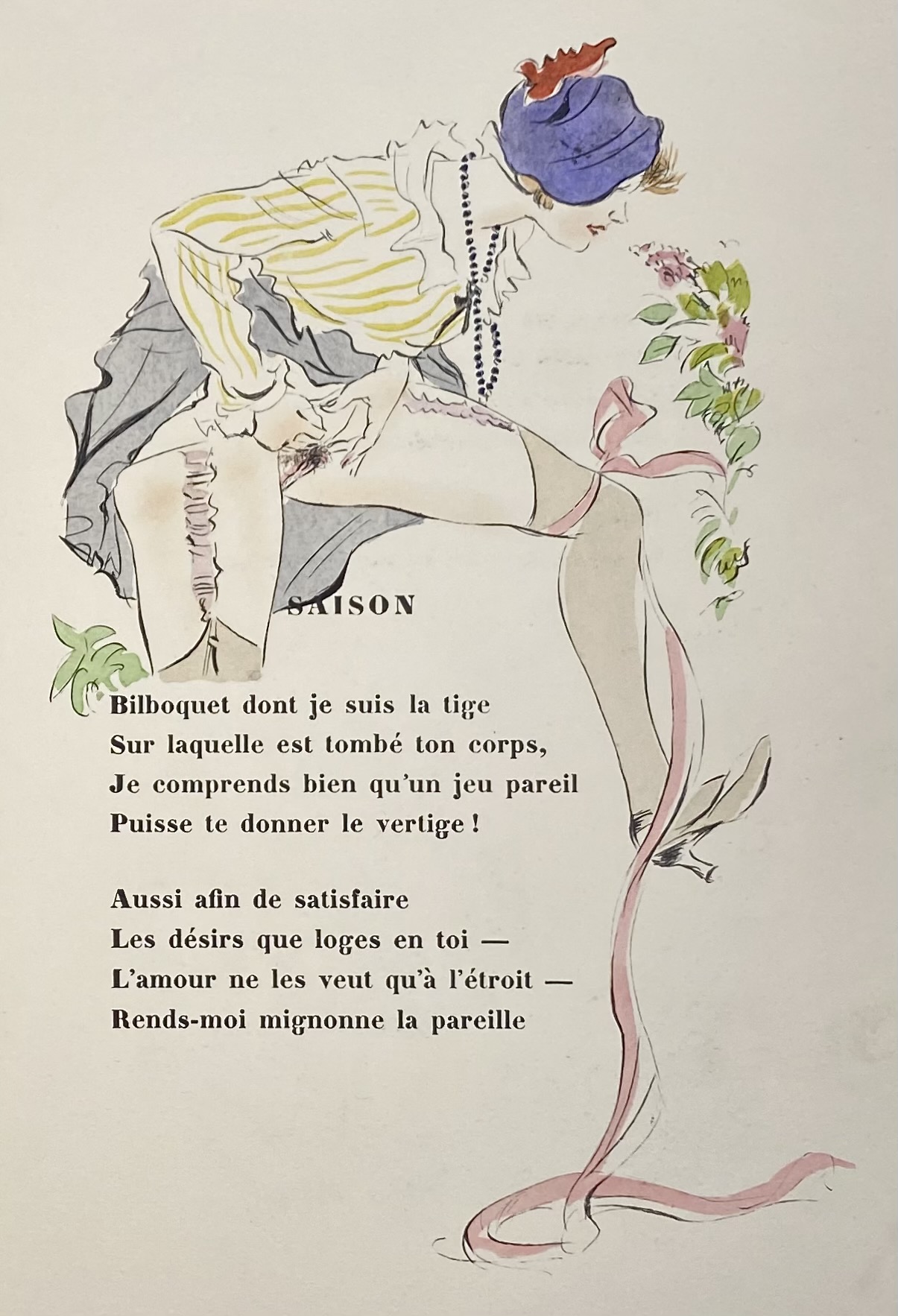
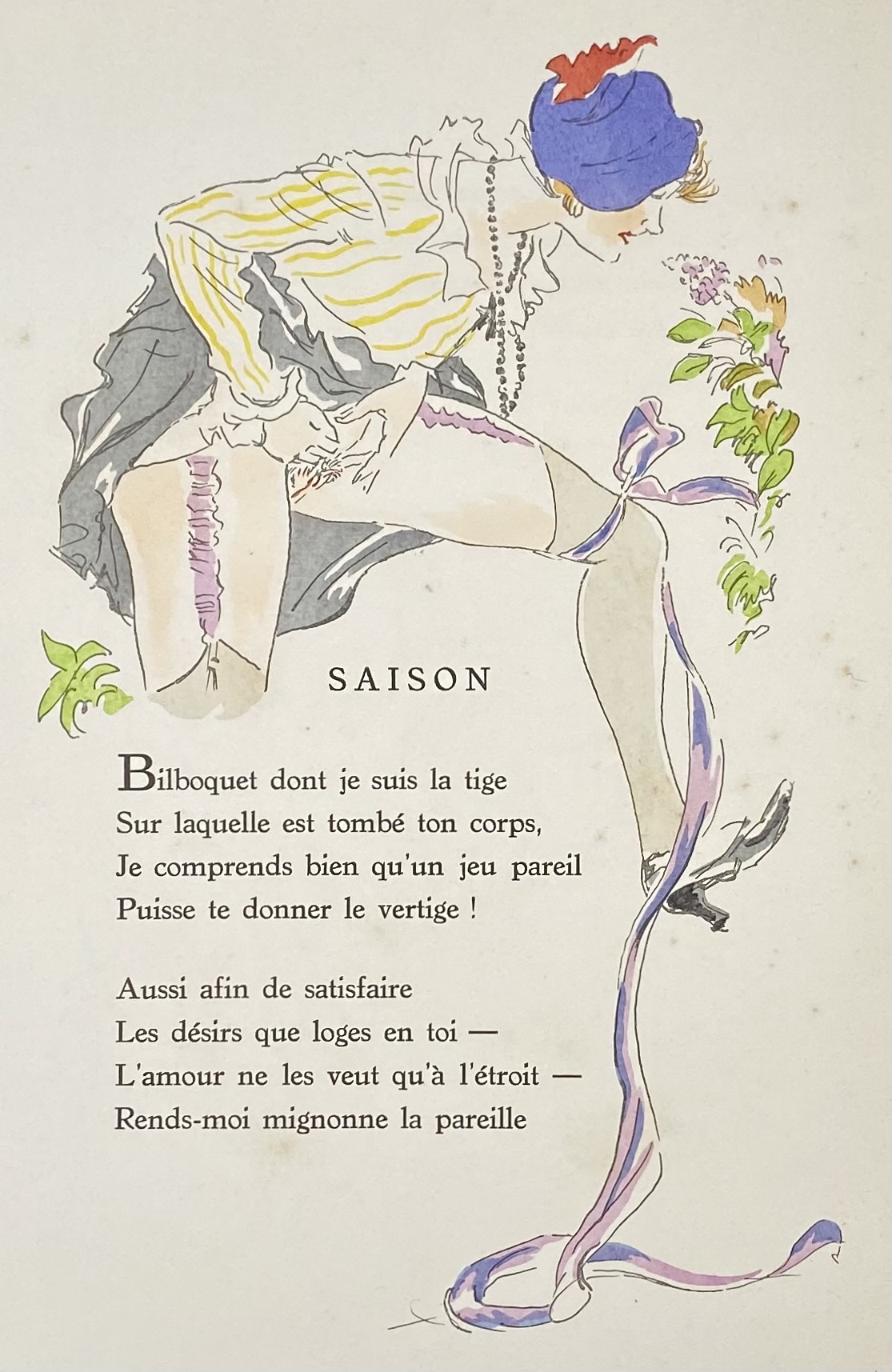

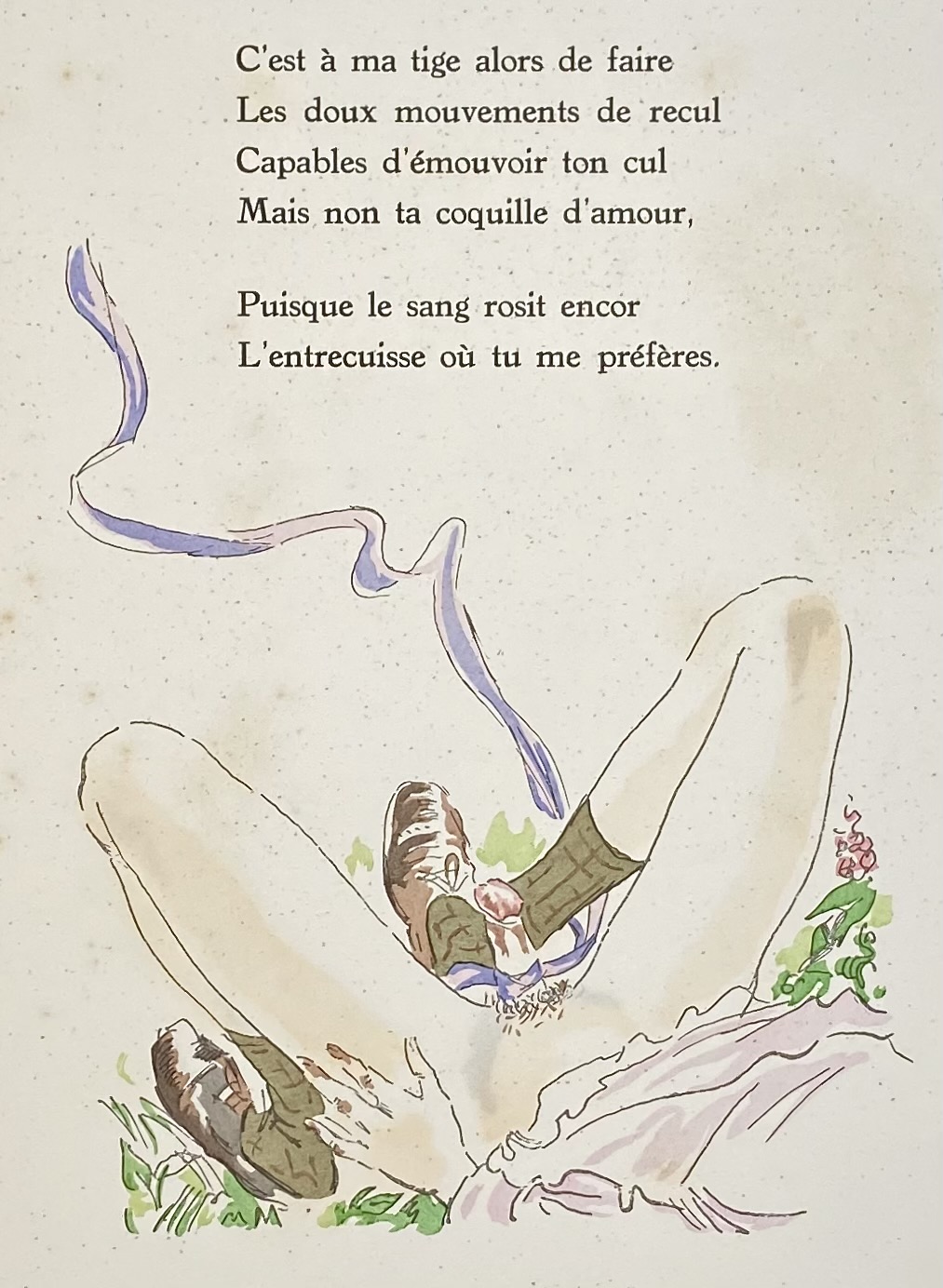
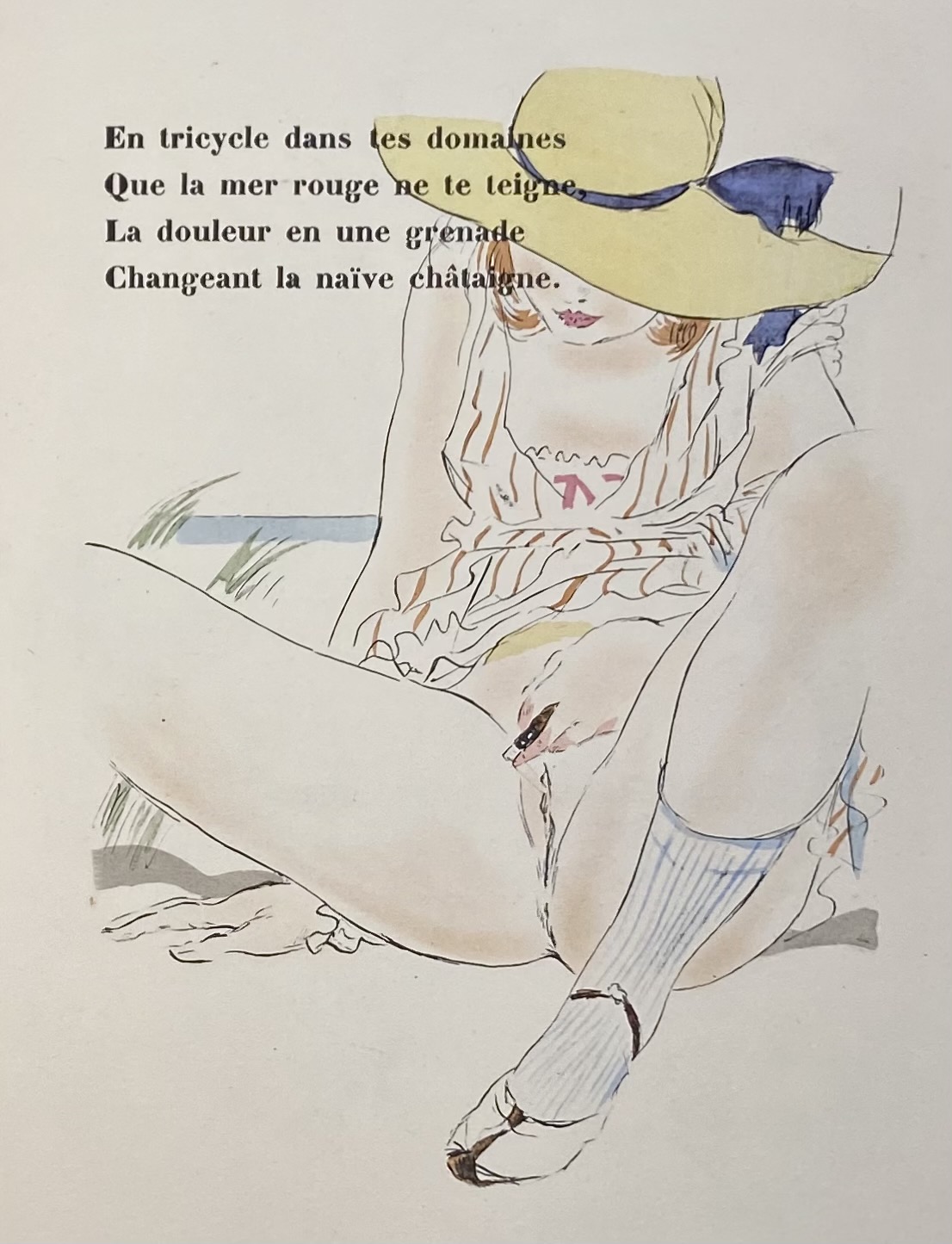
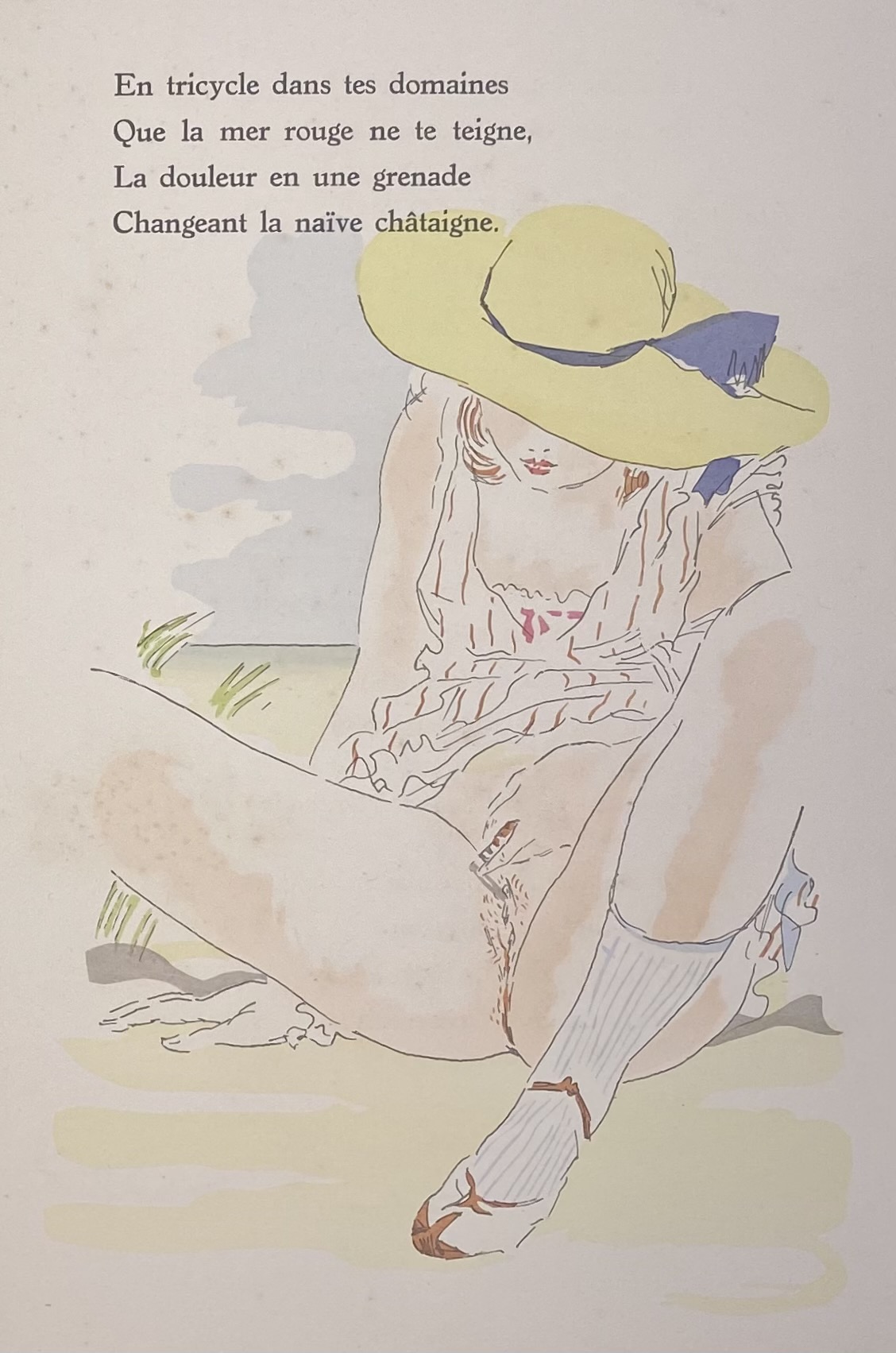
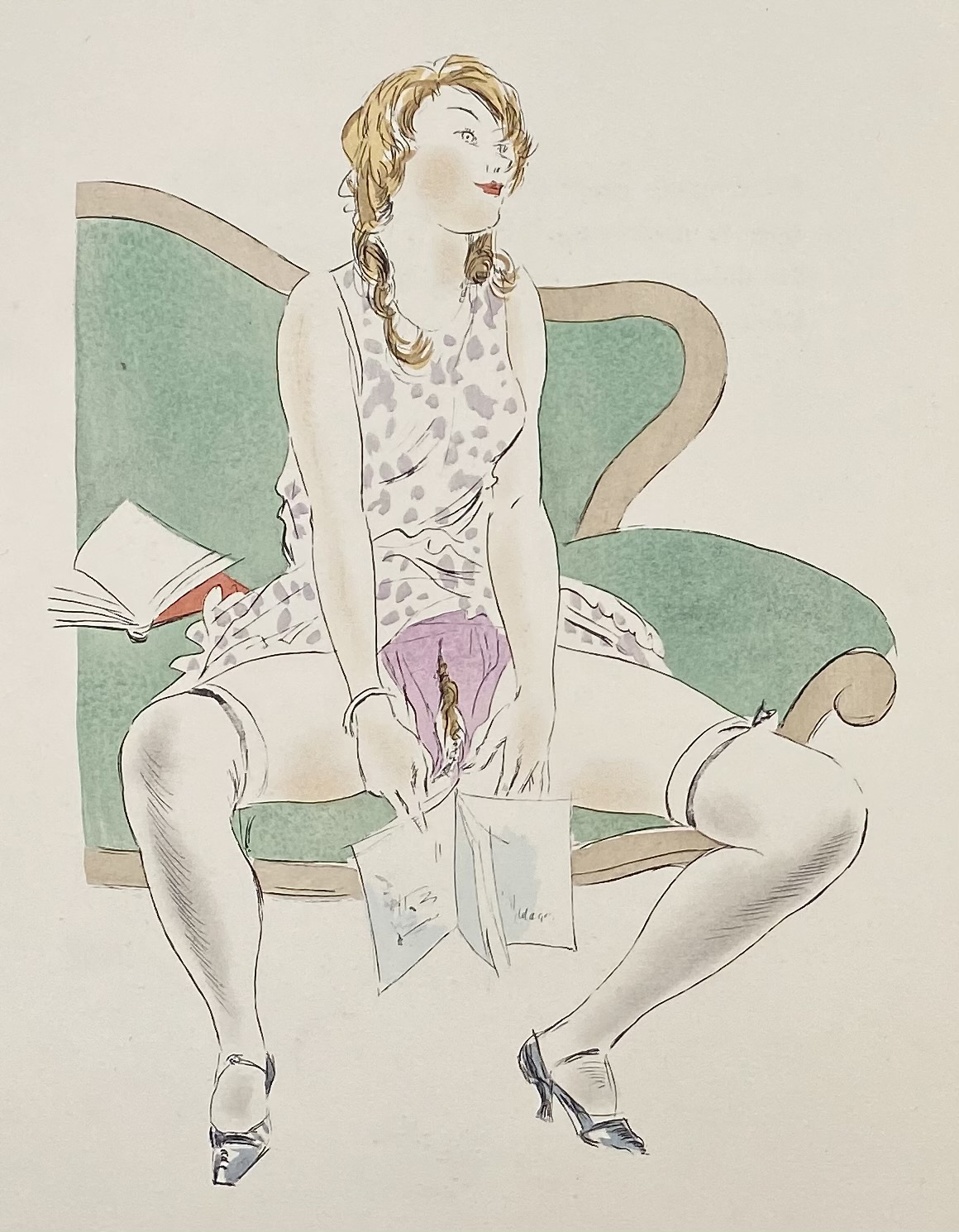
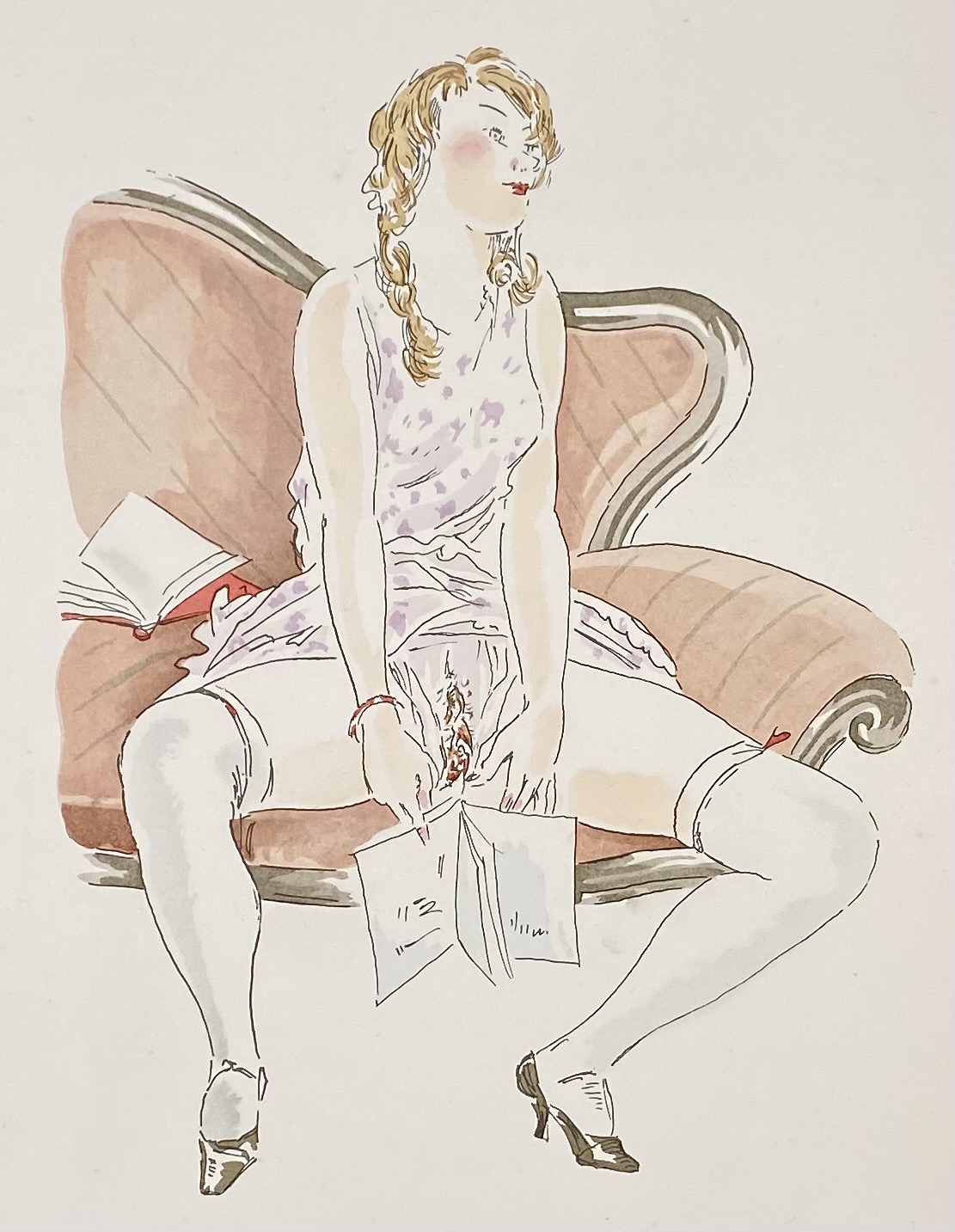
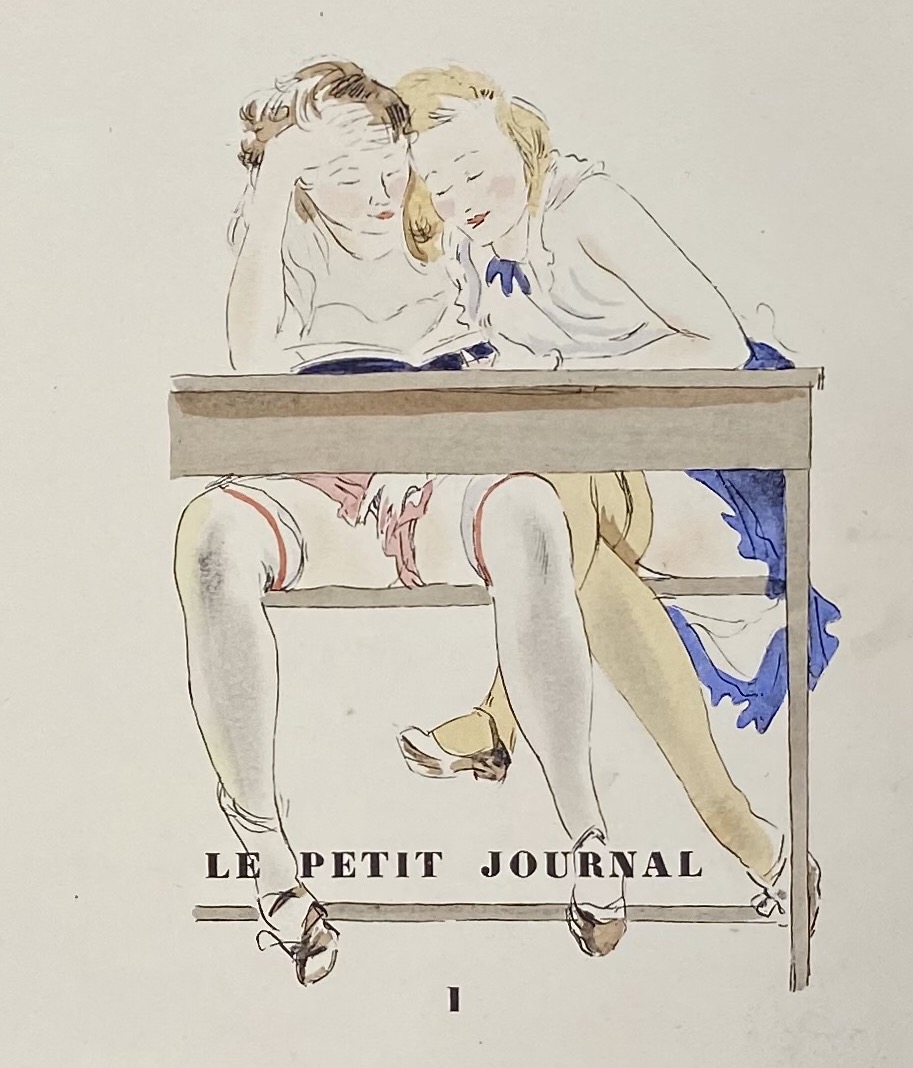
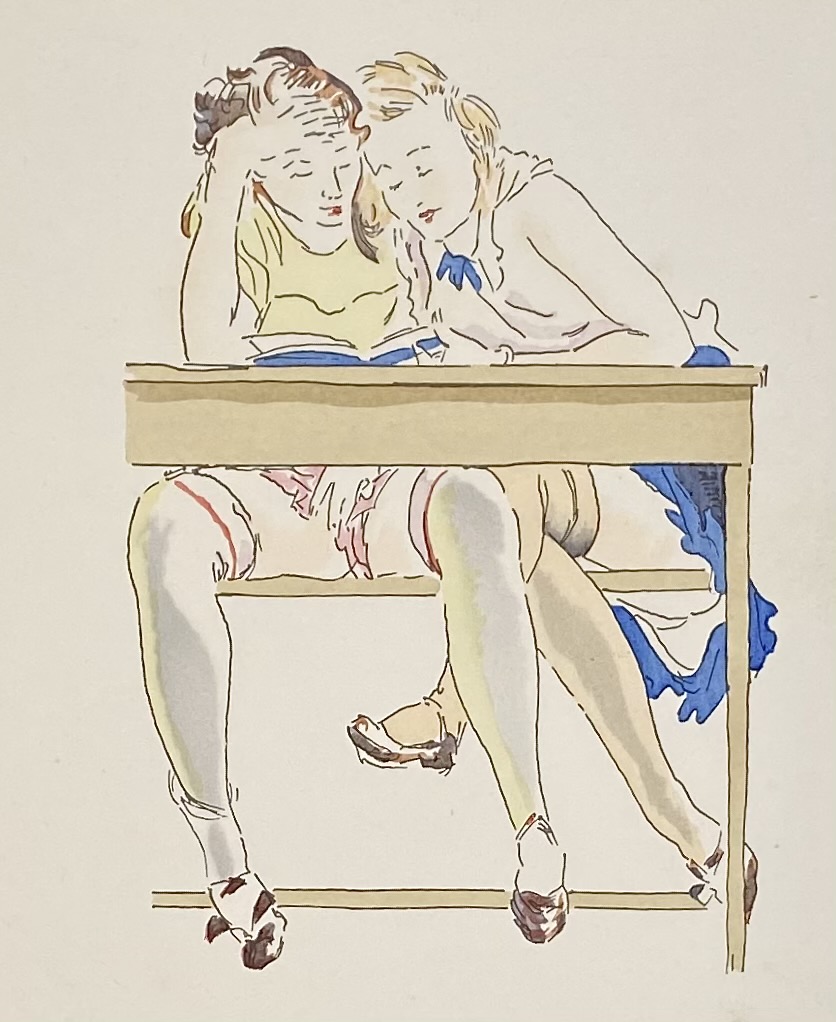
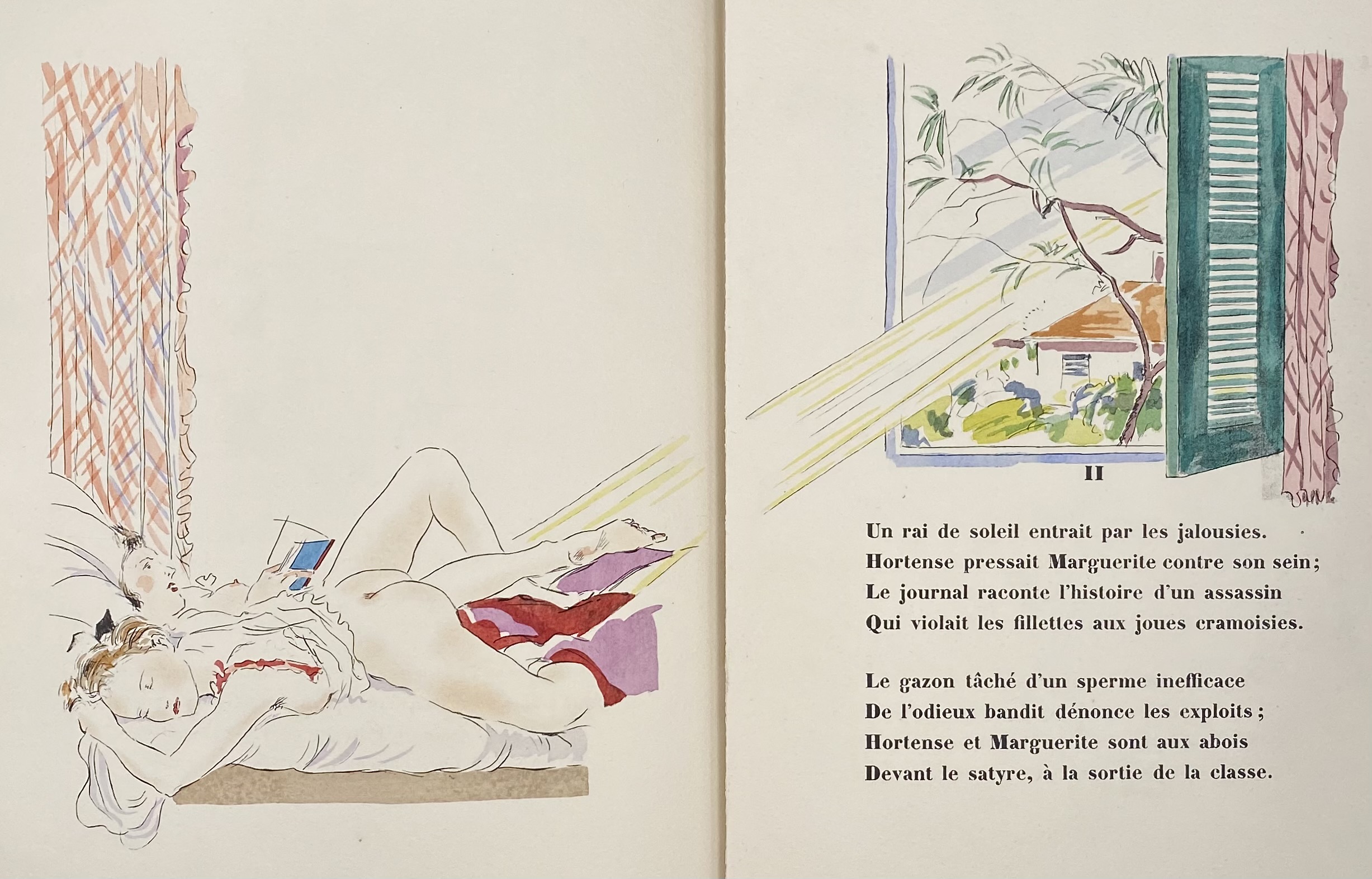
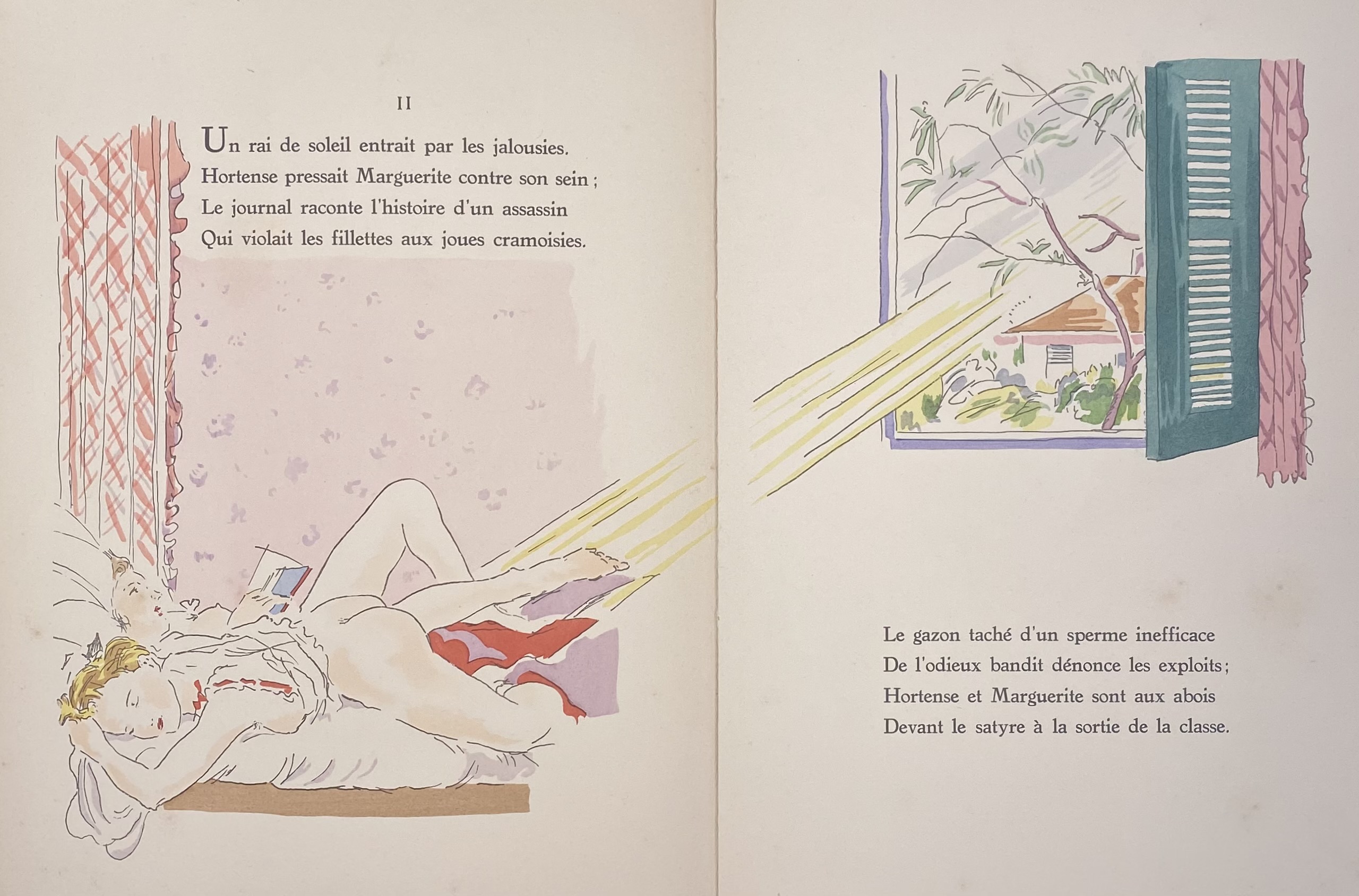
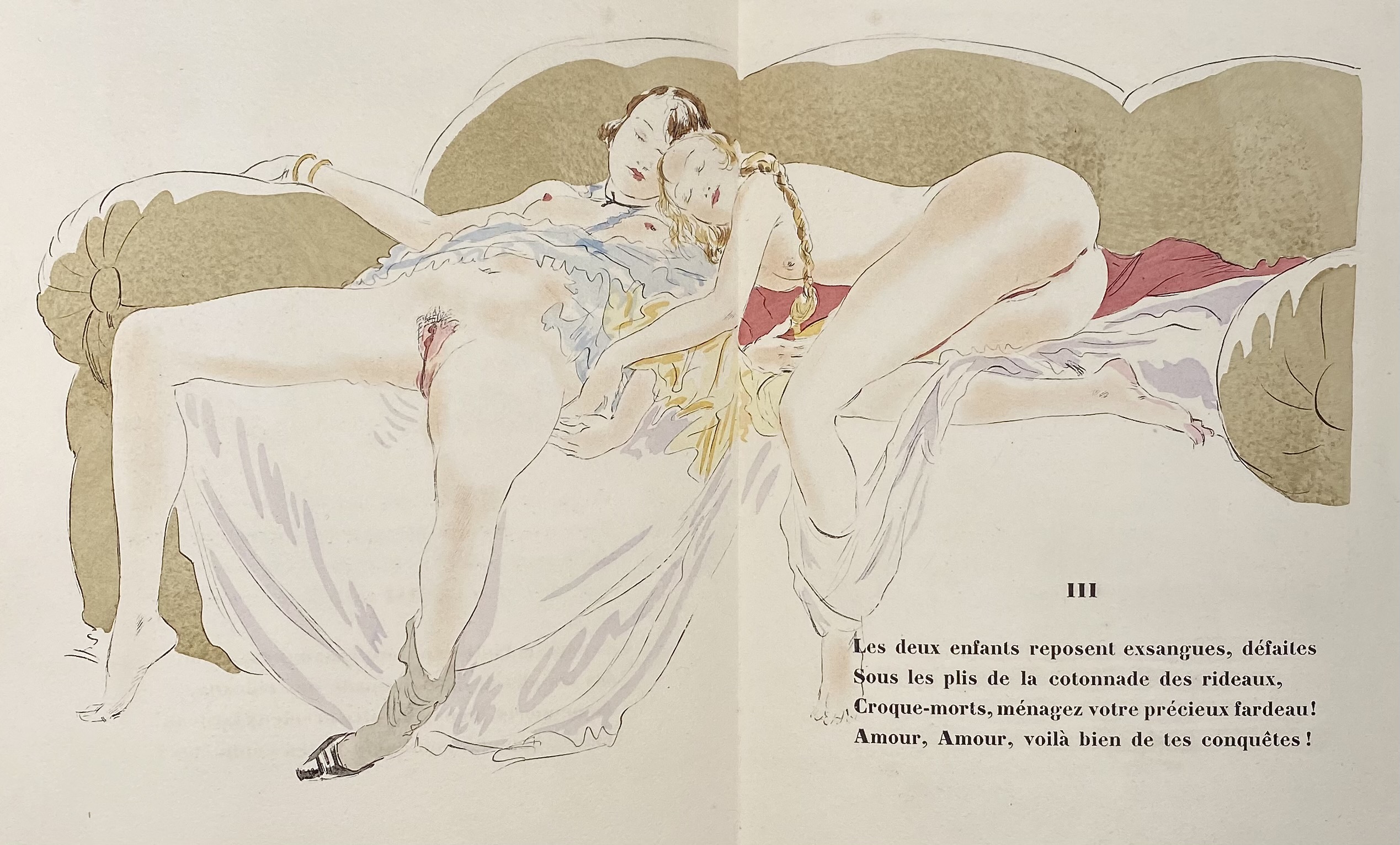
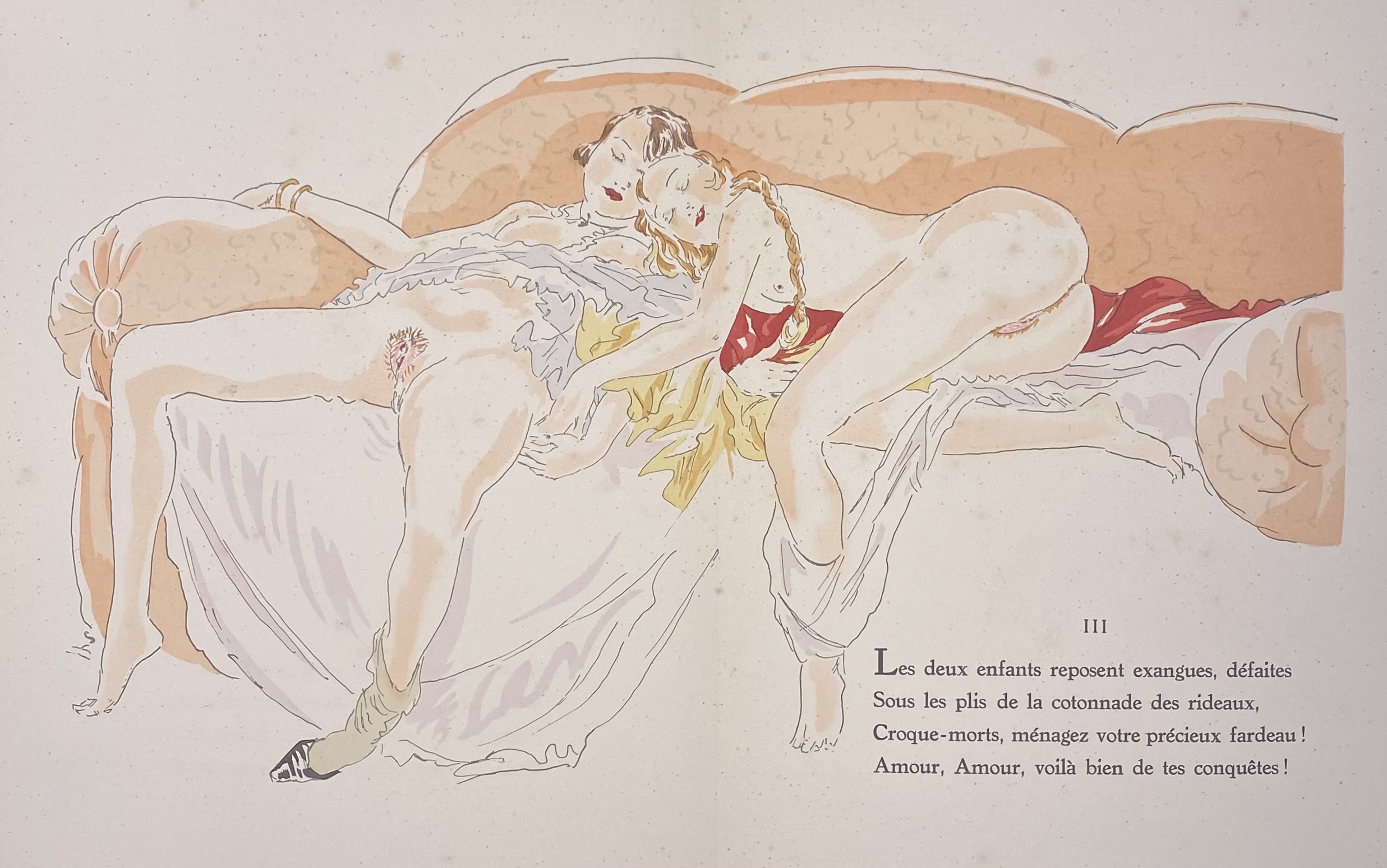
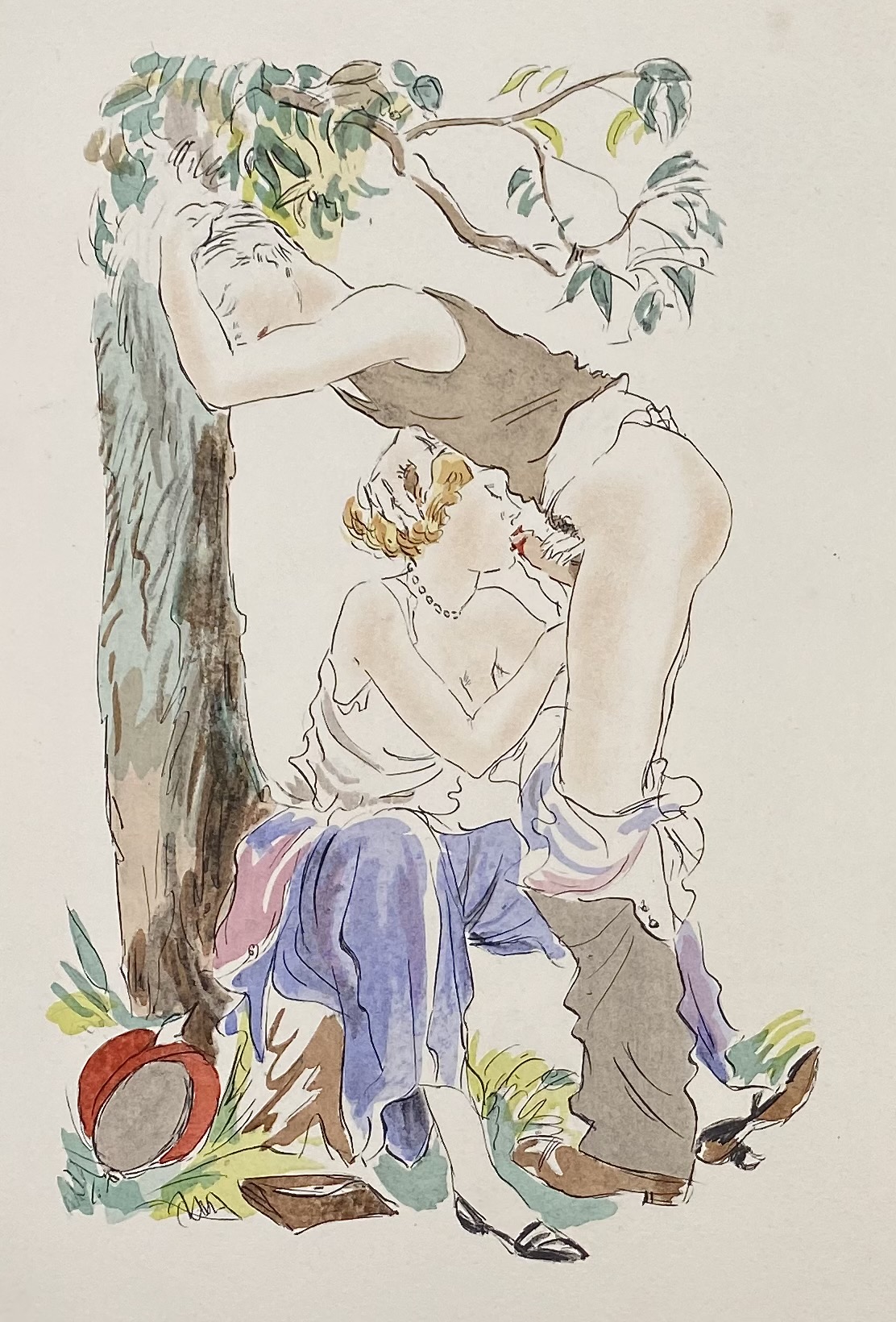
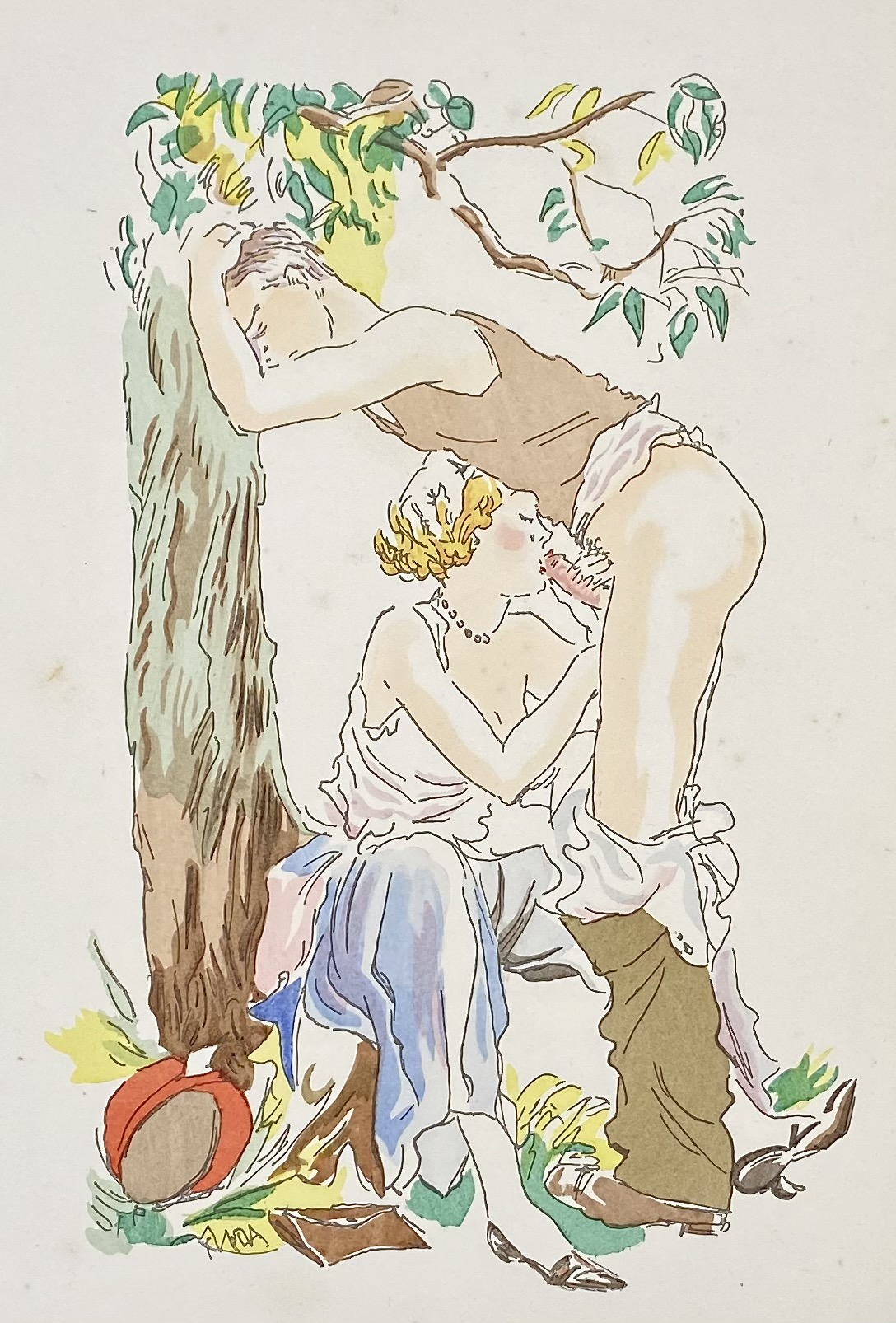
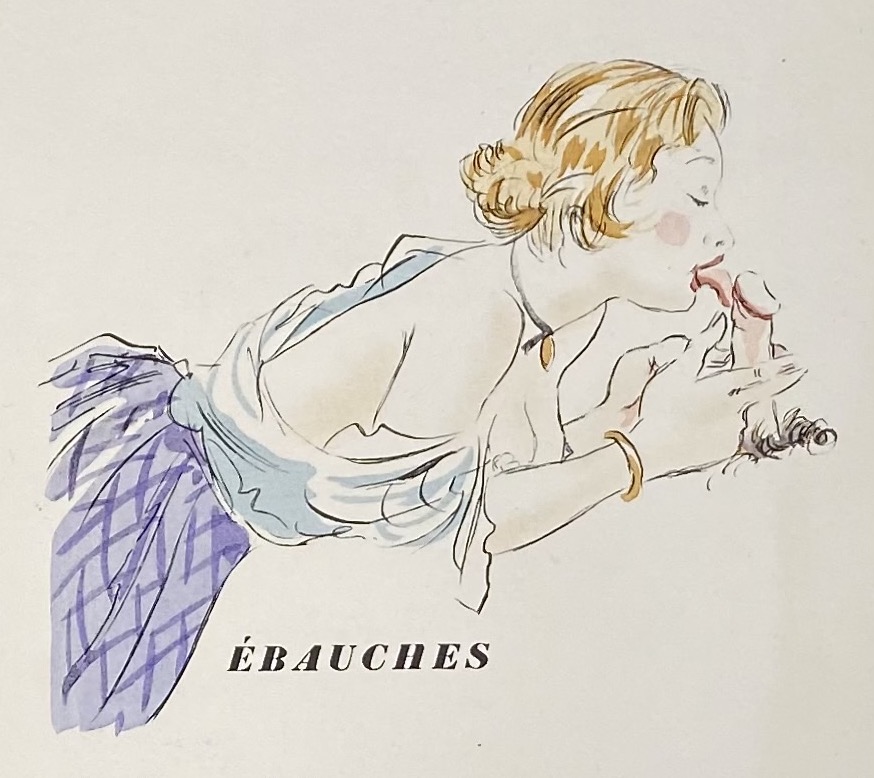
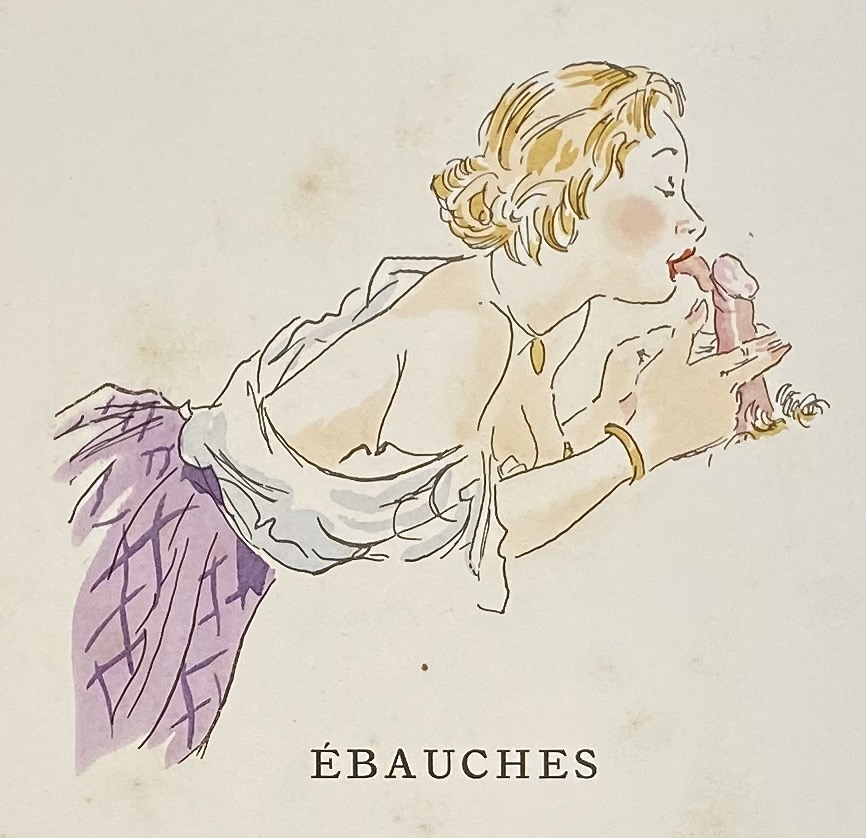
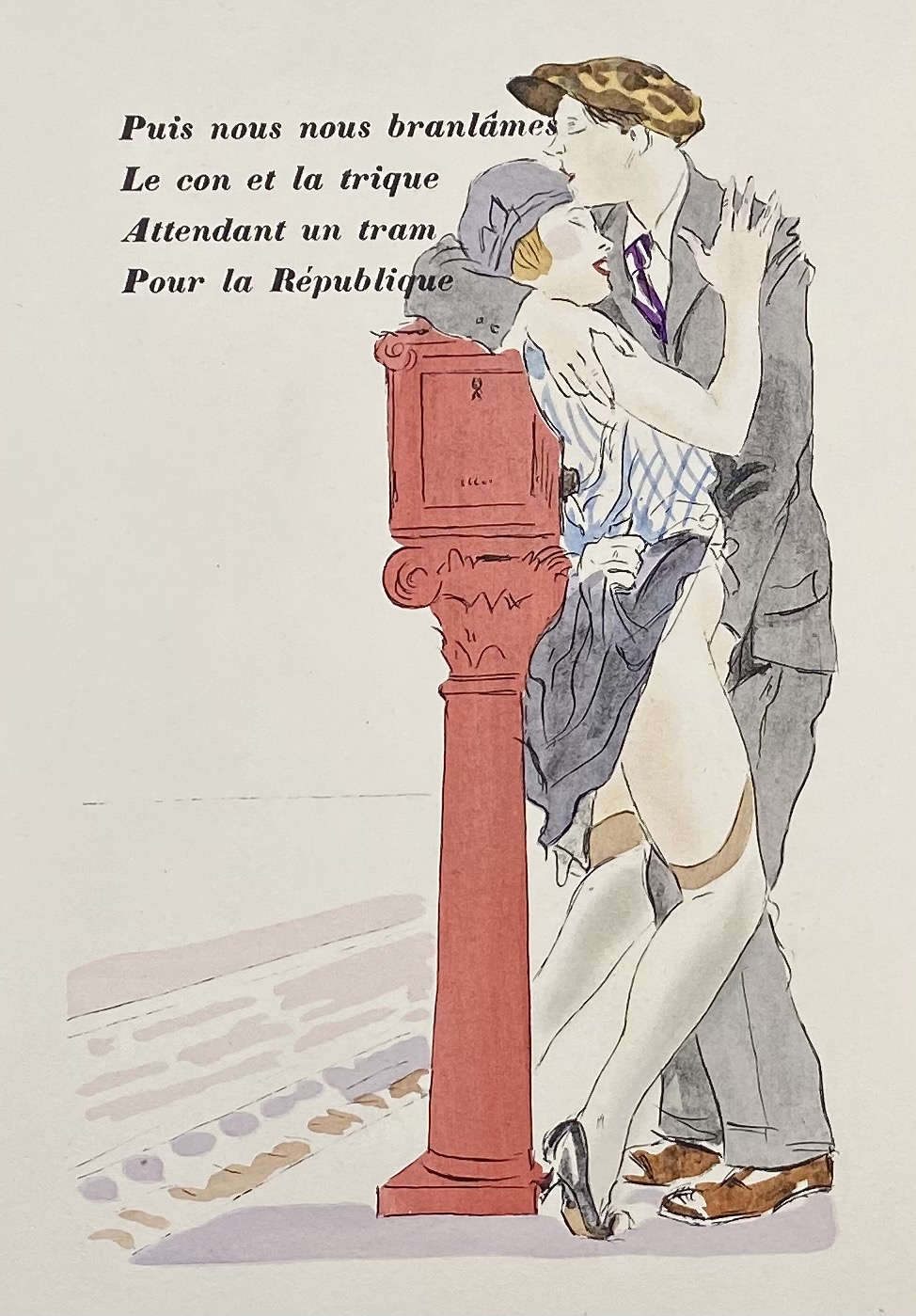
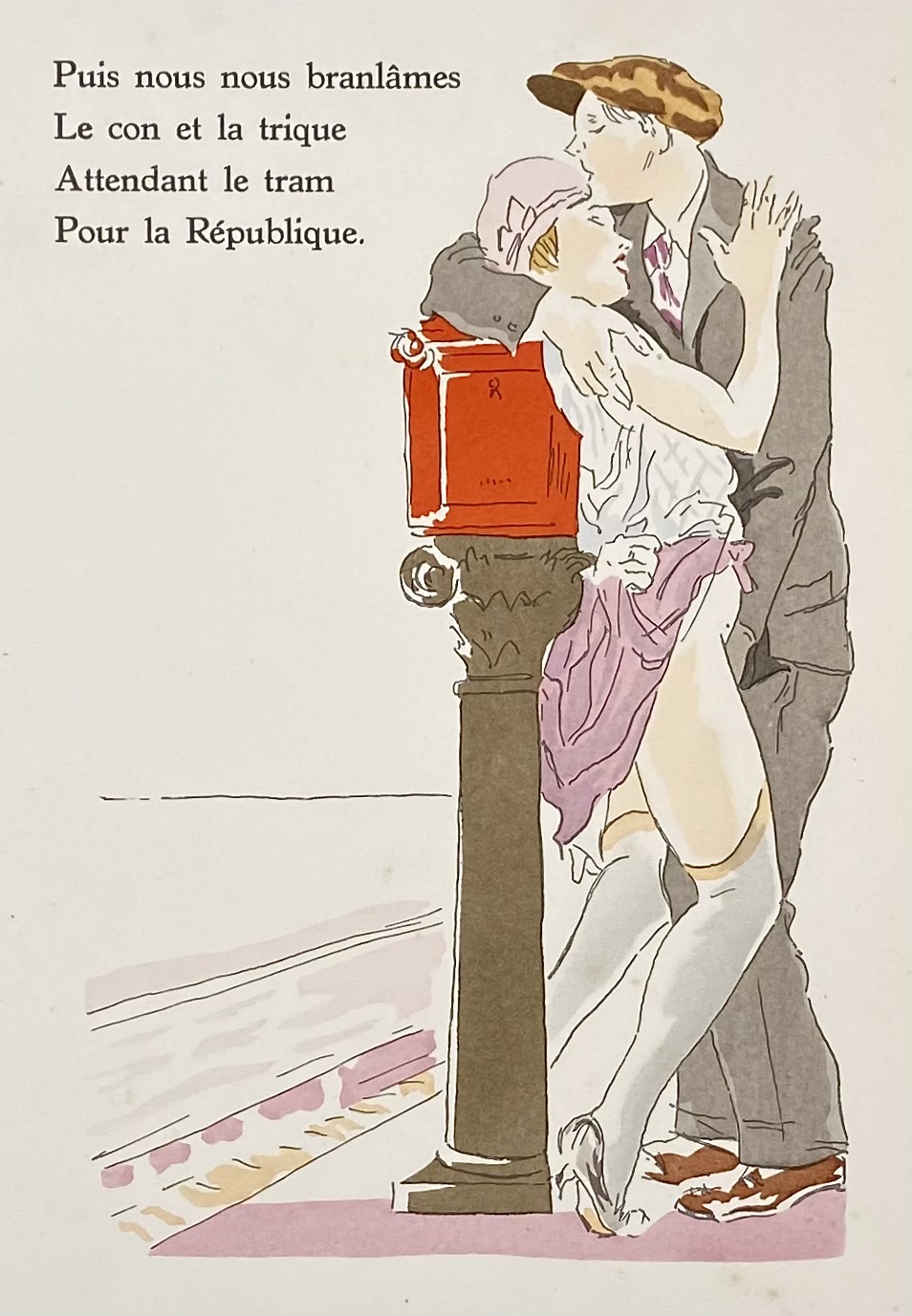
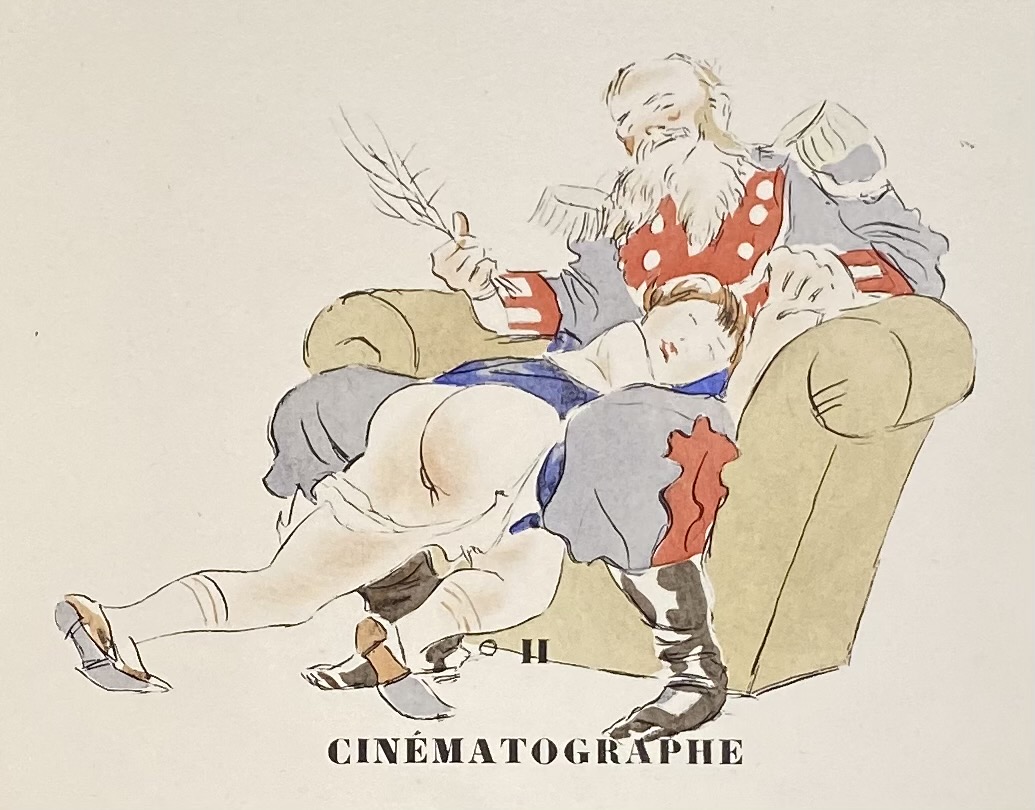
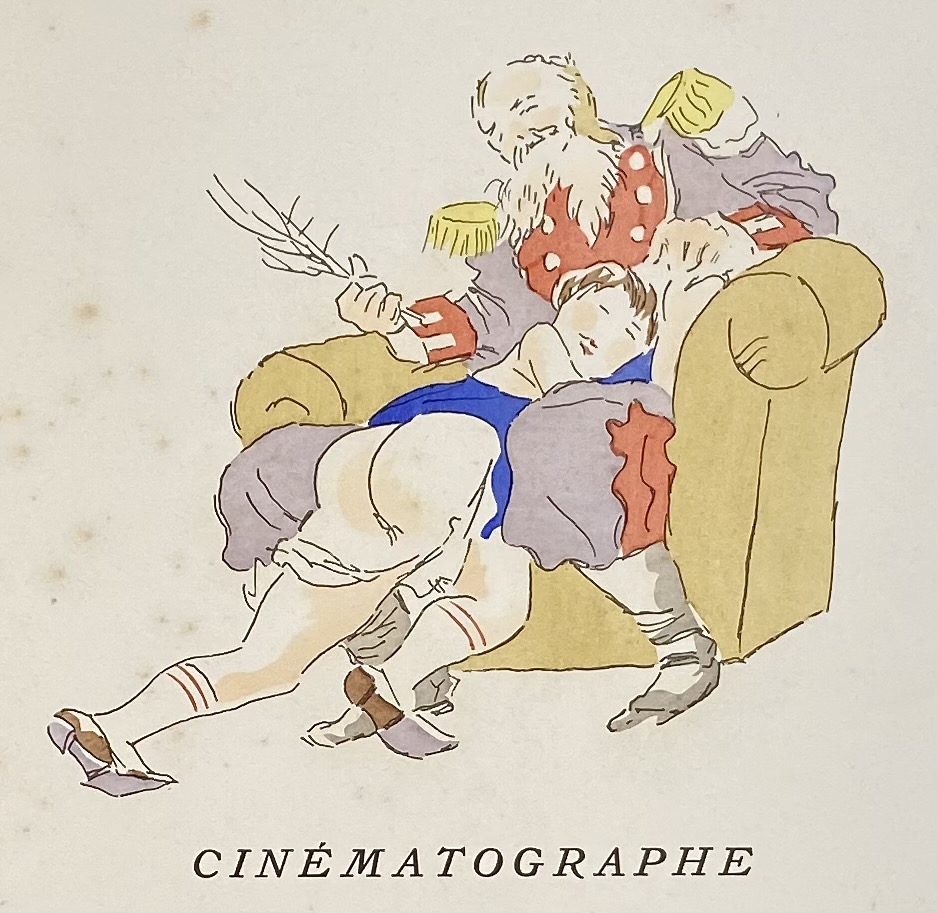
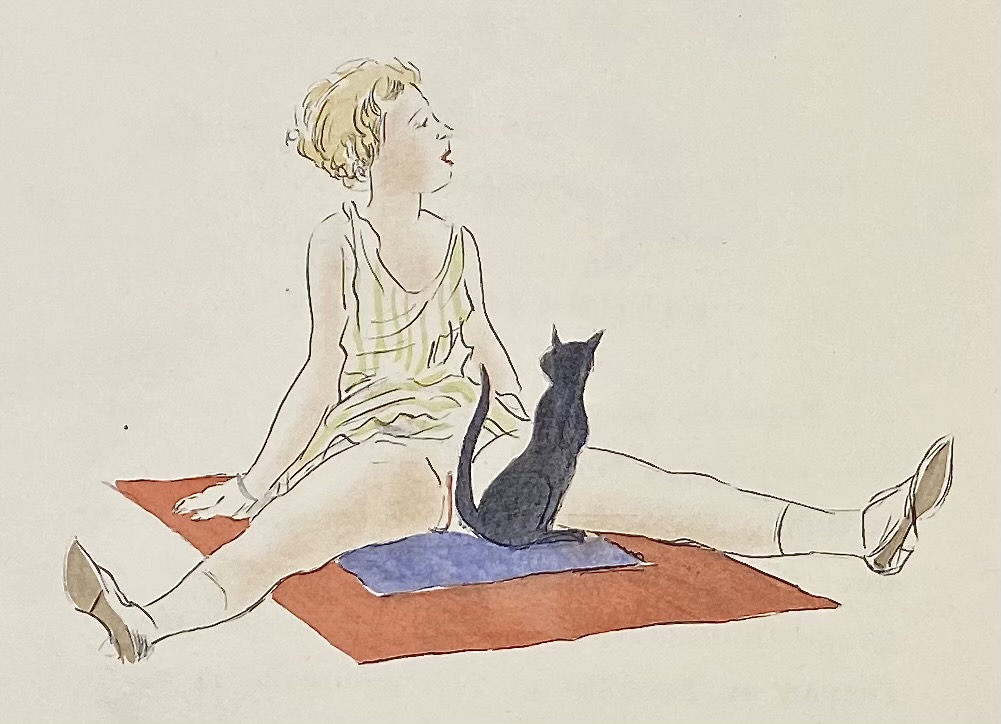
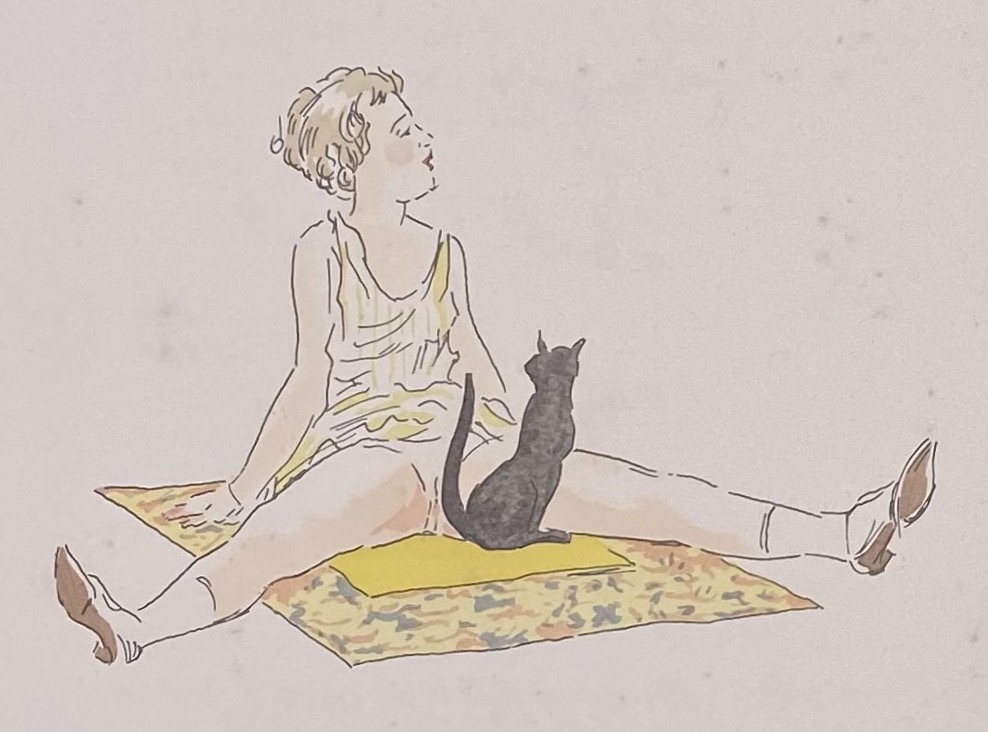
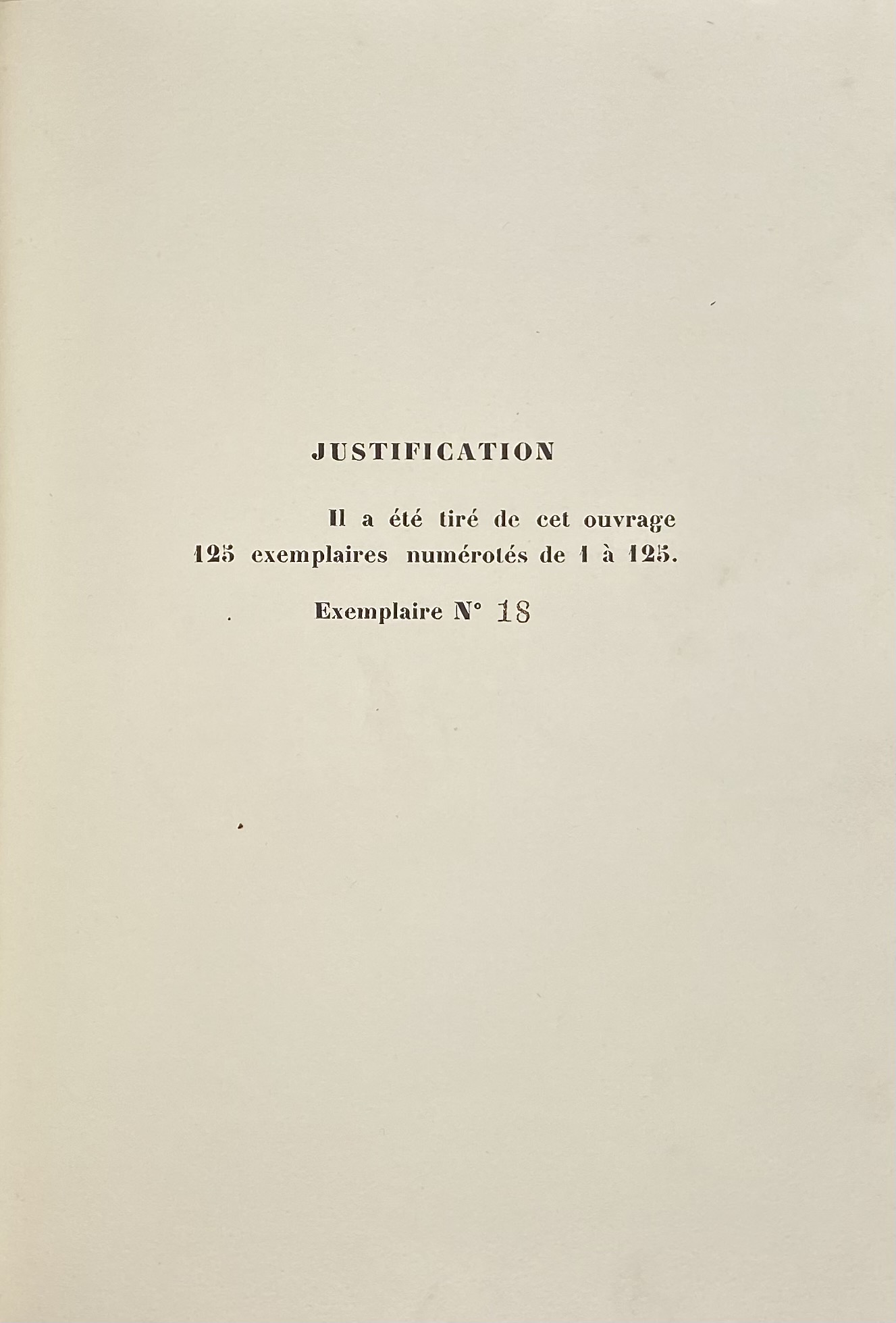
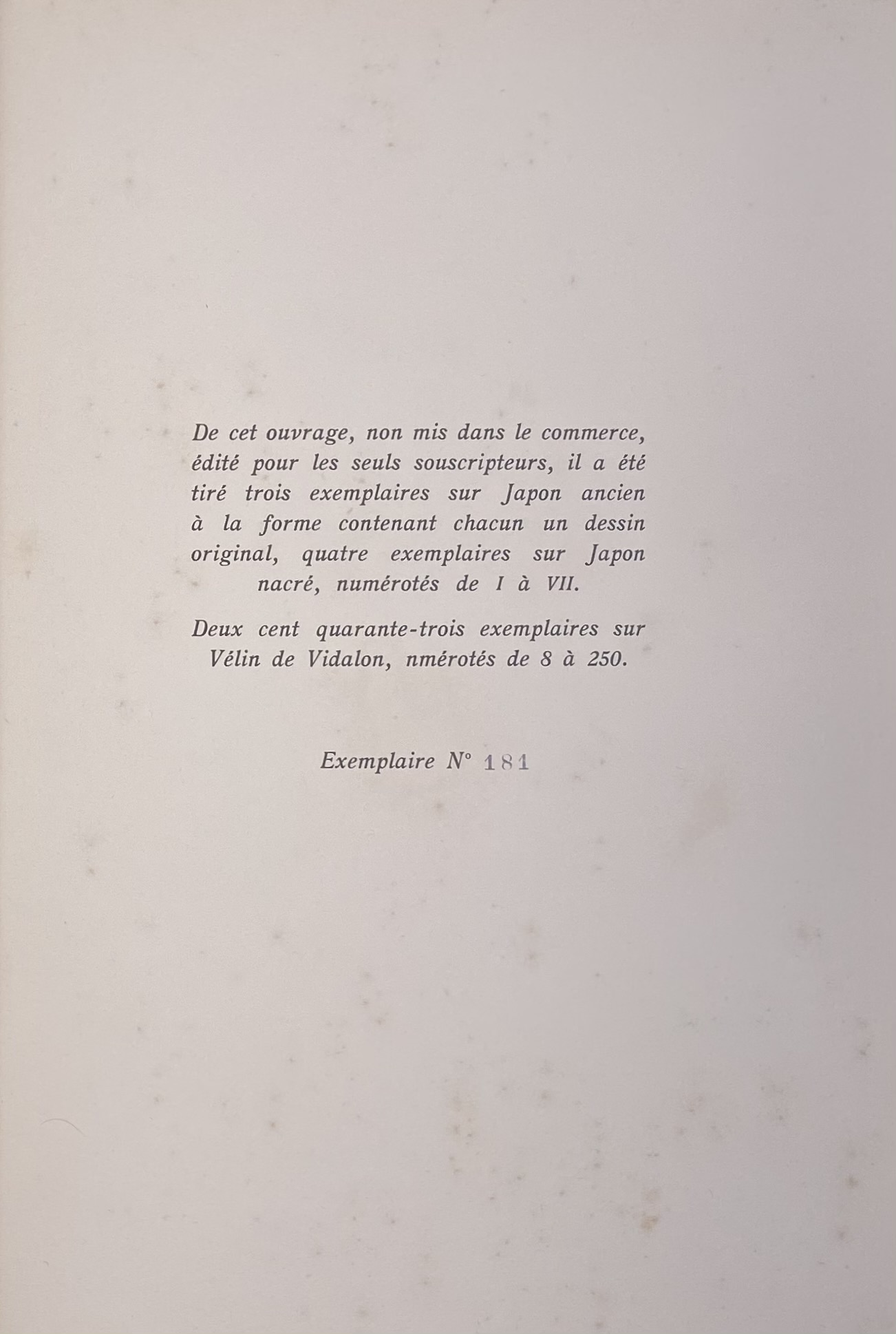
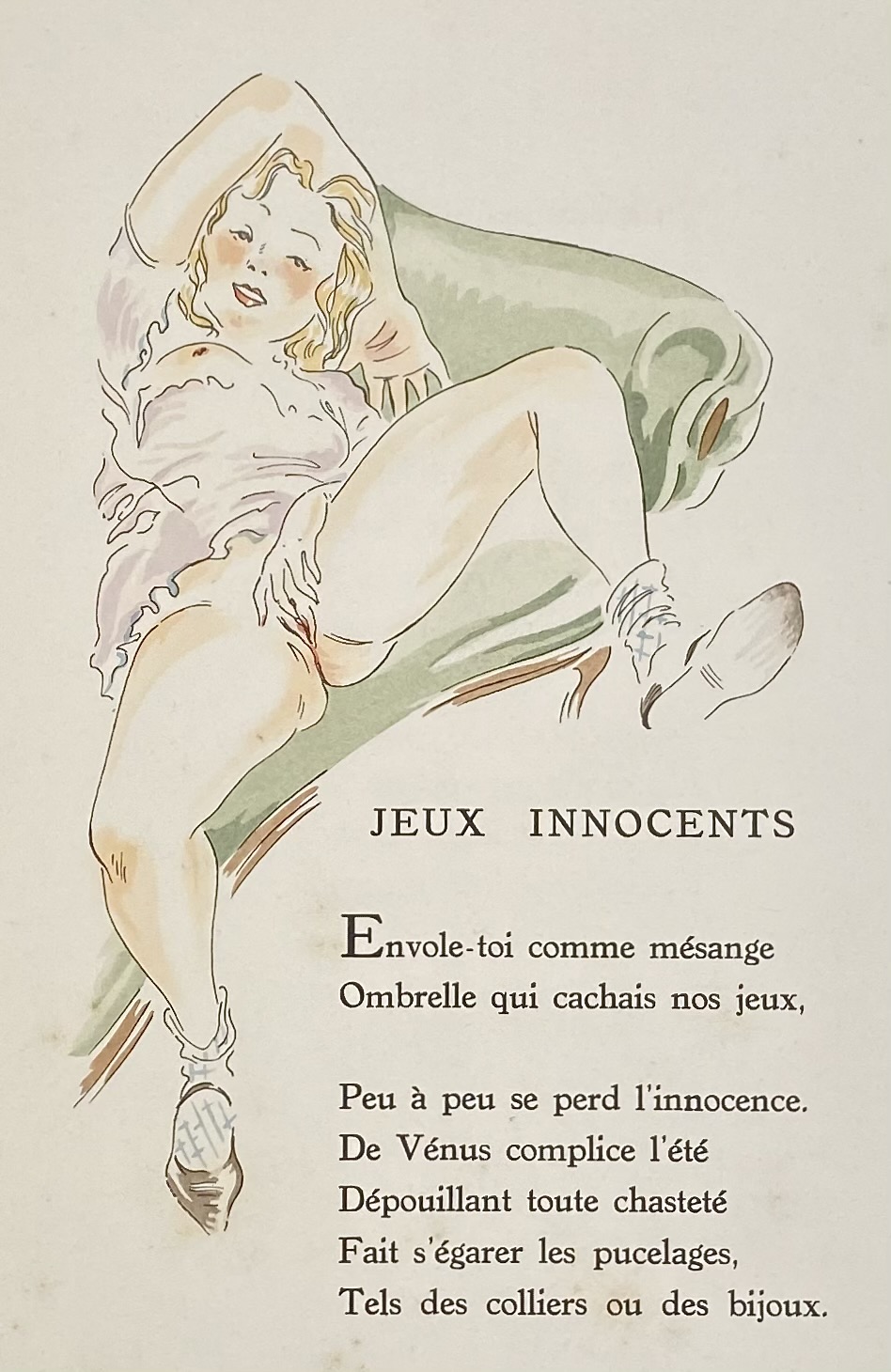
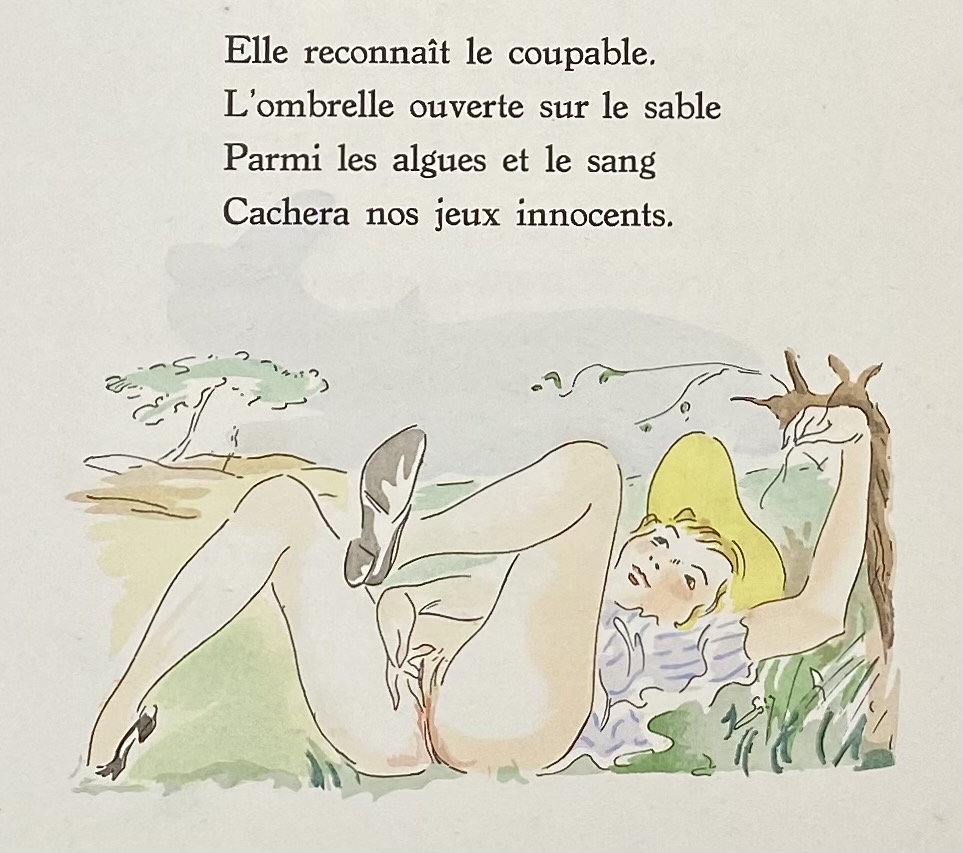
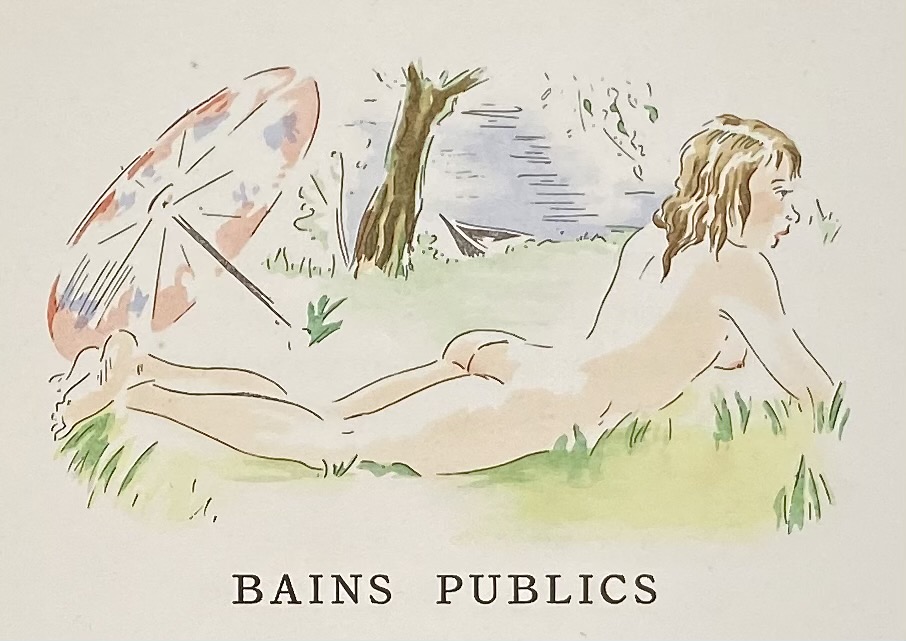
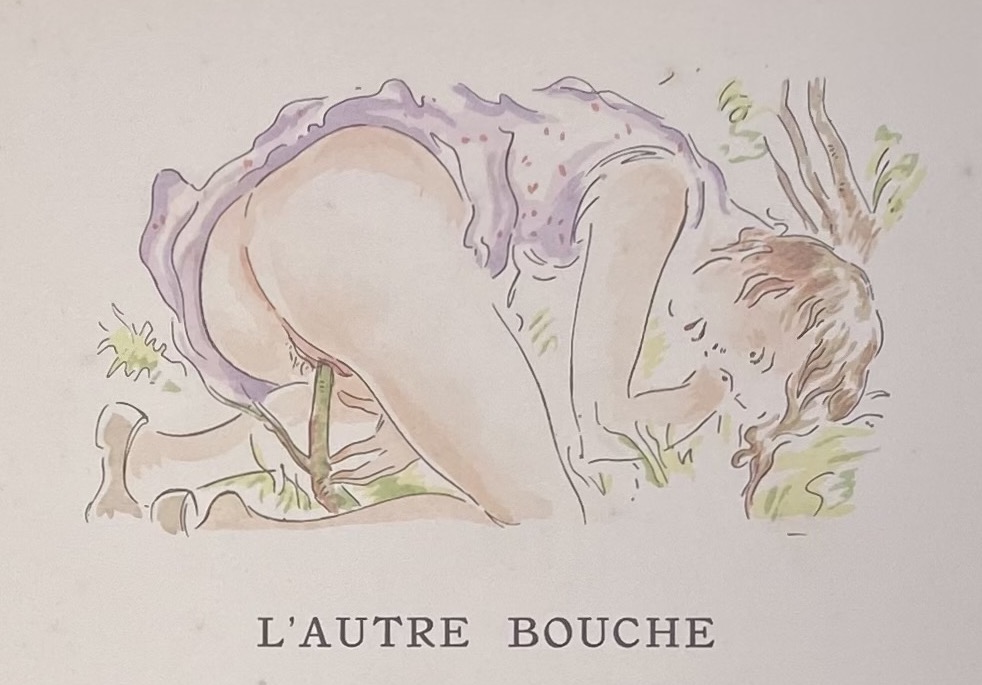
-
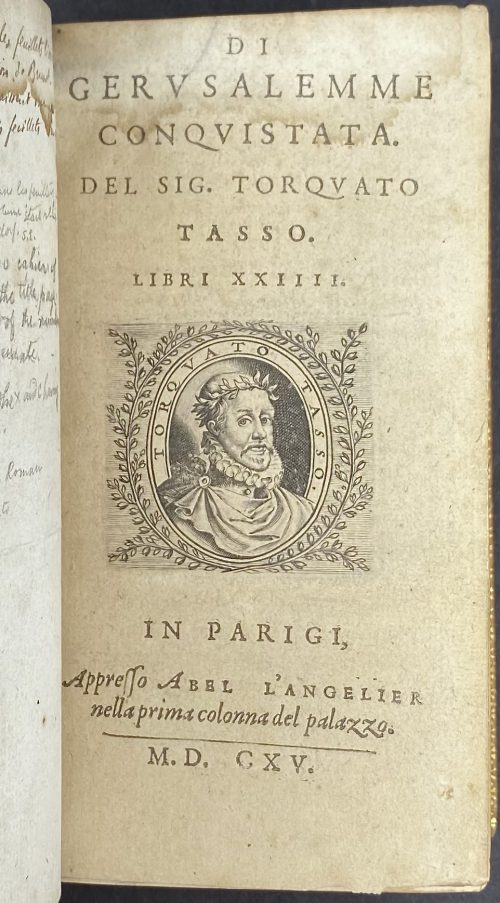 Title-page (1): DI | GERVSALEMME | CONQVISTATA. | DEL SIG. TORQVATO | TASSO. | LIBRI XXIIII. | {engraved portrait of Torquato Tasso in lettered oval medallion surrounded with laurel branches} | IN PARIGI, | Appresso Abel L’ANGELIER | nella prima Colonna del palazzo. | M.D. CXV. || Title-page (2): DI | GERVSALEMME | CONQVISTATA. | DEL SIG. TORQVATO | TASSO. | LIBRI XXIIII. | ALL’ ILL. MO ET REV. MO| SIG. RE| IL SIGNOR. | CINTHIO ALDOBRANDINI | Card. Di San Giorgio. | Appresso Abel L’ANGELIERI | nella prima Colonna del palazzo. | M.D. LCXV. || Collation: 1st blank leaf with an extensive pencil MS in French and English (unsigned), 1st t.p. / blank (unsigned), 2nd t.p. / blank [ai] (unsigned), Dedication by Angelo Ingegneri dated 10-NOV-1592 (ã2-ã5), dedication by Torquato Tasso and Aux Lecteur by Abel L’Angelier ã5[i.e. 6]-[ã9]; 12mo: π12, A-Z12, 2A-2Q12 (2Q11 woodcut / blank, 2Q12 blank), total 480 leaves, with woodcut head- and tailpieces, historiated initials. Note: leaves D6, M3, M6, and N3 unsigned; leave E2 signed for F2, E4 – for F4, Z – for Z5, and A – for Aa. Pagination: 12 prelims unpag., 1-361, each leaf paginated as one page) [2]; with a lot of mispaginations: shall be 1-468, but after p.291 follows 278 (for 292), then 193 for 293, etc. Binding: 14.5 x 8.5 cm, 20th-century tan morocco by Zaehnsdorf (signed in gilt), gilt fleurons in corners and in compartments, raised bands, titles on spine, gilt dentelles, marbled endpapers plus 6 fep at the front (one with pasted clipping “A PARIS, Chez Fetil, Libraire, rue des Cor-| deliers, près celle de Condé, au | Parnasse Italien”, and 2 at the end. What connection has the 18th-century publisher with this edition remains unclear. “The Robin Collection” bookplate to front pastedown. Edges sprinkled red. Occasional damp staining to top margins. There is controversy regarding the year of this publication. It could be 1615 (MDCXV), however, both the publisher and the dedicatee were dead this year. Dedication by the publisher dated 1592. We agree with those scholars who suggest that MDCXV and MDLCXV were misprinted for MDXCV (1595). Provenance: The Robin Collection. Contributors: Torquato Tasso (Italian, 1544 –1595) – author. Angelo Ingegneri (Italian, 1550 – 1613) – author. Abel L'Angelier (French, 1553? – 1610) – printer, publisher. Cinzio Aldobrandini (Italian, 1551 – 1610) – dedicatee.
Title-page (1): DI | GERVSALEMME | CONQVISTATA. | DEL SIG. TORQVATO | TASSO. | LIBRI XXIIII. | {engraved portrait of Torquato Tasso in lettered oval medallion surrounded with laurel branches} | IN PARIGI, | Appresso Abel L’ANGELIER | nella prima Colonna del palazzo. | M.D. CXV. || Title-page (2): DI | GERVSALEMME | CONQVISTATA. | DEL SIG. TORQVATO | TASSO. | LIBRI XXIIII. | ALL’ ILL. MO ET REV. MO| SIG. RE| IL SIGNOR. | CINTHIO ALDOBRANDINI | Card. Di San Giorgio. | Appresso Abel L’ANGELIERI | nella prima Colonna del palazzo. | M.D. LCXV. || Collation: 1st blank leaf with an extensive pencil MS in French and English (unsigned), 1st t.p. / blank (unsigned), 2nd t.p. / blank [ai] (unsigned), Dedication by Angelo Ingegneri dated 10-NOV-1592 (ã2-ã5), dedication by Torquato Tasso and Aux Lecteur by Abel L’Angelier ã5[i.e. 6]-[ã9]; 12mo: π12, A-Z12, 2A-2Q12 (2Q11 woodcut / blank, 2Q12 blank), total 480 leaves, with woodcut head- and tailpieces, historiated initials. Note: leaves D6, M3, M6, and N3 unsigned; leave E2 signed for F2, E4 – for F4, Z – for Z5, and A – for Aa. Pagination: 12 prelims unpag., 1-361, each leaf paginated as one page) [2]; with a lot of mispaginations: shall be 1-468, but after p.291 follows 278 (for 292), then 193 for 293, etc. Binding: 14.5 x 8.5 cm, 20th-century tan morocco by Zaehnsdorf (signed in gilt), gilt fleurons in corners and in compartments, raised bands, titles on spine, gilt dentelles, marbled endpapers plus 6 fep at the front (one with pasted clipping “A PARIS, Chez Fetil, Libraire, rue des Cor-| deliers, près celle de Condé, au | Parnasse Italien”, and 2 at the end. What connection has the 18th-century publisher with this edition remains unclear. “The Robin Collection” bookplate to front pastedown. Edges sprinkled red. Occasional damp staining to top margins. There is controversy regarding the year of this publication. It could be 1615 (MDCXV), however, both the publisher and the dedicatee were dead this year. Dedication by the publisher dated 1592. We agree with those scholars who suggest that MDCXV and MDLCXV were misprinted for MDXCV (1595). Provenance: The Robin Collection. Contributors: Torquato Tasso (Italian, 1544 –1595) – author. Angelo Ingegneri (Italian, 1550 – 1613) – author. Abel L'Angelier (French, 1553? – 1610) – printer, publisher. Cinzio Aldobrandini (Italian, 1551 – 1610) – dedicatee. -
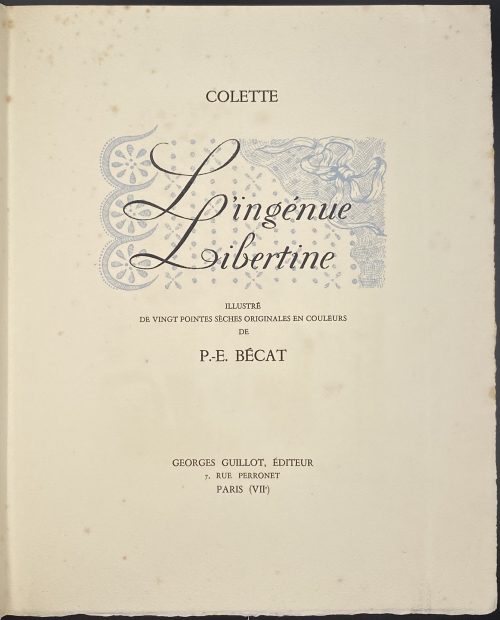 Title-page: COLETTE | L'INGÉNUE | LIBERTINE | ILLUSTRÉ DE VINGT POINTES SÈCHES ORIGINALES EN COULEURS | DE P.-E. BÉCAT | GEORGES GUILLOT, ÉDITEUR | 7, RUE PERRONET | PARIS (VIIe) || French flapped wrapper in a blue double slipcase with dark blue and gilt lettering to spine, 29.5 x 24 x 8 cm, in-folio, leaves 28.5 x 22.5 cm, unbound, with 20 coloured drypoint engravings, with tissue-guards, with 77 initials and tailpieces by Marie Monnier. Limited edition of 420 copies, of which this is copy № XXVII, one of 45 copies marked with Roman numbers and reserved for the artist and collaborators. Printed on November 1st, 1947. Pagination: [16] 1-215 [216] [6], 238 pages (119 leaves) total, incl. plates. Moderate foxing. Contributors: Sidonie-Gabrielle Colette [a.k.a. Colette] (French, 1873 – 1954) Paul-Émile Bécat (French, 1885 – 1960) Marie Monnier (French, 1894 – 1976) Solange et Georges Guillot – publishers. Georges Girard – printer, typography. Manuel Robbe – printer, drypoint engravings.
Title-page: COLETTE | L'INGÉNUE | LIBERTINE | ILLUSTRÉ DE VINGT POINTES SÈCHES ORIGINALES EN COULEURS | DE P.-E. BÉCAT | GEORGES GUILLOT, ÉDITEUR | 7, RUE PERRONET | PARIS (VIIe) || French flapped wrapper in a blue double slipcase with dark blue and gilt lettering to spine, 29.5 x 24 x 8 cm, in-folio, leaves 28.5 x 22.5 cm, unbound, with 20 coloured drypoint engravings, with tissue-guards, with 77 initials and tailpieces by Marie Monnier. Limited edition of 420 copies, of which this is copy № XXVII, one of 45 copies marked with Roman numbers and reserved for the artist and collaborators. Printed on November 1st, 1947. Pagination: [16] 1-215 [216] [6], 238 pages (119 leaves) total, incl. plates. Moderate foxing. Contributors: Sidonie-Gabrielle Colette [a.k.a. Colette] (French, 1873 – 1954) Paul-Émile Bécat (French, 1885 – 1960) Marie Monnier (French, 1894 – 1976) Solange et Georges Guillot – publishers. Georges Girard – printer, typography. Manuel Robbe – printer, drypoint engravings. -
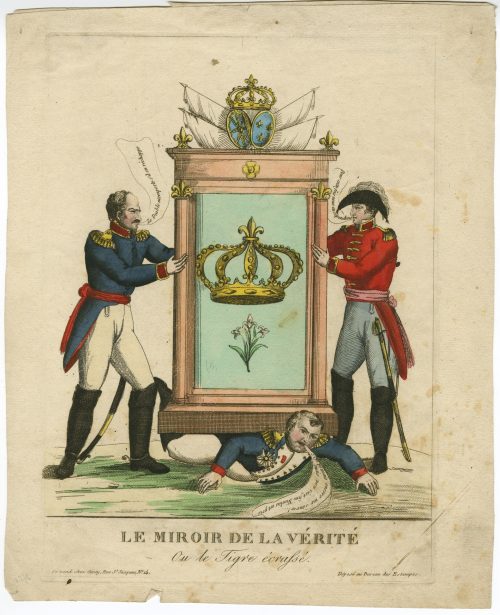 Hand-coloured etching by an anonymous artist, printed in July 1815. Description by British Museum (1866,0407.935): "Blücher (left) and Napoleon (right) support a heavy pier-glass in an upright position. Its solid base rests on the back of the prostrate Napoleon, from whose mouth issues a label: 'Si je pouvais encore me sauver! . . . mais non c'est fini Nicolas est pris.' The mirror, which towers above the head of its supporters, is framed by pillars, each surmounted by a fleur-de-lis. These also decorate the heavy superstructure which supports a trophy of two oval shields with the arms of Bourbon and Navarre, surmounted by a crown..., and four white flags. On the face of the mirror is a large Bourbon crown, and a lily plant. Blücher says: "Le Diable m'emporte s'il en réchappe." Wellington responds: "Pour cette fois nous en répondons." Inscription under the plate: 'Se vend chez Genty, rue St Jacques no.14' and 'Déposé au Bureau des Estampes'. Size: 33.2 x 25.7 cm
Hand-coloured etching by an anonymous artist, printed in July 1815. Description by British Museum (1866,0407.935): "Blücher (left) and Napoleon (right) support a heavy pier-glass in an upright position. Its solid base rests on the back of the prostrate Napoleon, from whose mouth issues a label: 'Si je pouvais encore me sauver! . . . mais non c'est fini Nicolas est pris.' The mirror, which towers above the head of its supporters, is framed by pillars, each surmounted by a fleur-de-lis. These also decorate the heavy superstructure which supports a trophy of two oval shields with the arms of Bourbon and Navarre, surmounted by a crown..., and four white flags. On the face of the mirror is a large Bourbon crown, and a lily plant. Blücher says: "Le Diable m'emporte s'il en réchappe." Wellington responds: "Pour cette fois nous en répondons." Inscription under the plate: 'Se vend chez Genty, rue St Jacques no.14' and 'Déposé au Bureau des Estampes'. Size: 33.2 x 25.7 cm -
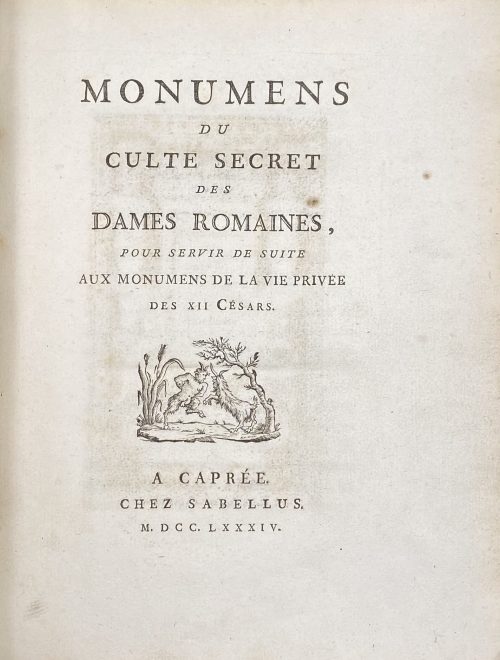 One volume, 25.8 x 20.7 cm, laid paper 25.2 x 19.5 cm, platemark 13.3 x 7.7 cm, wide margins; bound in calf, ruled in gilt, rebacked, raised bands, blind-stamped flower lozenges in compartments, crimson label with gilt lettering, marbled endpapers, all edges gilt, gilt dentelle inside, engraved bookplate to front pastedown: lettered ribbon: “VINCTUS NON VICTUS”, chained Lion Passant in a collar, below “Maurice B. Worms”. Title-page: MONUMENS | DU | CULTE SECRET | DES | DAMES ROMAINES , | POUR SERVIR DE SUITE | AUX MONUMENS DE LA VIE PRIVÉE | DES XII CÉSARS. | {VIGNETTE} | A CAPRÉE. | CHEZ SABELLUS. | M. DCC. LXXXIV. || Collation: [A]2 B-G2 2A-Z2 Aa2 Bb1, total 63 leaves, plus engraved title/frontispiece and 50 plates, all unsigned, first and last blanks. Pagination: [i-ii] iii-xxvii [xxviii] 1-98, ils., total 126 pages. Catalogue raisonné: Cohen-De Ricci: 475; Lewine: 233; Dutel (1650-1880) № A-729, p. 223; Pia (1978): col. 884-5, pp. 467-8. Author: Pierre-François Hugues d'Hancarville (French, 1719-1805) – author. Provenance: Maurice Benedict Worms (Austrian, 1805 – 1867), son of Benedikt Moses Worms (1769 – 1824) and Schönche Jeannette Rothschild (1771 – 1859), maternal grandson of Mayer Amschel Rothschild (1744 – 1812), the founder of the House of Rothschild.
One volume, 25.8 x 20.7 cm, laid paper 25.2 x 19.5 cm, platemark 13.3 x 7.7 cm, wide margins; bound in calf, ruled in gilt, rebacked, raised bands, blind-stamped flower lozenges in compartments, crimson label with gilt lettering, marbled endpapers, all edges gilt, gilt dentelle inside, engraved bookplate to front pastedown: lettered ribbon: “VINCTUS NON VICTUS”, chained Lion Passant in a collar, below “Maurice B. Worms”. Title-page: MONUMENS | DU | CULTE SECRET | DES | DAMES ROMAINES , | POUR SERVIR DE SUITE | AUX MONUMENS DE LA VIE PRIVÉE | DES XII CÉSARS. | {VIGNETTE} | A CAPRÉE. | CHEZ SABELLUS. | M. DCC. LXXXIV. || Collation: [A]2 B-G2 2A-Z2 Aa2 Bb1, total 63 leaves, plus engraved title/frontispiece and 50 plates, all unsigned, first and last blanks. Pagination: [i-ii] iii-xxvii [xxviii] 1-98, ils., total 126 pages. Catalogue raisonné: Cohen-De Ricci: 475; Lewine: 233; Dutel (1650-1880) № A-729, p. 223; Pia (1978): col. 884-5, pp. 467-8. Author: Pierre-François Hugues d'Hancarville (French, 1719-1805) – author. Provenance: Maurice Benedict Worms (Austrian, 1805 – 1867), son of Benedikt Moses Worms (1769 – 1824) and Schönche Jeannette Rothschild (1771 – 1859), maternal grandson of Mayer Amschel Rothschild (1744 – 1812), the founder of the House of Rothschild. -
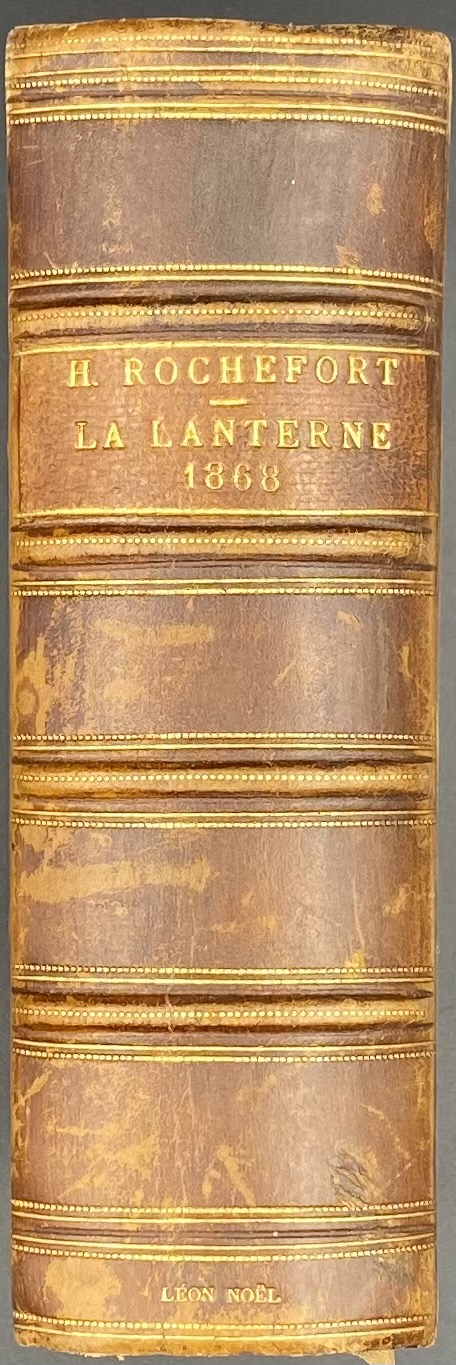 Description: Owner’s quarter calf over marbled boards, 14.5 x 10.5 x 4.5 cm, spine with raised bands, gilt-lettered brown label “H. ROCHEFORT | LA LANTERNE | 1868 | LÉON NOËL”, marbled endpapers; first 11 issues of Henri Rochefort’s journal bound together with original front and back red pictorial wrappers. Front wrapper (first two issues white of red, subsequent issues black on orange background, the text is similar): La | Lanterne | par | {vignette of the lantern} Henri Rochefort | Prix: 40 centes | Bureaux : | 3 rue Rossini & rue Coq Héron, 5 | PARIS || Back wrapper (first two issues white of red, subsequent issues black on orange background, the text is similar): La Lanterne | PARTAIT TOUS LES SAMEDIS | (52 fois par an). | — | Prix d’Abonnement | Un An 20 fr | Six Mois 10 fr | Trois Mois 5 fr | — | Les Mandats doivent être adresses | A Mr. Dumont ADMINISTRATEUR | ❦ | Imprimerie Central des Chemins de Fer A. Chaix & Cie | 20, rue Bergère, à Paris_4608 _ 8 || Collation/pagination: 3 blanks, № 1: fw [1] 2-56 [8] bw; № 2: fw, [57] 58-115 [116] [2] bw; № 3: fw [117] 178 bw; № 4: fw [179] 180-238 [4] bw; № 5: fw [239] 240-298 [4] bw; № 6: fw [299] 300-361 [362] bw; № 7: fw [363] 364-423 [424] [2] bw; № 8: fw [425] 426-483 [484] [4] bw; № 9: fw [1] 2-58 [6] bw; № 10: fw [1] 2-58 [6] bw; № 11: fw [1] 2-59 [60] [4] bw; 3blanks. Contributors: Victor Henri Rochefort, Marquis de Rochefort-Luçay (French, 1831 – 1913) – editor. Alban Chaix (French, 1860 – 1930); Napoléon Chaix (French, 1807 – 1865) – publishers. Dubuisson et Cie (Paris) – printer.
Description: Owner’s quarter calf over marbled boards, 14.5 x 10.5 x 4.5 cm, spine with raised bands, gilt-lettered brown label “H. ROCHEFORT | LA LANTERNE | 1868 | LÉON NOËL”, marbled endpapers; first 11 issues of Henri Rochefort’s journal bound together with original front and back red pictorial wrappers. Front wrapper (first two issues white of red, subsequent issues black on orange background, the text is similar): La | Lanterne | par | {vignette of the lantern} Henri Rochefort | Prix: 40 centes | Bureaux : | 3 rue Rossini & rue Coq Héron, 5 | PARIS || Back wrapper (first two issues white of red, subsequent issues black on orange background, the text is similar): La Lanterne | PARTAIT TOUS LES SAMEDIS | (52 fois par an). | — | Prix d’Abonnement | Un An 20 fr | Six Mois 10 fr | Trois Mois 5 fr | — | Les Mandats doivent être adresses | A Mr. Dumont ADMINISTRATEUR | ❦ | Imprimerie Central des Chemins de Fer A. Chaix & Cie | 20, rue Bergère, à Paris_4608 _ 8 || Collation/pagination: 3 blanks, № 1: fw [1] 2-56 [8] bw; № 2: fw, [57] 58-115 [116] [2] bw; № 3: fw [117] 178 bw; № 4: fw [179] 180-238 [4] bw; № 5: fw [239] 240-298 [4] bw; № 6: fw [299] 300-361 [362] bw; № 7: fw [363] 364-423 [424] [2] bw; № 8: fw [425] 426-483 [484] [4] bw; № 9: fw [1] 2-58 [6] bw; № 10: fw [1] 2-58 [6] bw; № 11: fw [1] 2-59 [60] [4] bw; 3blanks. Contributors: Victor Henri Rochefort, Marquis de Rochefort-Luçay (French, 1831 – 1913) – editor. Alban Chaix (French, 1860 – 1930); Napoléon Chaix (French, 1807 – 1865) – publishers. Dubuisson et Cie (Paris) – printer. -
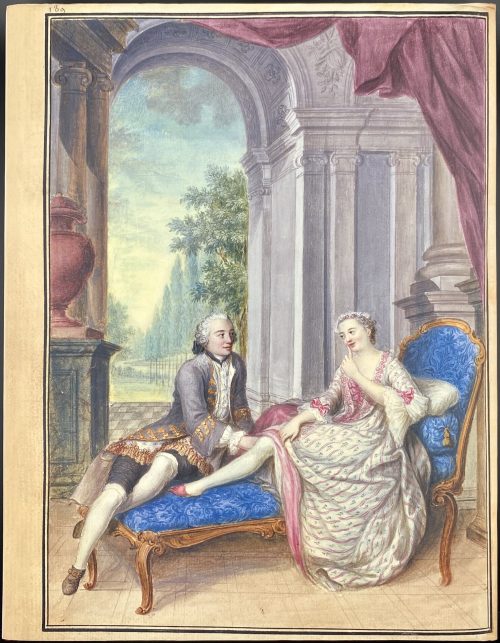 Description: One volume 32.5 x 25.5 cm, in crimson cloth, blind lettering to front cover and spine, pictorial DJ, lettered (similar to t.p.) in the back. Pagination: [2 blank] [1-9] 10-337 [338] [4] [4 notes], total 174 leaves, 137 entries. Title-page (in red and black): Eros invaincu | LA BIBLIOTHÉQUE GÉRARD NORDMANN | Florilège | établi sous la direction de Monique Nordmann | commente par Laurent Adert • Saba Bahar • Françoise Bléchet • Arto Clerc | (5 more lines of names) | & | édité par Rainer Michael Mason | FONDATION MARTIN BODMER | EDITIONS CERCLE D'ART | GENÈVE • MMIV • PARIS || Gérard Nordmann (Swiss, 1930 – 1992) Bibliothèque érotique: Gérard Nordmann; Livres, manuscrits, dessins, photographies du XVIe au XXe siècle / Catalogues de ventes (two parts) — Paris: Christie’s, 2006, see LIB-2828.2021 and [LIB-2810.2021].
Description: One volume 32.5 x 25.5 cm, in crimson cloth, blind lettering to front cover and spine, pictorial DJ, lettered (similar to t.p.) in the back. Pagination: [2 blank] [1-9] 10-337 [338] [4] [4 notes], total 174 leaves, 137 entries. Title-page (in red and black): Eros invaincu | LA BIBLIOTHÉQUE GÉRARD NORDMANN | Florilège | établi sous la direction de Monique Nordmann | commente par Laurent Adert • Saba Bahar • Françoise Bléchet • Arto Clerc | (5 more lines of names) | & | édité par Rainer Michael Mason | FONDATION MARTIN BODMER | EDITIONS CERCLE D'ART | GENÈVE • MMIV • PARIS || Gérard Nordmann (Swiss, 1930 – 1992) Bibliothèque érotique: Gérard Nordmann; Livres, manuscrits, dessins, photographies du XVIe au XXe siècle / Catalogues de ventes (two parts) — Paris: Christie’s, 2006, see LIB-2828.2021 and [LIB-2810.2021]. -
 Kabuki actor: Matsumoto Kōshirō V [五代目松本幸四郎] (Japanese, 1764-1838); other names: Ichikawa Komazō III, Ichikawa Sumizō I. Role: Nikki Danjo (仁木弾正): "Evil retainer Nikki Danjo who plots to overthrow his lord in the play Precious incense and the bush clover of Sendai (Meiboku sendai hagi)" [R. Kruml]. Artist: Utagawa Kunisada [歌川 国貞] a.k.a. Utagawa Toyokuni III [三代歌川豊国] (Japanese, 1786 – 1865). Block cutter: Horikō (Kiyomizu) Ryūzō [彫工 柳三]. Publisher: Ebisuya Shoshichi [恵比寿屋庄七], Kinshōdō (Japanese, fl. c. 1846 – 1883). Year: 1863 (Bunkyū 3), 7th month. Size: Vertical ōban, hōsho paper. Signed: Nanajuhassai (aged seventy-eight) Toyokuni ga within toshidama cartouche. Censor’s seal: date-aratame. This print is from a series of portraits that Kunisada undertook very late in life and has been named Kinshodo-ban yakusha okubi-e (Kinshodo’s Large-Head Actor Portraits) in reference to the publisher, Ebisuya Shochochi of Kinshodo. The series depicted great actors in their famous roles from the past and present. Ref.: (1) [LIB-1212.2017] Robert Schaap. Kunisada: Imaging, drama and beauty. — Leiden: Hotei Publishing, 2016, p. 118 and 167 (№ 42):
Kabuki actor: Matsumoto Kōshirō V [五代目松本幸四郎] (Japanese, 1764-1838); other names: Ichikawa Komazō III, Ichikawa Sumizō I. Role: Nikki Danjo (仁木弾正): "Evil retainer Nikki Danjo who plots to overthrow his lord in the play Precious incense and the bush clover of Sendai (Meiboku sendai hagi)" [R. Kruml]. Artist: Utagawa Kunisada [歌川 国貞] a.k.a. Utagawa Toyokuni III [三代歌川豊国] (Japanese, 1786 – 1865). Block cutter: Horikō (Kiyomizu) Ryūzō [彫工 柳三]. Publisher: Ebisuya Shoshichi [恵比寿屋庄七], Kinshōdō (Japanese, fl. c. 1846 – 1883). Year: 1863 (Bunkyū 3), 7th month. Size: Vertical ōban, hōsho paper. Signed: Nanajuhassai (aged seventy-eight) Toyokuni ga within toshidama cartouche. Censor’s seal: date-aratame. This print is from a series of portraits that Kunisada undertook very late in life and has been named Kinshodo-ban yakusha okubi-e (Kinshodo’s Large-Head Actor Portraits) in reference to the publisher, Ebisuya Shochochi of Kinshodo. The series depicted great actors in their famous roles from the past and present. Ref.: (1) [LIB-1212.2017] Robert Schaap. Kunisada: Imaging, drama and beauty. — Leiden: Hotei Publishing, 2016, p. 118 and 167 (№ 42): Ref.: (1) [LIB-1197.2016] Arendie and Henk Herwig. Heroes of the kabuki stage: an introduction to kabuki with retellings of famous plays, illustrated by woodblock prints. — Amsterdam: Hotei Publishing, 2004; pp. 243-249.
Ref.: (1) [LIB-1197.2016] Arendie and Henk Herwig. Heroes of the kabuki stage: an introduction to kabuki with retellings of famous plays, illustrated by woodblock prints. — Amsterdam: Hotei Publishing, 2004; pp. 243-249.


-
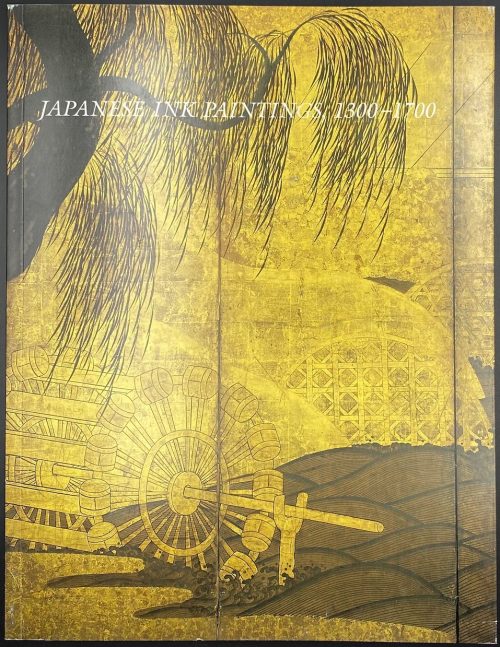 Softcover, in pictorial flapped wrappers, 28 x 21.8 cm, 16 entries, with colour illustrations. Catalogue # 8 of the sales exhibition on March 23-30 2004 in NY; pagination: [1-3] 4-50 [2], ils., some folding. Contributor: Sebastian Izzard
Softcover, in pictorial flapped wrappers, 28 x 21.8 cm, 16 entries, with colour illustrations. Catalogue # 8 of the sales exhibition on March 23-30 2004 in NY; pagination: [1-3] 4-50 [2], ils., some folding. Contributor: Sebastian Izzard -
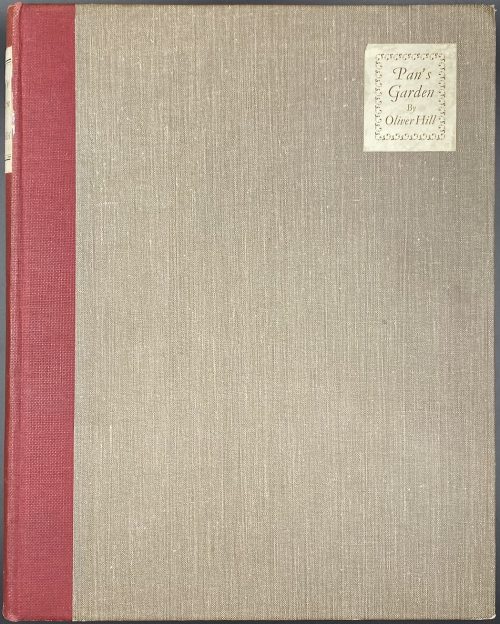 Description: Hardcover photographic pictorial album, 29.2 x 23.1 cm, quarter crimson percaline over grey cloth with lettered paper labels to front cover and spine, grey endpapers; pp. [1-4] 5-109 [3], total 56 leaves, additional spine and cover labels tipped-in. Oliver Hill (British, 1887 – 1968).
Description: Hardcover photographic pictorial album, 29.2 x 23.1 cm, quarter crimson percaline over grey cloth with lettered paper labels to front cover and spine, grey endpapers; pp. [1-4] 5-109 [3], total 56 leaves, additional spine and cover labels tipped-in. Oliver Hill (British, 1887 – 1968). -
 Artist: Utagawa Kuniyoshi [歌川 國芳] (Japanese, 1798 – 1861). Publisher: Ibaya Senzaburō [伊場屋仙三郎] (Japanese, c. 1815 – 1869). Date-aratame seal: 1827 (Bunsei 10). Inscription: Ohan [おはん], Chōemon [長右衛門] | Dainingyō [大人形] | Yoshida Senshi [吉田千四)] | unclear (work in progress). Sam. L. Leiter describes the play in his Kabuki Encyclopedia (1979) p. 183, and Japanese traditional theatre (2014), p. 252 as "Love Suicide of Ohan and Choemon at the Katsura River" (Katsuragawa Renri no Shigarami) [桂川連理柵], a two-act play by Suga Sensuke [菅専助] (ca. 1728 – 1791) written in 1776 for the puppet theatre jūruri and adopted for Osaka kabuki in 1777. Yoshida Senshi, a.k.a. Yoshida Bunzaburo III was a Japanese puppeteer of a Yoshida lineage. The line was established by Yoshida Bunzaburō I [吉田文三郎] (Japanese, fl. 1717 – 1760), who was one of the greatest in the history of Bunraku [人形浄瑠璃] (ningyō jōruri) and who around 1734 introduced the three-man puppet manipulation system. A portrait of Yoshida Senshi, who died in 1829, can be found in the Kunisada's triptych at Jordan Schnitzer Museum of Art, ID Number 2016:37.2.).
Artist: Utagawa Kuniyoshi [歌川 國芳] (Japanese, 1798 – 1861). Publisher: Ibaya Senzaburō [伊場屋仙三郎] (Japanese, c. 1815 – 1869). Date-aratame seal: 1827 (Bunsei 10). Inscription: Ohan [おはん], Chōemon [長右衛門] | Dainingyō [大人形] | Yoshida Senshi [吉田千四)] | unclear (work in progress). Sam. L. Leiter describes the play in his Kabuki Encyclopedia (1979) p. 183, and Japanese traditional theatre (2014), p. 252 as "Love Suicide of Ohan and Choemon at the Katsura River" (Katsuragawa Renri no Shigarami) [桂川連理柵], a two-act play by Suga Sensuke [菅専助] (ca. 1728 – 1791) written in 1776 for the puppet theatre jūruri and adopted for Osaka kabuki in 1777. Yoshida Senshi, a.k.a. Yoshida Bunzaburo III was a Japanese puppeteer of a Yoshida lineage. The line was established by Yoshida Bunzaburō I [吉田文三郎] (Japanese, fl. 1717 – 1760), who was one of the greatest in the history of Bunraku [人形浄瑠璃] (ningyō jōruri) and who around 1734 introduced the three-man puppet manipulation system. A portrait of Yoshida Senshi, who died in 1829, can be found in the Kunisada's triptych at Jordan Schnitzer Museum of Art, ID Number 2016:37.2.). The design on our fan print looks very much like the one of Toyokuni I at MFA (Houston): OBJECT NUMBER 2006.378. "Seki Sanjuro as Obiya Choemon and Ichikawa Denzo as Ohan of the Shinonoya from the Kabuki Drama Katsuragawa renri no shigarami (Love Suicide of Ohan and Choemon at the Katsura River)", according to MFA-H published by someone Tsuruya in c. 1810 (though the publisher's seal is Suzuki Ihei [鈴木伊兵衛] (seal name Suzui [鈴伊]), Marks 01-028 | 502; the censor's seal is gyōji, date 1811-14).
The design on our fan print looks very much like the one of Toyokuni I at MFA (Houston): OBJECT NUMBER 2006.378. "Seki Sanjuro as Obiya Choemon and Ichikawa Denzo as Ohan of the Shinonoya from the Kabuki Drama Katsuragawa renri no shigarami (Love Suicide of Ohan and Choemon at the Katsura River)", according to MFA-H published by someone Tsuruya in c. 1810 (though the publisher's seal is Suzuki Ihei [鈴木伊兵衛] (seal name Suzui [鈴伊]), Marks 01-028 | 502; the censor's seal is gyōji, date 1811-14).
 Interestingly enough, the description provided by Kuniyoshi Project is this "Actors: Onoe Kikugorô III as Shinanoya Ohan (おはん, female) and Ichikawa Ebizô V as Obiya Choemon (長右衛門, male). Play: Go chumon shusu no Obiya (御注文繻子帯屋). Date: 3rd month of 1840. Theater: Kawarasaki. Publisher: Iba-ya Sensaburô".
The play Go chumon shusu no Obiya was indeed staged at Kawarazaki theatre in 1840 (Tenpō 11), 3rd month; Ichikawa Ebizō V was indeed playing Obiya Choemon but Onoe Kikugorō III had the role of Kataoka Kōzaemon, not of Ohan, as can be seen on Kunisada's diptych at MFA (Boston): ACCESSION NUMBER 11.40671a-b.
Interestingly enough, the description provided by Kuniyoshi Project is this "Actors: Onoe Kikugorô III as Shinanoya Ohan (おはん, female) and Ichikawa Ebizô V as Obiya Choemon (長右衛門, male). Play: Go chumon shusu no Obiya (御注文繻子帯屋). Date: 3rd month of 1840. Theater: Kawarasaki. Publisher: Iba-ya Sensaburô".
The play Go chumon shusu no Obiya was indeed staged at Kawarazaki theatre in 1840 (Tenpō 11), 3rd month; Ichikawa Ebizō V was indeed playing Obiya Choemon but Onoe Kikugorō III had the role of Kataoka Kōzaemon, not of Ohan, as can be seen on Kunisada's diptych at MFA (Boston): ACCESSION NUMBER 11.40671a-b.

Actors Ichikawa Ebizô V as Obiya Chôemon (R) and Onoe Kikugorô III as Kataoka Kôzaemon (L)
-
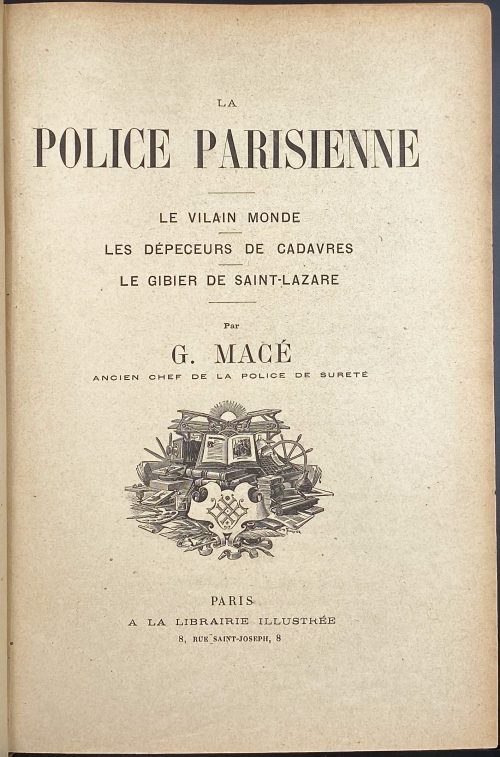 Gustave Macé. La Police parisienne. Le vilain monde. Les dépeceurs de cadavres. Gibier de Saint-Lazare — Paris: Librairie illustrée, [1889]. Title-page: LA | POLICE PARISIENNE |—| LE VILAIN MONDE |—| LES DEPECEURS DE CADAVRES |—| GIBIER DE SAINT-LAZARE |—| Par | G. MACE | ANCIEN CHEF DE LA POLICE DE SURETÉ | {publisher’s device} | PARIS | LIBRAIRIE ILLUSTRÉE | 8, RUE SAINT-JOSEPH, 8 || Description: Hardcover, 4to, 28 x 20 cm, quarter green calf over green marbled boards, raised bands, gilt lettering and gilt fillets to spine, marbled endpapers. Collation:1st bank, [π2 h.t., t.p.], [1]-1074 [108]2 table, last blank; total 432 leaves; 107 woodcuts by Puyplat after E. Mas (on the recto of the first leaf of each complete gathering). Pagination: [4] [1-3] 4-859 [860]; total 864 pp. Edition: Later edition, probably 1889; the 1st edition was published in 1885. Contributors: Gustave Macé (French, 1835 – 1904) – author. Émile Mas (French, 1866 – 1950) – artist. Jules Jacques Puyplat (French, fl. c. 1877 – 1893) – engraver.
Gustave Macé. La Police parisienne. Le vilain monde. Les dépeceurs de cadavres. Gibier de Saint-Lazare — Paris: Librairie illustrée, [1889]. Title-page: LA | POLICE PARISIENNE |—| LE VILAIN MONDE |—| LES DEPECEURS DE CADAVRES |—| GIBIER DE SAINT-LAZARE |—| Par | G. MACE | ANCIEN CHEF DE LA POLICE DE SURETÉ | {publisher’s device} | PARIS | LIBRAIRIE ILLUSTRÉE | 8, RUE SAINT-JOSEPH, 8 || Description: Hardcover, 4to, 28 x 20 cm, quarter green calf over green marbled boards, raised bands, gilt lettering and gilt fillets to spine, marbled endpapers. Collation:1st bank, [π2 h.t., t.p.], [1]-1074 [108]2 table, last blank; total 432 leaves; 107 woodcuts by Puyplat after E. Mas (on the recto of the first leaf of each complete gathering). Pagination: [4] [1-3] 4-859 [860]; total 864 pp. Edition: Later edition, probably 1889; the 1st edition was published in 1885. Contributors: Gustave Macé (French, 1835 – 1904) – author. Émile Mas (French, 1866 – 1950) – artist. Jules Jacques Puyplat (French, fl. c. 1877 – 1893) – engraver. -
 Iron tsuba of round form pierced with the design of slanting rays of light (Christian motif, Jesuit’s IHS symbol) in positive silhouette (ji-sukashi). This design is often called “tokei” [時計], or “clock gear”. Nakaga-ana fitted with copper sekigane. Rounded rim. Unsigned. Higo school. Early Edo period, mid-17th century (1632-1650).
Iron tsuba of round form pierced with the design of slanting rays of light (Christian motif, Jesuit’s IHS symbol) in positive silhouette (ji-sukashi). This design is often called “tokei” [時計], or “clock gear”. Nakaga-ana fitted with copper sekigane. Rounded rim. Unsigned. Higo school. Early Edo period, mid-17th century (1632-1650).Size: 78.3 x 77.0 x 5.3 mm
For information regarding this type of tsuba see the article 'Kirishitan Ikenie Tsuba by Fred Geyer at Kokusai Tosogu Kai; The 2nd International Convention & Exhibition, October 18-23, 2006, pp. 84-91. School and age attribution thanks to Bruce Kirkpatrick. . 
IHS emblem of the Jesuits
-
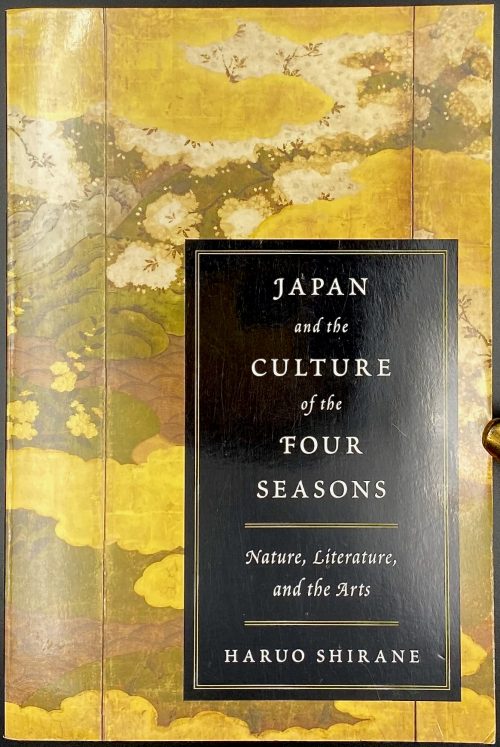 Paperback, 23 x 15.5 cm, pictorial wrappers, pp. [i-xxi] [3] [1] 2-311 [312 blank], total 336 pages. Title-page: Japan | and the | Culture | of the | Four Seasons | Nature, Literature, and the Arts | HARUO SHIRANE | Columbia University Press New York ||
Paperback, 23 x 15.5 cm, pictorial wrappers, pp. [i-xxi] [3] [1] 2-311 [312 blank], total 336 pages. Title-page: Japan | and the | Culture | of the | Four Seasons | Nature, Literature, and the Arts | HARUO SHIRANE | Columbia University Press New York || -
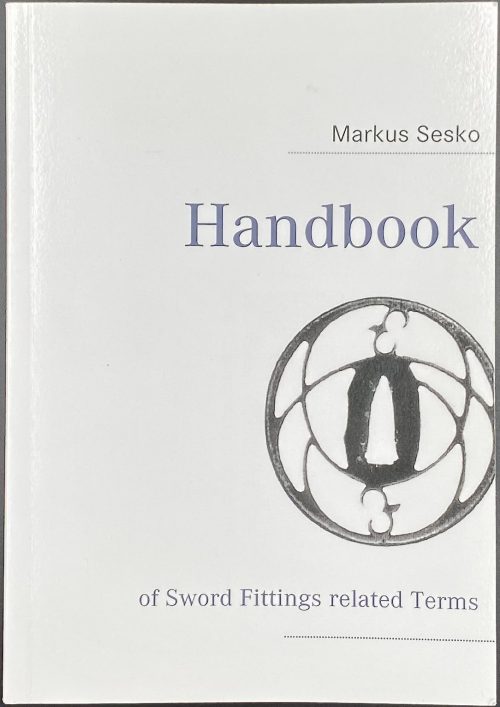 Softcover, 21 x 14.8 cm, print on demand edition, pp.: 1-88 [2], total 90 pages, pp. 1, 2, 88, and 89 blanks, p. 90 colophon. Font cover: Markus Sesko | — | Handbook | {vignette} | of Sword Fittings related Terms | — || Title-page: Handbook | of Sword Fittings | related Terms | © 2011 Markus Sesko | Herstellung und Verlag: | Books on Demand GmbH, Norderstedt | ISBN 978-308423-6422-6 || On the back cover: Blurb, publisher’s device in blue and black, barcode, and web address. Lettering to spine. Printed in the USA.
Softcover, 21 x 14.8 cm, print on demand edition, pp.: 1-88 [2], total 90 pages, pp. 1, 2, 88, and 89 blanks, p. 90 colophon. Font cover: Markus Sesko | — | Handbook | {vignette} | of Sword Fittings related Terms | — || Title-page: Handbook | of Sword Fittings | related Terms | © 2011 Markus Sesko | Herstellung und Verlag: | Books on Demand GmbH, Norderstedt | ISBN 978-308423-6422-6 || On the back cover: Blurb, publisher’s device in blue and black, barcode, and web address. Lettering to spine. Printed in the USA. -
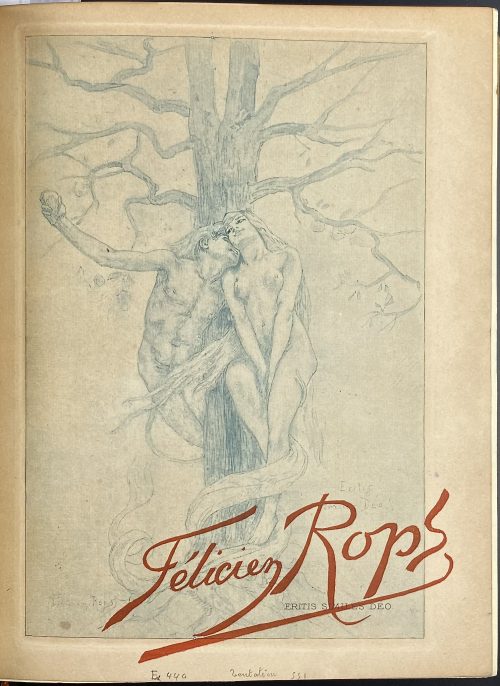 One volume in-4o, 26.5 x 21 x 4.4 cm, bound by Durvand (signed) in yellow ¾ morocco over marbled boards outlined in gilt, spine with raised bands, gilt lettering, vignettes after Félicien Rops in compartments, top margin gilt, marbled endpapers, publisher’s wrappers preserved; enriched with 57 original prints after Félicien Rops and an etched portrait of Félicien Rops by Robert Kastor. Collation: 3 blanks, π4 (orig. front wrapper ‘En souscription…./Etudes sur…’, La tentation…/Érastène Ramiro..., h.t./justification, t.p/blank), 1-274 (paginated 1-215 [216]) χ2 plus 58 leaves of bound-in original prints by various printers on different papers, some on India paper pasted on vergé, with tissue guards, and 1 leave of manuscript ‘Table de gravures dans le texte’; back wrapper with ‘Table des gravures ajoutées’ manuscript to recto, original spine, 2 blanks. Title-page (red and black): Études sur quelques Artistes originaux | — | FÉLICIEN ROPS | par | ÉRASTÈNE RAMIRO | {fleuron} | PARIS | (left): G. PELLET | 51, Rue Le Peletier, 51 | (right): H. FLOURY | 1, Boulevard des Capucines, 1 | 1905 || Limitation: 125 copies, of which 100 copies on Japon à la forme and 25 copies 0n papier de Chine. Photographs here represent the original prints only. Contributors: Eugène Rodrigues-Henriques [Eugène Rodrigues, Erastène Ramiro] (French, 1853 –1928) – author. Félicien Rops (Belgian, 1833 – 1898) – artist. Robert Kastor (French, 1872 – 1935) – artist. Imprimerie Charles Hérissey (Évreux) – printer Gustave Pellet (French, 1859 – 1919) – publisher. Henri Floury (French, 1862 –1961) – publisher. Lucien Durvand (French, 1852 – 1924) – bookbinder.
One volume in-4o, 26.5 x 21 x 4.4 cm, bound by Durvand (signed) in yellow ¾ morocco over marbled boards outlined in gilt, spine with raised bands, gilt lettering, vignettes after Félicien Rops in compartments, top margin gilt, marbled endpapers, publisher’s wrappers preserved; enriched with 57 original prints after Félicien Rops and an etched portrait of Félicien Rops by Robert Kastor. Collation: 3 blanks, π4 (orig. front wrapper ‘En souscription…./Etudes sur…’, La tentation…/Érastène Ramiro..., h.t./justification, t.p/blank), 1-274 (paginated 1-215 [216]) χ2 plus 58 leaves of bound-in original prints by various printers on different papers, some on India paper pasted on vergé, with tissue guards, and 1 leave of manuscript ‘Table de gravures dans le texte’; back wrapper with ‘Table des gravures ajoutées’ manuscript to recto, original spine, 2 blanks. Title-page (red and black): Études sur quelques Artistes originaux | — | FÉLICIEN ROPS | par | ÉRASTÈNE RAMIRO | {fleuron} | PARIS | (left): G. PELLET | 51, Rue Le Peletier, 51 | (right): H. FLOURY | 1, Boulevard des Capucines, 1 | 1905 || Limitation: 125 copies, of which 100 copies on Japon à la forme and 25 copies 0n papier de Chine. Photographs here represent the original prints only. Contributors: Eugène Rodrigues-Henriques [Eugène Rodrigues, Erastène Ramiro] (French, 1853 –1928) – author. Félicien Rops (Belgian, 1833 – 1898) – artist. Robert Kastor (French, 1872 – 1935) – artist. Imprimerie Charles Hérissey (Évreux) – printer Gustave Pellet (French, 1859 – 1919) – publisher. Henri Floury (French, 1862 –1961) – publisher. Lucien Durvand (French, 1852 – 1924) – bookbinder. -
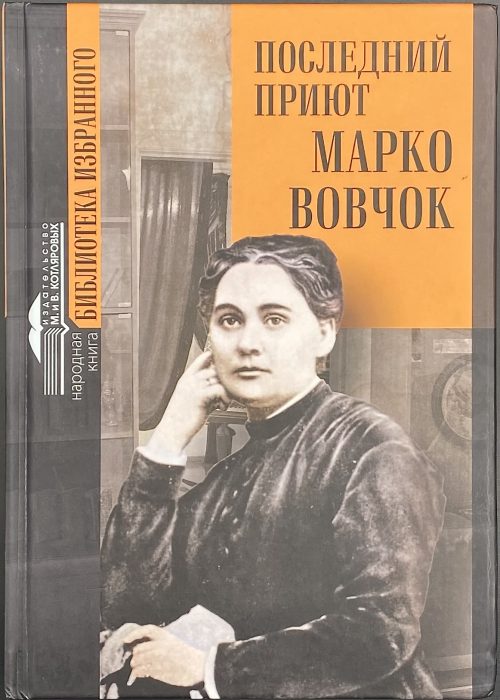 Hardcover volume, 22 x 15.5 cm, pictorial paper boards with black and white lettering to front and spine, a blurb in black on orange to back, pp.: [2] 3-437 [3], 3 ils. Title-page: ПОСЛЕДНИЙ | ПРИЮТ | МАРКО | ВОВЧОК | device {ИЗДАТЕЛЬСТВО | М. И В. КОТЛЯРОВЫХ} | Нальчик 2021 || Print run: 400 copies. Contributors: Марко Вовчок [Марія Олександрівна Вілінська, Marko Vovtchok] (Ukrainian, 1833 – 1907). Лобач-Жученко, Борис Борисович (Russian, 1899 – 1995). Collective: Мария и Виктор Котляровы, Александр Шепелев, Оксана Иваненко, Евгения Тютюнина, Наталья Смирнова, С. Л. Ращенко, Марина Лобач-Жученко.
Hardcover volume, 22 x 15.5 cm, pictorial paper boards with black and white lettering to front and spine, a blurb in black on orange to back, pp.: [2] 3-437 [3], 3 ils. Title-page: ПОСЛЕДНИЙ | ПРИЮТ | МАРКО | ВОВЧОК | device {ИЗДАТЕЛЬСТВО | М. И В. КОТЛЯРОВЫХ} | Нальчик 2021 || Print run: 400 copies. Contributors: Марко Вовчок [Марія Олександрівна Вілінська, Marko Vovtchok] (Ukrainian, 1833 – 1907). Лобач-Жученко, Борис Борисович (Russian, 1899 – 1995). Collective: Мария и Виктор Котляровы, Александр Шепелев, Оксана Иваненко, Евгения Тютюнина, Наталья Смирнова, С. Л. Ращенко, Марина Лобач-Жученко. -
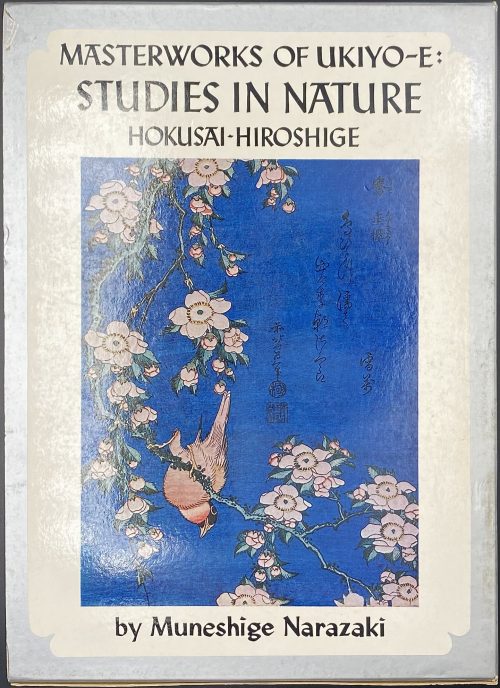 Hardcover volume from the series Masterworks of ukiyo-e, 26.3 x 19.2 cm, bound in unprimed canvas, red characters on black strip to front, red and black lettering to spine, tan flat endpapers, in a pictorial slipcase with series design (black lettering on silver spine); pp: [1-6]: h.t./frontis. (colour plate pasted in), t.p./imprint, contents/acknowledgements), 7-31 text, [32] blank, 33-96 (58 plates w/captions). Title-page (in frame): MASTERWORKS OF UKIYO-E | STUDIES IN NATURE | HOKUSAI-HIROSHIGE | by Muneshige Narazaki | Translated by John Bester | {publisher’s device} | KODANSHA INTERNATIONAL LTD. | Tokyo, Japan & Palo-Alto, Calif., U.S.A | {vertical, between rules 花鳥風月} || 花鳥風月 (Kachou Fugetsu) – beauties of nature. Series: Masterworks of ukiyo-e, № 11. Contributors: Muneshige Narazaki [楢崎 宗重] (Japanese, 1904 – 2001) – author. John Bester (British, 1927 – 2010) – translator. Katsushika Hokusai [葛飾 北斎] (Japanese, 1760 – 1849) – artist. Utagawa Hiroshige [歌川 広重] a.k.a. Andō Hiroshige [安藤 広重] (Japanese, 1797 – 1858) – artist.
Hardcover volume from the series Masterworks of ukiyo-e, 26.3 x 19.2 cm, bound in unprimed canvas, red characters on black strip to front, red and black lettering to spine, tan flat endpapers, in a pictorial slipcase with series design (black lettering on silver spine); pp: [1-6]: h.t./frontis. (colour plate pasted in), t.p./imprint, contents/acknowledgements), 7-31 text, [32] blank, 33-96 (58 plates w/captions). Title-page (in frame): MASTERWORKS OF UKIYO-E | STUDIES IN NATURE | HOKUSAI-HIROSHIGE | by Muneshige Narazaki | Translated by John Bester | {publisher’s device} | KODANSHA INTERNATIONAL LTD. | Tokyo, Japan & Palo-Alto, Calif., U.S.A | {vertical, between rules 花鳥風月} || 花鳥風月 (Kachou Fugetsu) – beauties of nature. Series: Masterworks of ukiyo-e, № 11. Contributors: Muneshige Narazaki [楢崎 宗重] (Japanese, 1904 – 2001) – author. John Bester (British, 1927 – 2010) – translator. Katsushika Hokusai [葛飾 北斎] (Japanese, 1760 – 1849) – artist. Utagawa Hiroshige [歌川 広重] a.k.a. Andō Hiroshige [安藤 広重] (Japanese, 1797 – 1858) – artist. -
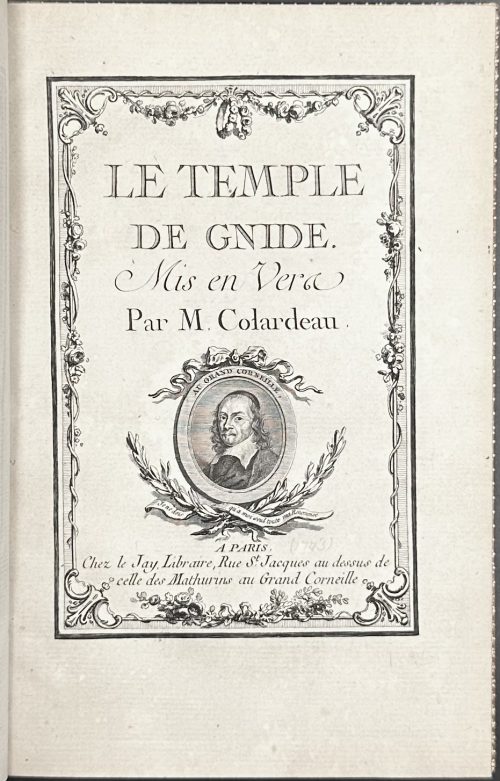 Hardcover volume, 8vo, 21.5 x 14.5 cm, bound by Riviere & Son (stamped on fep verso bottom) in full brown calf, boards with triple gilt fillet border and gilt dentelle inside, spine with raised bands, gilt in compartments, black label with gilt lettering, all margins gilt, blue endpapers, bookplate of Arthur Rau pasted to front pastedown (text: Les hommes sont méchants mais leurs livres sont bons / Arthur Rau; signed: E. H. New – A.D. 1922), traces of removed owner’s label to fep recto; printed on laid paper. Title-page (engraved, in floral frame): LE TEMPLE | DE GNIDE. | Mis en Vers | Par M. Colardeau | {vignette with portrait of Pierre Corneille} | A PARIS | Chez le Jay, Libraire, Rue St. Jacques au dessus de | celle des Mathurins au Grand Corneille || Collation: 2 blanks, h.t., engraved t.p. with a portrait of Pierre Corneille, a8, A-E8 F4 (52 leaves), 2 blanks, plus 7 plates by various engravers after Charles Monnet. Pagination: [i] ii-xvi, [1] 2-88 (104 pp). Ref: MFA (Boston): accession number 37.1747 Catalogue raisonné: Lewine 114, Cohen-DeRicci 245-6. Contributors: Charles Monnet (French, 1732 – after 1808) – artist. Engravers: Jean Charles Baquoy (French, 1721 – 1777) Nicolas Delaunay (French, 1739 – 1792) Isidore Stanislas Helman (French, 1743 – 1806) Louis Joseph Masquelier (French, 1741 – 1811) François Denis Née (French, 1735 – 1818) Nicholas Ponce (French, 1746 – 1831) Portrait(s) designed by: Guillaume Voiriot (French, 1713 – 1799) Author: Charles-Pierre Colardeau (French, 1732 – 1776) Publisher: Edmé-Jean Le Jay (French, 1734 – 1795) Bookplate artist: Edmund Hort New (British, 1871 – 1931) Provenance: Arthur Rau (British, 1898 – 1972); his obituary can be found in The Book Collector 1973, vol. 22, n°1, p. 86-89. According to the genealogy service Geni, Arthur Aron Rau was born to Jacob Aryeh Rau and Katharina (Kaethe) Rau, and has a sister Cecilia (Tsipporah) Rosenfelder and a brother Frederick Solomon Rau. He went to Oxford and then joined Maggs Brothers in their Paris establishment. "After some years there, he set up on his own, returning to England at the outbreak of the Second World War to be a schoolmaster for ten years". In 1949 he returned to Paris and retired in 1963, "and his last years he happily spent in Wensleydale...". All he published during his lifetime were two catalogues, Livres Rares Et Anciens. Manuscrits et Autographes. — Paris: Arthur Rau, 1932-3 and Cinquante Tres Beaux Livres Avec Un Appendice. — Paris: Arthur Rau, 1933. He also contributed to The Book Collector.Seller’s description: In-8° : [2]-t. gr.-xvi-88 pp. ; 7 h.-t. (qqs rouss.). - Poème d'après le roman de Montesquieu ill. de 7 eaux-fortes par Bacquoy, Delaunay, Née, etc., d'après Charles Monnet. Titre gr. orné d'un portr. de Corneille. Cohen, qui cite un ex. millésimé 1773, signale des ex. avec la date de 1772 ou sans date. - Réf. Cohen 245-246. - Conlon 72:675 (éd. à l'adresse d'Amsterdam et Paris, 1772). - Pas dans Reynaud. - Prov. Arthur Rau (1898-1972), gérant de la librairie Maggs à Paris avant d'ouvrir sa propre librairie en 1932 (ex-libris gr. par E.H. New, 1922 ; réf. BnF). - Traces d'ex-libris décollé à la garde sup.
Hardcover volume, 8vo, 21.5 x 14.5 cm, bound by Riviere & Son (stamped on fep verso bottom) in full brown calf, boards with triple gilt fillet border and gilt dentelle inside, spine with raised bands, gilt in compartments, black label with gilt lettering, all margins gilt, blue endpapers, bookplate of Arthur Rau pasted to front pastedown (text: Les hommes sont méchants mais leurs livres sont bons / Arthur Rau; signed: E. H. New – A.D. 1922), traces of removed owner’s label to fep recto; printed on laid paper. Title-page (engraved, in floral frame): LE TEMPLE | DE GNIDE. | Mis en Vers | Par M. Colardeau | {vignette with portrait of Pierre Corneille} | A PARIS | Chez le Jay, Libraire, Rue St. Jacques au dessus de | celle des Mathurins au Grand Corneille || Collation: 2 blanks, h.t., engraved t.p. with a portrait of Pierre Corneille, a8, A-E8 F4 (52 leaves), 2 blanks, plus 7 plates by various engravers after Charles Monnet. Pagination: [i] ii-xvi, [1] 2-88 (104 pp). Ref: MFA (Boston): accession number 37.1747 Catalogue raisonné: Lewine 114, Cohen-DeRicci 245-6. Contributors: Charles Monnet (French, 1732 – after 1808) – artist. Engravers: Jean Charles Baquoy (French, 1721 – 1777) Nicolas Delaunay (French, 1739 – 1792) Isidore Stanislas Helman (French, 1743 – 1806) Louis Joseph Masquelier (French, 1741 – 1811) François Denis Née (French, 1735 – 1818) Nicholas Ponce (French, 1746 – 1831) Portrait(s) designed by: Guillaume Voiriot (French, 1713 – 1799) Author: Charles-Pierre Colardeau (French, 1732 – 1776) Publisher: Edmé-Jean Le Jay (French, 1734 – 1795) Bookplate artist: Edmund Hort New (British, 1871 – 1931) Provenance: Arthur Rau (British, 1898 – 1972); his obituary can be found in The Book Collector 1973, vol. 22, n°1, p. 86-89. According to the genealogy service Geni, Arthur Aron Rau was born to Jacob Aryeh Rau and Katharina (Kaethe) Rau, and has a sister Cecilia (Tsipporah) Rosenfelder and a brother Frederick Solomon Rau. He went to Oxford and then joined Maggs Brothers in their Paris establishment. "After some years there, he set up on his own, returning to England at the outbreak of the Second World War to be a schoolmaster for ten years". In 1949 he returned to Paris and retired in 1963, "and his last years he happily spent in Wensleydale...". All he published during his lifetime were two catalogues, Livres Rares Et Anciens. Manuscrits et Autographes. — Paris: Arthur Rau, 1932-3 and Cinquante Tres Beaux Livres Avec Un Appendice. — Paris: Arthur Rau, 1933. He also contributed to The Book Collector.Seller’s description: In-8° : [2]-t. gr.-xvi-88 pp. ; 7 h.-t. (qqs rouss.). - Poème d'après le roman de Montesquieu ill. de 7 eaux-fortes par Bacquoy, Delaunay, Née, etc., d'après Charles Monnet. Titre gr. orné d'un portr. de Corneille. Cohen, qui cite un ex. millésimé 1773, signale des ex. avec la date de 1772 ou sans date. - Réf. Cohen 245-246. - Conlon 72:675 (éd. à l'adresse d'Amsterdam et Paris, 1772). - Pas dans Reynaud. - Prov. Arthur Rau (1898-1972), gérant de la librairie Maggs à Paris avant d'ouvrir sa propre librairie en 1932 (ex-libris gr. par E.H. New, 1922 ; réf. BnF). - Traces d'ex-libris décollé à la garde sup. -
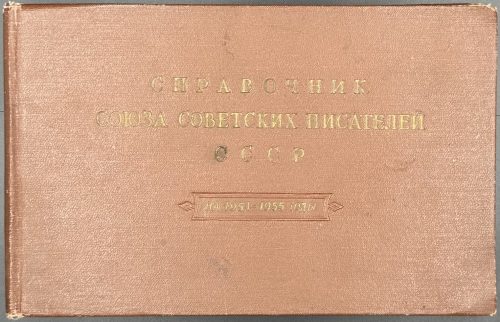 Oblong hardcover volume, 13.3 x 21 cm, bound in brown buckram with embossed gilt lettering to front, pp.: [1-4] 5-482 [2] errata leaf laid in. Title-page: СОЮЗ СОВЕТСКИХ ПИСАТЕЛЕЙ СССР | СПРАВОЧНИК | на 1954 — 1955 годы | ИЗДАТЕЛЬСТВО «Советский писатель» | МОСКВА 1954 || On page 71, second from bottom: Варшавский Сергей Петрович, г. Ленинград, Ропшинская ул., д. 1/32, кв. 18, тел. В 3-56-00. Print run: 3,000 copies.
Oblong hardcover volume, 13.3 x 21 cm, bound in brown buckram with embossed gilt lettering to front, pp.: [1-4] 5-482 [2] errata leaf laid in. Title-page: СОЮЗ СОВЕТСКИХ ПИСАТЕЛЕЙ СССР | СПРАВОЧНИК | на 1954 — 1955 годы | ИЗДАТЕЛЬСТВО «Советский писатель» | МОСКВА 1954 || On page 71, second from bottom: Варшавский Сергей Петрович, г. Ленинград, Ропшинская ул., д. 1/32, кв. 18, тел. В 3-56-00. Print run: 3,000 copies. -
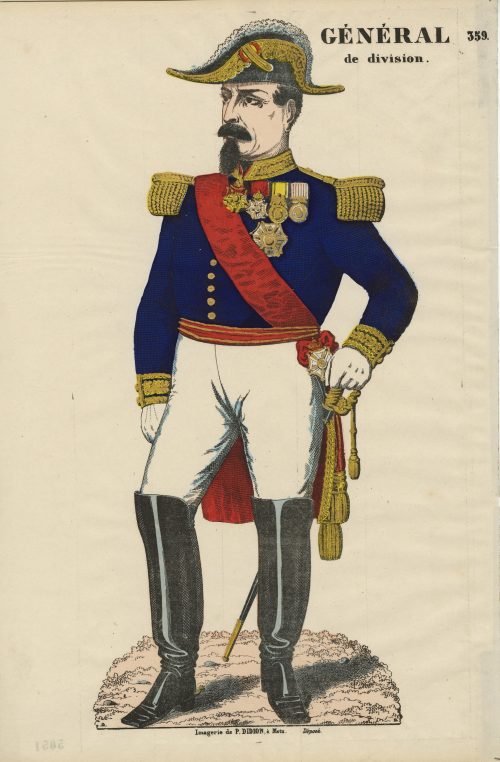 Hand-coloured woodcut on wove paper, 430 x 285 mm; black ink stamp “5051” to reverse. Top right: "GÉNÉRAL | de division." — "359." Bottom: "Imagerie de DIDION, à Metz. Déposé." Paulin Didion (French, 1831 – 1879) – publisher/printer.
Hand-coloured woodcut on wove paper, 430 x 285 mm; black ink stamp “5051” to reverse. Top right: "GÉNÉRAL | de division." — "359." Bottom: "Imagerie de DIDION, à Metz. Déposé." Paulin Didion (French, 1831 – 1879) – publisher/printer. -
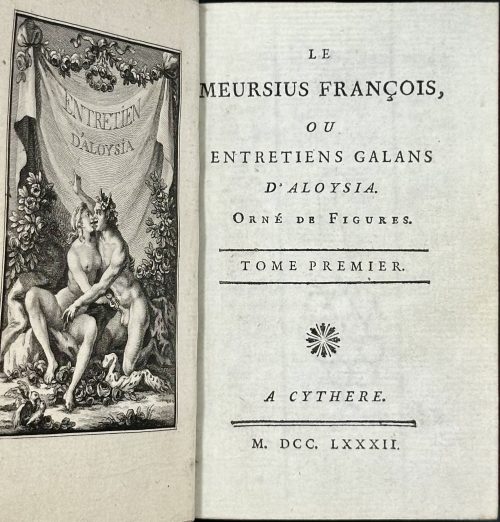 Hardcover volume, 12mo, 125 x 85 mm, two parts in one, bound and gilded by Cuzin and Maillard, respectively, between 1876 and 1881, in crimson crushed morocco with raised bands and gilt lettering to spine, marbled endpapers, all edges gilt, gilt dentelle, signed 'Cuzin' to foot of front turn-in and 'Maillard dor.' to rear. Adorned with engraved frontispiece and 12 plates by Elluin after Borel. Text printed on a slightly bluish paper. Title-page: LE | MEURSIUS FRANÇOIS, | OU | ENTRETIENS GALANS | D'ALOYSIA. | ORNÉ | DE FIGURES. | — | TOME PREMIER (SECOND) | — | ✵ | A CYTHERE | — | M. DCC. LXXXII. || Collation: 12mo, π4 (2 blanks) A-Z6 χ1,+ π2 A-S6 (4 blanks) χ1, total 254 leaves; pagination: [8] [1] 2-277 [278 blank], [4] [1] 2-210 [8 blanks], total 508 pages, plus 13 engraved plates, incl. frontispiece. Catalogue raisonné: Cohen-de Ricci 240; Eros invaincu 17; Fekete 51; Nordmann (I) 91. Contributors: Nicolas Chorier (French, 1612 – 1692) – author. Antoine Borel (French, 1743 – 1810) – artist. François-Rolland Elluin (French, 1745 – c. 1822) – engraver. Hubert-Martin Cazin (French, 1724 – 1795) – publisher. Francisque Cuzin (French, 1836 – 1890) – bookbinder. Seller’s description: Erotica.- [Chorier (Nicolas)]Le Meursius François, ou Entretiens galans d'Aloysia, 2 parts in 1, half-title to each part, engraved frontispiece and 12 plates [by Elluin after Borel], handsomely bound in crimson crushed morocco by Cuzin, spine with gilt lettering and five raised bands, gilt tooled turn-ins by Maillard, signed 'Cuzin' to foot of front turn-in and 'Maillard dor.' to rear, marbled endpapers, g.e., fractional rubbing to extremities, an excellent copy, 12mo, Cythere [but Paris], [Cazin], 1782.
Hardcover volume, 12mo, 125 x 85 mm, two parts in one, bound and gilded by Cuzin and Maillard, respectively, between 1876 and 1881, in crimson crushed morocco with raised bands and gilt lettering to spine, marbled endpapers, all edges gilt, gilt dentelle, signed 'Cuzin' to foot of front turn-in and 'Maillard dor.' to rear. Adorned with engraved frontispiece and 12 plates by Elluin after Borel. Text printed on a slightly bluish paper. Title-page: LE | MEURSIUS FRANÇOIS, | OU | ENTRETIENS GALANS | D'ALOYSIA. | ORNÉ | DE FIGURES. | — | TOME PREMIER (SECOND) | — | ✵ | A CYTHERE | — | M. DCC. LXXXII. || Collation: 12mo, π4 (2 blanks) A-Z6 χ1,+ π2 A-S6 (4 blanks) χ1, total 254 leaves; pagination: [8] [1] 2-277 [278 blank], [4] [1] 2-210 [8 blanks], total 508 pages, plus 13 engraved plates, incl. frontispiece. Catalogue raisonné: Cohen-de Ricci 240; Eros invaincu 17; Fekete 51; Nordmann (I) 91. Contributors: Nicolas Chorier (French, 1612 – 1692) – author. Antoine Borel (French, 1743 – 1810) – artist. François-Rolland Elluin (French, 1745 – c. 1822) – engraver. Hubert-Martin Cazin (French, 1724 – 1795) – publisher. Francisque Cuzin (French, 1836 – 1890) – bookbinder. Seller’s description: Erotica.- [Chorier (Nicolas)]Le Meursius François, ou Entretiens galans d'Aloysia, 2 parts in 1, half-title to each part, engraved frontispiece and 12 plates [by Elluin after Borel], handsomely bound in crimson crushed morocco by Cuzin, spine with gilt lettering and five raised bands, gilt tooled turn-ins by Maillard, signed 'Cuzin' to foot of front turn-in and 'Maillard dor.' to rear, marbled endpapers, g.e., fractional rubbing to extremities, an excellent copy, 12mo, Cythere [but Paris], [Cazin], 1782. -
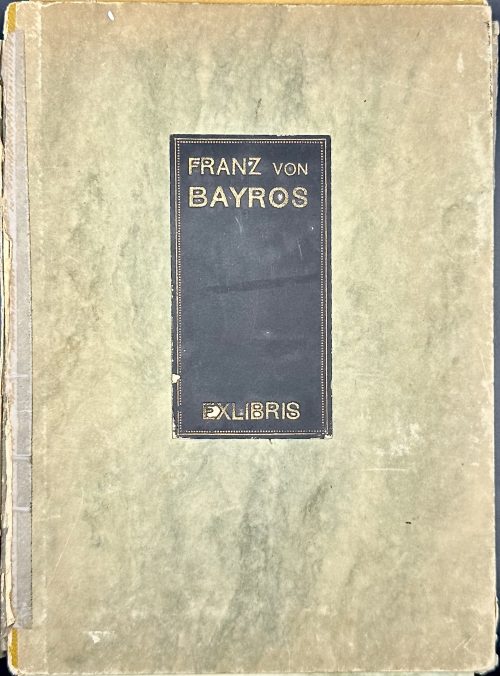 A set of 49 prints, heliogravures and etchings, tipped-in on 285 x 257 mm grey cards, in a green marbled folder with a gilt-lettered black label to the front. No publisher, no place, no year (s.l., s.n., s.d.), printed in circa 1910.
A set of 49 prints, heliogravures and etchings, tipped-in on 285 x 257 mm grey cards, in a green marbled folder with a gilt-lettered black label to the front. No publisher, no place, no year (s.l., s.n., s.d.), printed in circa 1910.- Vlastimil Blažek (Czech, 1878 – 1950): heliogravure, sheet 180 x 137 mm, plate 152 x 114 mm; laid paper, black sepia ink; unsigned.
- Ex libris Gerhard Wunderlich (architect in Dresden): heliogravure, sheet 205 x 150 mm, plate 158 x 115 mm; wove paper, brown sepia ink; inscription: heliogravure, sheet 180 x 137 mm, plate 152 x 114 mm; laid paper, sepia ink; inscription to top “Es ist alles so eng”; signed “F (backwards). Bayros”.
- Ex libris William Lipka: heliogravure, sheet 140 x 125 mm, plate 112 x 98 mm; laid paper, black sepia ink; signature hardly legible.
- Nikolaus Schindler (amateur photographer in Vienna): heliogravure, sheet 142 x 150 mm, plate 110 x 117 mm; laid paper, black sepia ink; unsigned.
- Sussy de Coiquard: heliogravure, sheet 160 x 140 mm, plate 128 x 110 mm; laid paper, black sepia ink; unsigned.
- Illegible, looks like “Vielluer Febréy”: heliogravure, sheet 120 x 109 mm, plate 93 x 85 mm; laid paper, black, sepia ink; signed “F (backwards). Bayros:”.
- Ex libris Erich Liebermann-Rosswiese (Greman-Jewish, 1886 – 1942): heliogravure, sheet 180 x 139 mm, plate 118 x 88 mm; wove paper, black sepia ink; unsigned.
- Ex libris Dr. phil. Rudolf Ludwig: before letters, heliogravure, sheet 150 x 132 mm, plate 120 x 110 mm; laid paper, black sepia ink; unsigned. See [LIB-3258.2023] John Cleland. Die Memoiren der Fanny Hill. — Paphos [i.e. Vienna]: C. W. Stern, 1906.
- Unidentified: before letters, heliogravure, sheet 150 x 115 mm, plate 113 x 88 mm; laid paper, black sepia ink; signed “F. Bayros” in the manuscript. Circumstantial evidence tells that this bookplate belongs to someone A.W.(Artur Wolf). See №22.
- Lulu. Monachia. Gest. v. Ritter Dialekt und Junker Erich: heliogravure, sheet 204 x 152 mm, plate 160 x 118 mm; wove paper, black sepia ink; unsigned. See №20.
- Kellner Jstván: (István): heliogravure, sheet 118 x 100 mm, plate 85 x 70 mm; laid paper, black sepia ink; signed “Franz Bayros” in the script (hardly legible).
- Adyton: heliogravure, sheet 170 x 130 mm, plate 113 x 85 mm; wove paper, black, sepia ink; signed “F (backwards). Bayros”.
- 13.Ex libris George Arthur Buhl (American, 1883 – 1959): heliogravure, sheet 166 x 140 mm, plate 120 x 92 mm; wove paper, black sepia ink; inscription “!I will! | !And I can!”; bust inscribed “T. Carlyle”; signed “F (backwards). Bayros” (hardly legible).
- Ex-Libris Heinrich und Lise Fuhrmann: heliogravure, sheet 165 x 149 mm, plate 120 x 103 mm; wove paper, black sepia ink; signed “F (backward). Bayros”; inscription “So schaff ich am sausenden Webstuhl der Zeit und wirke der Gottheit lebendiges Kleid” (from ‘Faust’ by Goethe).
- Ex libris Gerhard Wunderlich (architect in Dresden): heliogravure, sheet 165 x 137 mm, plate 135 x 105 mm; laid paper, black, sepia ink; signed “F (backwards). Bayros”.
- Ex Libris Walther u. Amelia Fahrenhorst; Walter Fahrenhorst (German, 1871 – 1938): heliogravure, sheet 165 x 140 mm, plate 128 x 95 mm; wove paper, black sepia ink; signed “F. Bayros” in the manuscript. The inscription behind the strings: NITOR (lat. beauty, glamour).
- Ex Libris Margot Lewknecht; heliogravure, sheet 145 x 140 mm, plate 128 x 118 mm; laid paper, black sepia ink; signed “F. Bayros”.
- Ex Libris Walther Heinisch (publisher in Carlsbad); heliogravure, sheet 185 x 145 mm, plate 140 x 110 mm; wove paper, sanguine; male bust with an inscription to the base: “Arnold Boeklin” / Arnold Böcklin (Swiss, 1827 – 1901); inscription: “mit gêru scal man geba infâhan” – a line from Hildebrandslied, the earliest poetic text in German. Unsigned.
- Bookplate with music score GGDBGC; heliogravure, sheet 125 x 135 mm, plate 100 x 110 mm, with monogram «HCJ»; laid paper, brown sepia ink; signed “F. Bayros”.
- Bookplate with inscription: Lulu aus Praga | Gest v. Ritter Dialekt / Monachia / Monachia / und Junker Erich; heliogravure, sheet 182 x 147 mm, plate 160 x 120 mm, image 122 x 105 mm; wove paper, bluish-black sepia ink; unsigned. See №10.
- Bookplate, no inscription; heliogravure, laid paper, sepia ink, sheet 148 x 127 mm, image 84 x 79 mm; signed F. Bayros in the manuscript beneath the image.
- Ex libris Artur Wolf: heliogravure, laid paper, sepia ink, sheet 170 x 150 mm, image 120 x 105 mm; signed F. Bayros in the manuscript to the frame of the image. See №9.
- Ex Libris E. K. Weigl: heliogravure, laid paper, sepia ink, sheet 139 x 121 mm, plate 112 x 97 mm; unsigned; inscription above male portrait: “LEONARDO”.
- Ex libris Dr. A. Bergmann: heliogravure, wove paper, sepia ink; sheet 180 x 140 mm, plate 130 x 105 mm; signed F. Bayros in the manuscript.
- Grete Cäcilie (monogram “PS”): heliogravure, laid paper, sepia ink, sheet 161 x 130 mm, plate 128 x 103 mm, signature illegible.
- Emma Steigleder: heliogravure, laid paper, black ink, sheet 181 x 141 mm, plate 158 x 117 mm, signed F. Bayros in the manuscript. Inscription “Si vis amari, ama! Seneca” [If you want to be loved, love] to the attic of the arch.
- Bruno Fischer: heliogravure, laid paper, sepia ink, sheet 186 x 145 mm, plate 155 x 116 mm, signed “F (backward). Bayros”. Inscription to bottom “Gehl Weck’ ihn nicht auf seien wir froh dass er einmal schläft!”
- Harnasch: heliogravure, wove paper, sepia ink; unsigned; sheet 140 x 132 mm, plate 100 x 85 mm; unsigned.
- Eduard Klampfl: heliogravure, laid paper, sepia ink, sheet 165 x 145 mm, plate 135 x 110 mm, signed “F (backwards). Bayros”; portrait bust of the composer Richard Wagner (German, 1813 –1883).
- Jorge Monsalvatje: heliogravure, wove paper, sepia ink; sheet 189 x 160 mm, plate 150 x 115 mm; signed F. Bayros in the manuscript.
- E. K. W.: wove paper, sepia ink; sheet 150 x 120 mm; signed “Bayros”.
- Unidentified bookplate: wove paper, sepia ink; sheet 150 x 120 mm; signed “F. Bayros 09” in the manuscript.
- Ex-Libris Helene and Emil Lemberger: heliogravure (or soft ground etching), laid paper, sepia ink, sheet 180 x 163 mm, plate 150 x 130 mm, signed “F. Bayros” in the manuscript.
- M. Z.: wove paper, sepia ink; sheet 130 x 170 mm, plate 90 x 120 mm; signed “F (backwards) Bayros”.
- Ex libris Frankl Frigyes Vilmos: heliogravure (or soft ground etching), laid paper, sepia ink, sheet 140 x 148 mm, unsigned. Frigyes Frankl, born in Tejfalu, Szlovákia, died in 1943.
- Ex libris Anton Bürck: heliogravure, wove paper, sepia ink; sheet 170 x 137 mm, plate 123 x 104 mm; unsigned. Anton Burck (German,1881 – 1951) of Palatinate, Bavaria.
- Aus den büchern A. W.: heliogravure, laid paper, sepia ink, sheet 152 x 136 mm, plate 120 x 105 mm, signed “F. Bayros” in the manuscript.
- Ex libris Hans Hickl: heliogravure, laid paper, sepia ink, sheet 150 x 125 mm, plate 115 x 95 mm, signed “Ω”.
- Ex libris Karl Wehle: soft ground etching, laid paper, brown sepia ink, sheet 107 x 90 mm, plate 80 x 65 mm, inscription “Gut!” in the centre; unsigned. Karl Wehle (Austrian, 1901 – 1933)
- Ex libris Dr. Paul Berger: etching, laid paper, black ink, sheet 140 x 115 mm, plate 115 x 85 mm, signed “F (backwards). Bayros”.
- Unidentified bookplate: etching, laid paper, black ink, sheet 145 x 115 mm, plate 85 x 70 mm, unsigned.
- Ex Bibliotheca Erotica Carl Georg von Maassen: soft ground etching, india paper, black ink, sheet 76 x 78 mm, signed “FB”.
- Ex Bibliotheca Erotica Carl Georg von Maassen: soft ground etching, india paper, black ink, sheet 79 x 79 mm, signed “F. von Bayros”.
- Paul Mixa: soft ground etching, laid paper, sanguine ink, sheet 122 x 111 mm, plate 90 x 85 mm, inscription: “Gerne hör’ich wenn du singest und ich horche wenn du schweigest” [I like to hear when you sing and I listen when you are silent].
- Ex libris Drs Q. M. Vyskocil.: etching, laid paper, sanguine ink, sheet 141 x 115 mm, plate 115 x 75 mm, inscription: “MIT REINEN HAENDEN” [with pure hands], signed “F. Bayros” in the manuscript.
- Ex libris Andrée Bearn de Riquer: soft ground etching, laid paper, sanguine ink, sheet 136 x 88 mm, plate 100 x 62 mm, signed “F (backwards). Bayros”. Andrée Béarn [Marguerite Laborde] (French, 1880 – 1973), spouse of Alexandre de Riquer (Catalan, 1856 – 1920).
- Ex musicis Drs Blažek VL: etching, wove paper, sanguine ink, sheet 141 x 116 mm, plate 115 x 90 mm, inscription: “MIT REINEN HAENDEN” [with pure hands], signed “F. Bayros” in the manuscript. See Vlastimil Blažek (Czech, 1878 – 1950) № 1 in this series.
- Ex libris Paul Lindenberg: etching, wove paper, sanguine ink, sheet 130 x 114 mm, plate 95 x 90 mm, image 80 x 72 mm, inscription: “ad pios usus” (for pious uses); signed with monogram “F (backwards). B”.
- Unidentified bookplate: heliogravure, laid paper, sanguine ink, sheet 150 x 131 mm, plate 120 x 100 mm, signed “F. Bayros” in the manuscript.
-
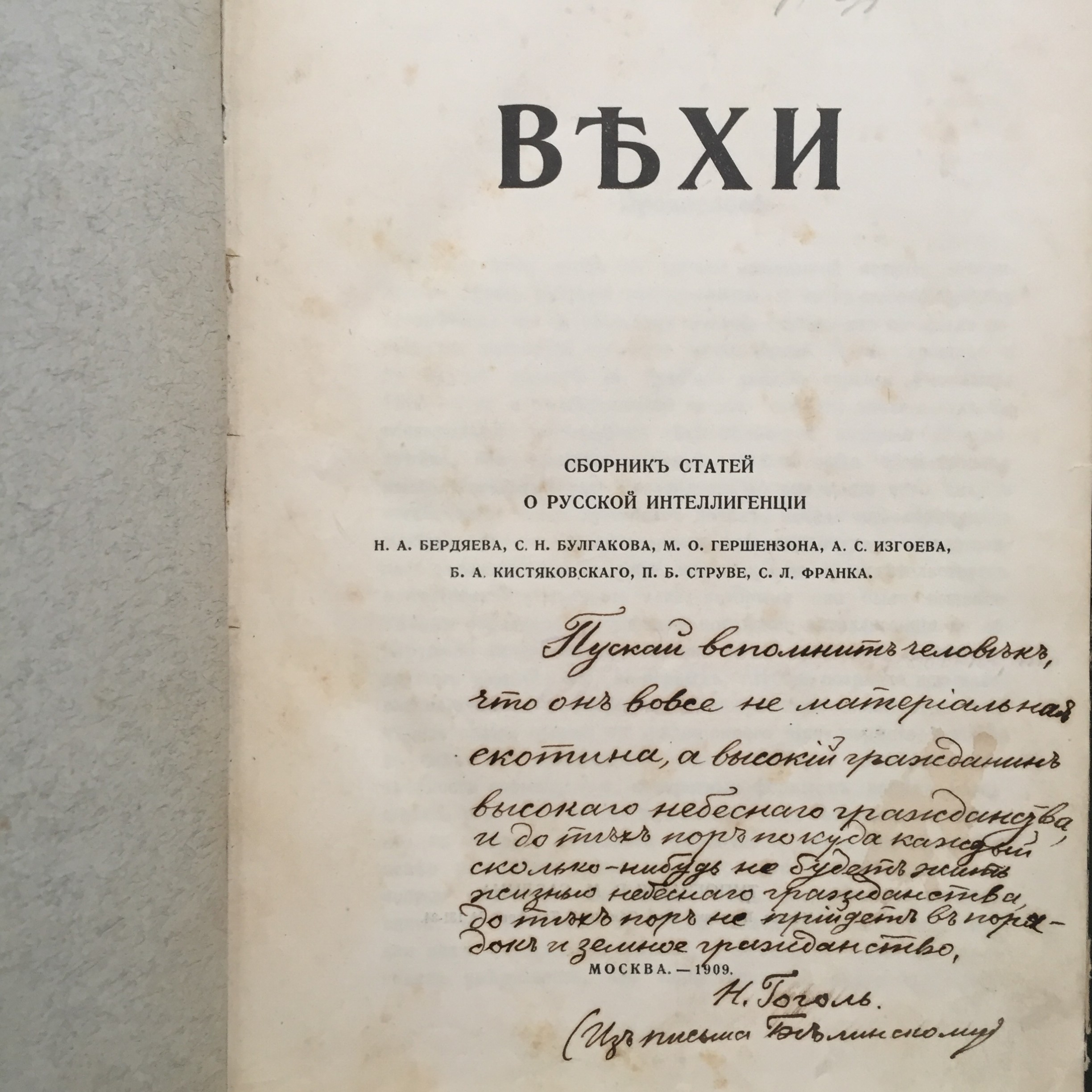
Вехи. Сборник статей о русской интеллигенции. Москва, 1909. Типография В. М. Саблина.
Предисловие. М. О. Гершензон. Н. А. Бердяев. Философская истина и интеллигентская правда. С. Н. Булгаков. Героизм и подвижничество. М. О. Гершензон. Творческое самосознание. Б. А. Кистяковский. В защиту права. П. Б. Струве. Интеллигенция и революция. С. Л. Франк. Этика нигилизма. А. С. Изгоев. Об интеллигентной молодежи. -

Fuchi-kashira made of shakudō carved and inlaid with gold and red copper with the design of a bat and a fruit (persimmon?). Nanako surface.
Fuchi: 37 x 19 x 7 mm. Kashira: 34 x 16 x 5 mm. Main material: shakudō. Other metals: gold and copper. Surface treatment: nanako-ji. -
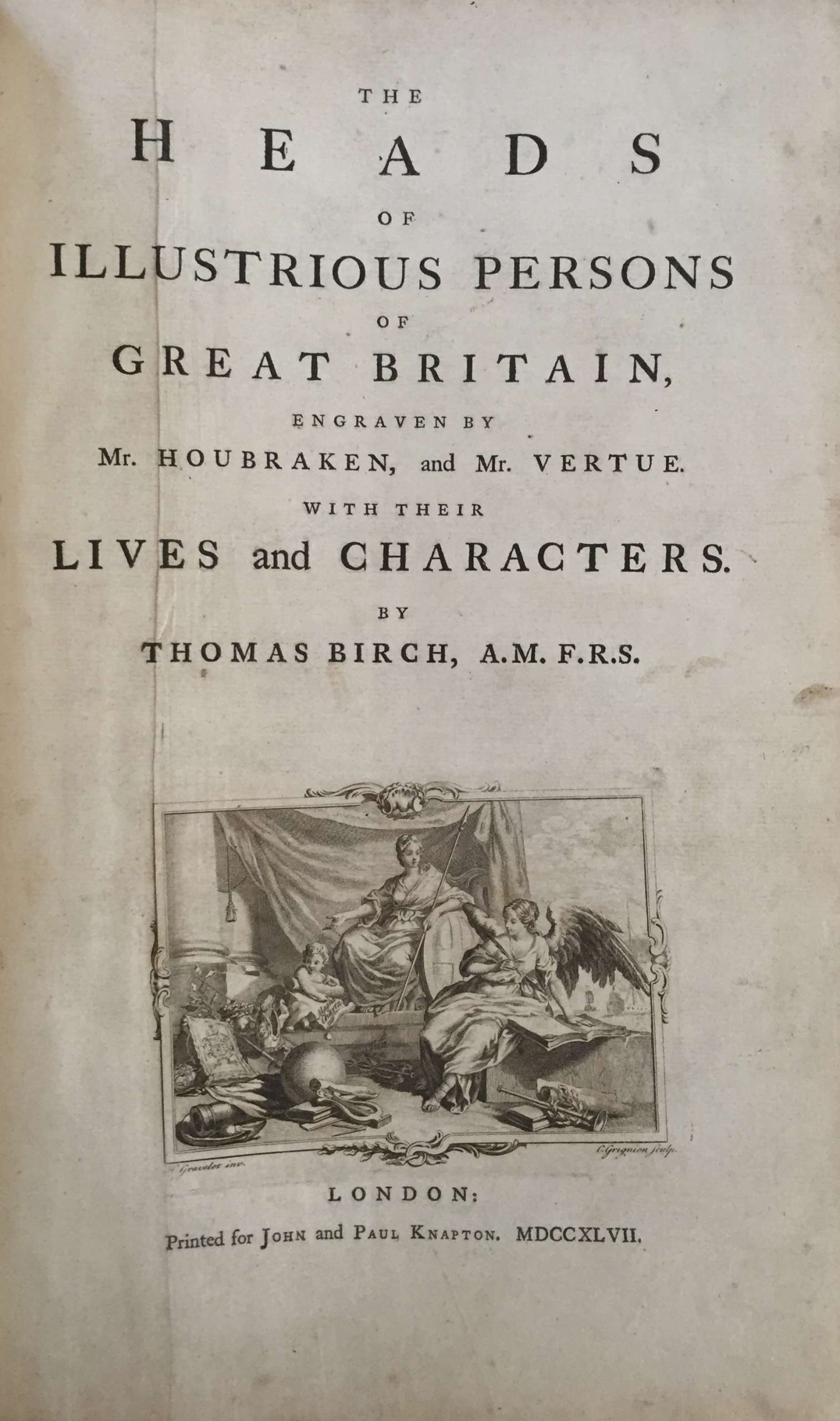
The Heads of Illustrious Persons of Great Britain Engraven By Mr. Houbraken And Mr. Vertue. With Their Lives And Characters by Thomas Birch, A.M.F.R.S. Two Volumes in One. Published for John and Paul Knapton, London, 1747. 108 engraved portraits.
-
 Iron tsuba of round form with design of triple diamond (matsukawa-bishi) in openwork (sukashi). Square rim. Ko-Tosho school. Nanbokucho period: Late 14th century (Oan/Eiwa era). Height: 92.3 mm. Width: 92.3 mm. Rim thickness: 2.5 mm. Center thickness: 3.0 mm. Provenance: Sasano Masayuki Collection, № 15: "Two small lozenges are attached to each end of a larger lozenge. Most Ko-tosho tsuba have inspirational designs, however this has a rather casual appearance, although it represents the unstable political situation at the time".
Iron tsuba of round form with design of triple diamond (matsukawa-bishi) in openwork (sukashi). Square rim. Ko-Tosho school. Nanbokucho period: Late 14th century (Oan/Eiwa era). Height: 92.3 mm. Width: 92.3 mm. Rim thickness: 2.5 mm. Center thickness: 3.0 mm. Provenance: Sasano Masayuki Collection, № 15: "Two small lozenges are attached to each end of a larger lozenge. Most Ko-tosho tsuba have inspirational designs, however this has a rather casual appearance, although it represents the unstable political situation at the time". -
 Iron tsuba of round form with design of rabbit (usagi) in openwork (sukashi) and inlaid with designs of plants and family crests (mon) in suemon-zōgan. A branch with lonely leaf, half chrysanthemum, and flying wild geese on the face represent autumnal connotations. The same motif is complemented by a clove (choji) on the reverse. The family crests (mon) include: interlocked rings (kanawa; wachigai), three encircled lines or stripes (hikiryo), bit or muzzle (kutsuwa - horse's harness element with possible christian symbolism), and encircled triangle (uroko, fish scale). Brass wire trim around the openwork elements and the seppa-dai, scalloped wire inlay around the hitsu-ana. Iron is dark, almost black. Brass or copper elements vary in shades of lighter and darker yellow with red-ish hue. Ōnin school. Late Muromachi period, 16th century. Height: 89.6 mm; Width: 89.3 mm; Thickness at seppa-dai: 3.0 mm. Weight: 129.7 g.
Iron tsuba of round form with design of rabbit (usagi) in openwork (sukashi) and inlaid with designs of plants and family crests (mon) in suemon-zōgan. A branch with lonely leaf, half chrysanthemum, and flying wild geese on the face represent autumnal connotations. The same motif is complemented by a clove (choji) on the reverse. The family crests (mon) include: interlocked rings (kanawa; wachigai), three encircled lines or stripes (hikiryo), bit or muzzle (kutsuwa - horse's harness element with possible christian symbolism), and encircled triangle (uroko, fish scale). Brass wire trim around the openwork elements and the seppa-dai, scalloped wire inlay around the hitsu-ana. Iron is dark, almost black. Brass or copper elements vary in shades of lighter and darker yellow with red-ish hue. Ōnin school. Late Muromachi period, 16th century. Height: 89.6 mm; Width: 89.3 mm; Thickness at seppa-dai: 3.0 mm. Weight: 129.7 g. -
 Richard Parkes Bonington (1802–1828 ). British/French. Evreux: Tour du Gros Horloge (Evreux: Large Clock Tower). Inscription: The tower was built in 1417 when the area was ruled by England. Lithograph. From the Taylor and Nodier set "Normandie", Vol. II, pl. 226. 1824. MET# 22.87.2. Catalogue Raisonné: Curtis 1939, no. 19. MET description: "This view in the French town of Evreux focuses on the clock tower, with vendors and customers in the street below. Bonington produced the print for the multi-volume series directed by Baron Isidore Taylor, Charles Nodier and Alphonse de Cailleux titled "Voyages Pittoresques et Romantiques dans l'Ancienne France" (Picturesque and Romantic Travels through Historic France). This image appears in volume 2, devoted to Normandy."
Richard Parkes Bonington (1802–1828 ). British/French. Evreux: Tour du Gros Horloge (Evreux: Large Clock Tower). Inscription: The tower was built in 1417 when the area was ruled by England. Lithograph. From the Taylor and Nodier set "Normandie", Vol. II, pl. 226. 1824. MET# 22.87.2. Catalogue Raisonné: Curtis 1939, no. 19. MET description: "This view in the French town of Evreux focuses on the clock tower, with vendors and customers in the street below. Bonington produced the print for the multi-volume series directed by Baron Isidore Taylor, Charles Nodier and Alphonse de Cailleux titled "Voyages Pittoresques et Romantiques dans l'Ancienne France" (Picturesque and Romantic Travels through Historic France). This image appears in volume 2, devoted to Normandy."


